It seems we can’t find what you’re looking for. Perhaps searching can help.
Sign Up for newsletter!
Subscribe to get the latest eBook!
Hotline






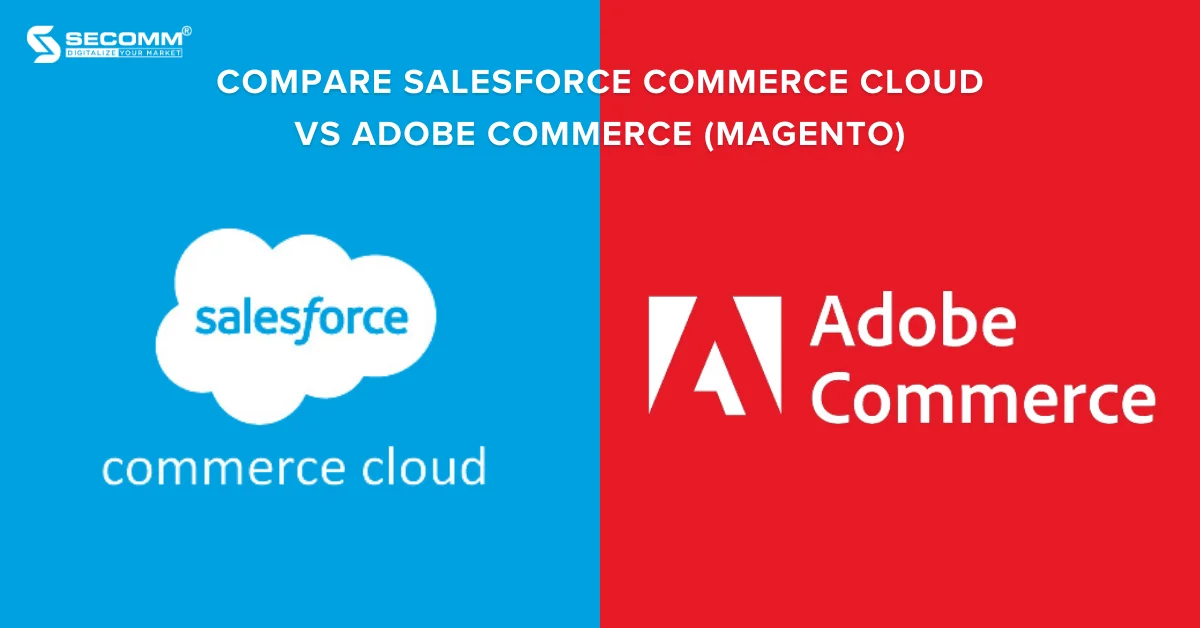
Salesforce Commerce Cloud and Adobe Commerce (Magento) are two leading platforms in the field of eCommerce, trusted by many large enterprises. However, both of these platforms have significant differences.
Let’s explore the important aspects of both with SECOMM to help businesses decide which platform is suitable for the brand’s business needs.
Salesforce Commerce Cloud, formerly known as Demandware, is a cloud-based eCommerce platform. Salesforce Commerce Cloud operates on the SaaS (Software-as-a-Service) model, providing high scalability and a range of features and capabilities to help businesses create a seamless and effective shopping experience for their customers.
Within Salesforce Commerce Cloud, there are three main editions for building eCommerce websites: Salesforce B2C Commerce, Salesforce B2B Commerce, and most recently, Salesforce B2B2C Commerce.
In the B2C model, there are three solution packages:

Similarly, the B2B model is also divided into 2 solution packages, including:
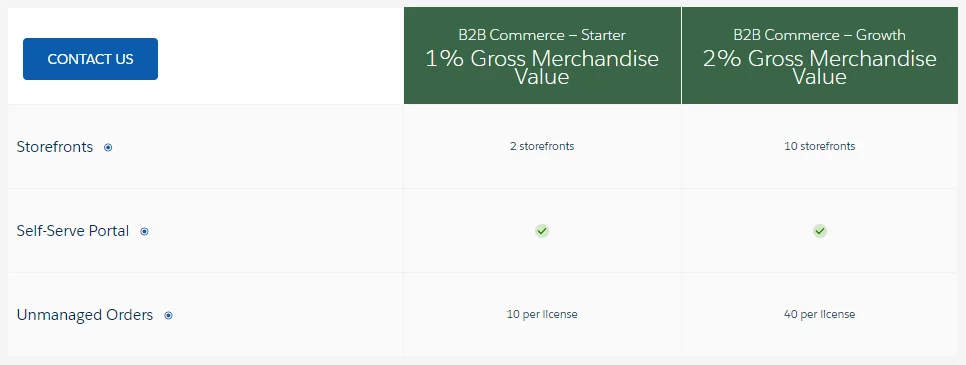
For the B2B2C model, it will be calculated based on 1% Gross Merchandise Value (GMV).
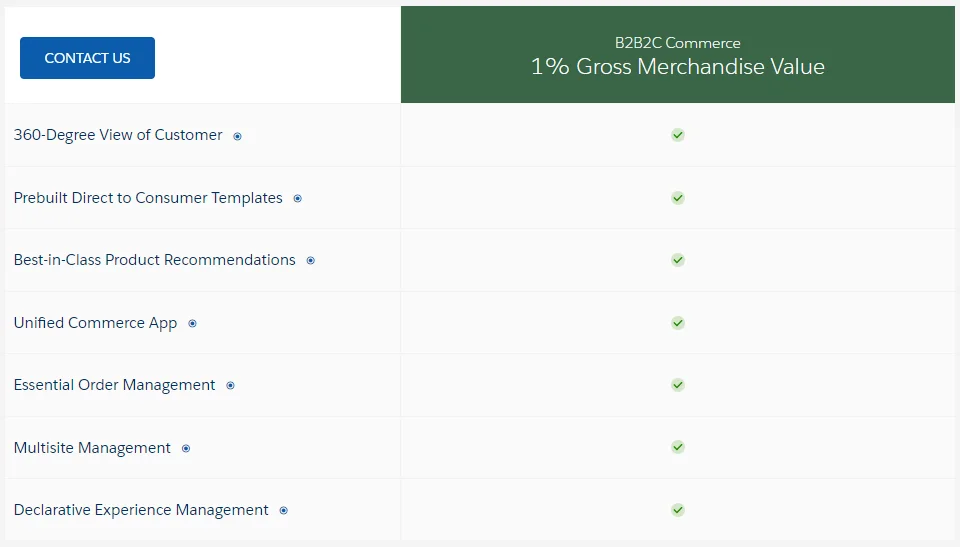
Related article: Top 10 Websites Built On Salesforce Commerce Cloud
Adobe Commerce (formerly known as Magento) is an open-source eCommerce platform designed under the PaaS (Platform-as-a-Service) model, assisting businesses in constructing professional eCommerce websites.
Adobe Commerce can be categorized into two main types:
Additionally, Adobe Commerce still supports the Magento Open Source version – a free version that can be downloaded and used by anyone.
Related article: Top 20 eCommerce Websites Using Adobe Commerce (Magento)
In summary, Salesforce Commerce Cloud and Adobe Commerce are two leading eCommerce platforms with significant differences.
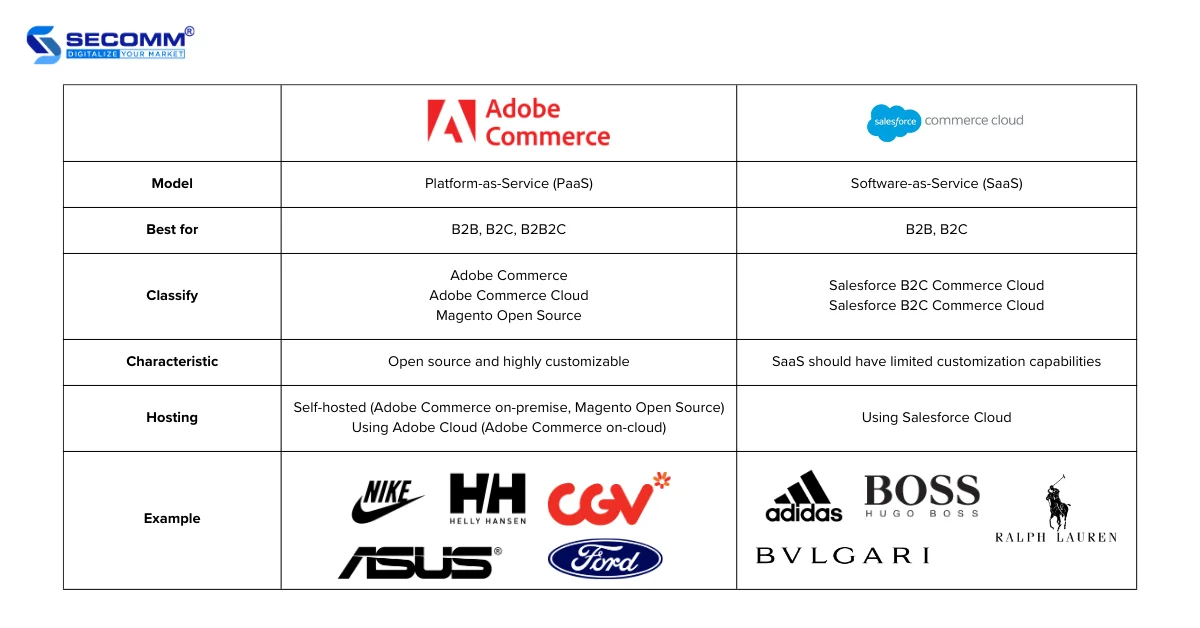
The cost of Salesforce Commerce Cloud depends on various factors but largely hinges on the scale of the business.
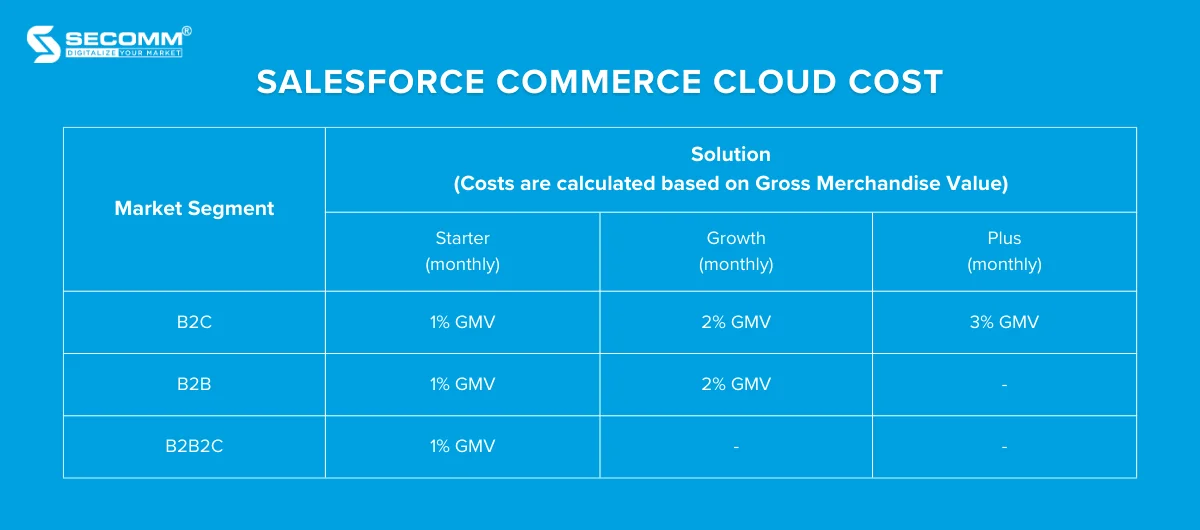
Operating as a SaaS solution, businesses pay a monthly fee based on the number of users and the revenue generated by the website. Costs start from depending on the GMV, averaging around $2,500 per month and can increase to tens of thousands of dollars for larger enterprises.
The cost of Adobe Commerce (Magento) also depends on various factors, including the chosen version and the monthly revenue of the business.
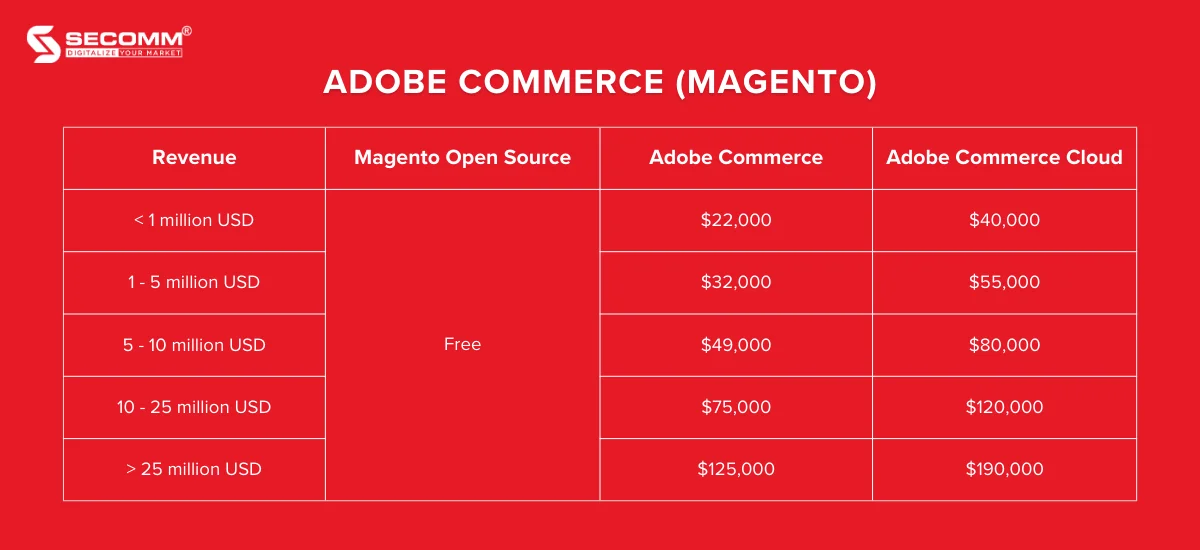
Adobe Commerce is a PaaS solution, meaning businesses must purchase software licenses annually and then pay a monthly fee for hosting and support if needed. License costs start from around $22,000, and hosting costs start from approximately $3,000 per year.
It can be observed that the costs of Salesforce Commerce Cloud and Adobe Commerce (Magento) may vary depending on the business scale, specific requirements, and customization levels.
For instance, for a business with a GMV of $25 million, the platform usage cost for Salesforce Commerce Cloud might be around $250,000/month, whereas for Adobe Commerce Cloud, it could be approximately $120,000/month.
In general, Salesforce Commerce Cloud tends to have higher costs compared to Adobe Commerce.
Related article: The Cost Of Building An Adobe Commerce (Magento) Website
Adobe Commerce (Magento) is built on an open-source architecture, allowing high customization and flexibility. Users can modify a significant amount of source code, making this platform suitable for complex eCommerce needs.
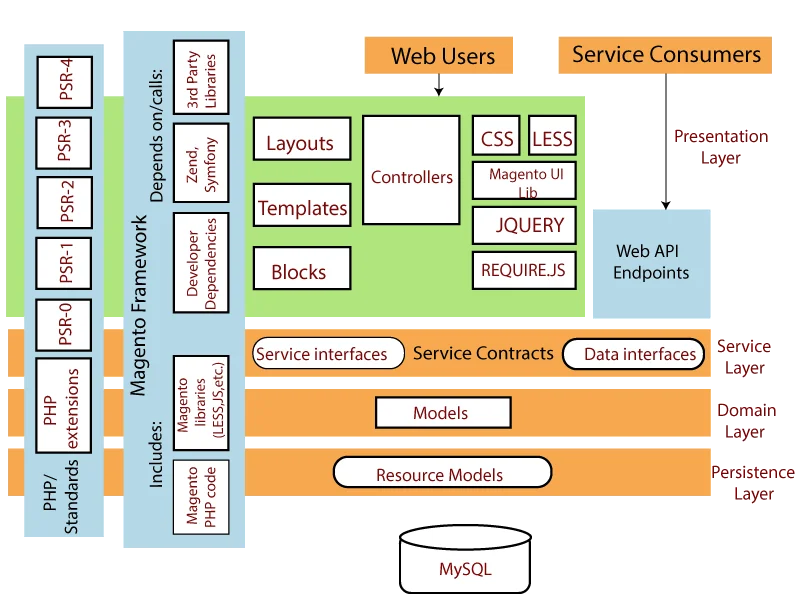
Salesforce Commerce Cloud utilizes a cloud-native, multi-tenant architecture. While this architecture provides significant customization capabilities, it is less flexible for modifying deep code segments compared to open-source architectures like Adobe Commerce (Magento).

Salesforce Commerce Cloud is part of Salesforce, the leading Customer Relationship Management (CRM) platform today. Salesforce is renowned for its CRM services, including sales, customer, and marketing management.
Consequently, Salesforce Commerce Cloud seamlessly integrates with Salesforce CRM, providing a unified platform for managing and interacting with customers. This tight integration can be a significant advantage for companies heavily reliant on Salesforce for customer management.
Additionally, Salesforce Commerce Cloud seamlessly integrates with the Customer 360 ecosystem, including business management software like data, AI, or third-party utilities partnered with Salesforce.

On the other hand, Adobe Commerce Cloud is part of the Adobe Experience Cloud, a comprehensive set of solutions for marketing and customer experience.
Thus, Adobe Commerce Cloud integrates with other Adobe tools to support seamless multi-channel customer experience and marketing.
Some commonly used utilities in Adobe Experience Cloud include:
Moreover, Adobe Commerce Cloud offers various integration options and supports third-party extensions and plugins. This means Adobe Commerce can integrate with a wide range of systems such as CRM, POS, WMS, OMS, ERP, etc.
Salesforce Commerce Cloud and Adobe Commerce (Magento) are two widely used leading eCommerce platforms in the market, partially due to their incredibly powerful and diverse feature sets.
Below is a comparison of features between Salesforce Commerce Cloud and Adobe Commerce:
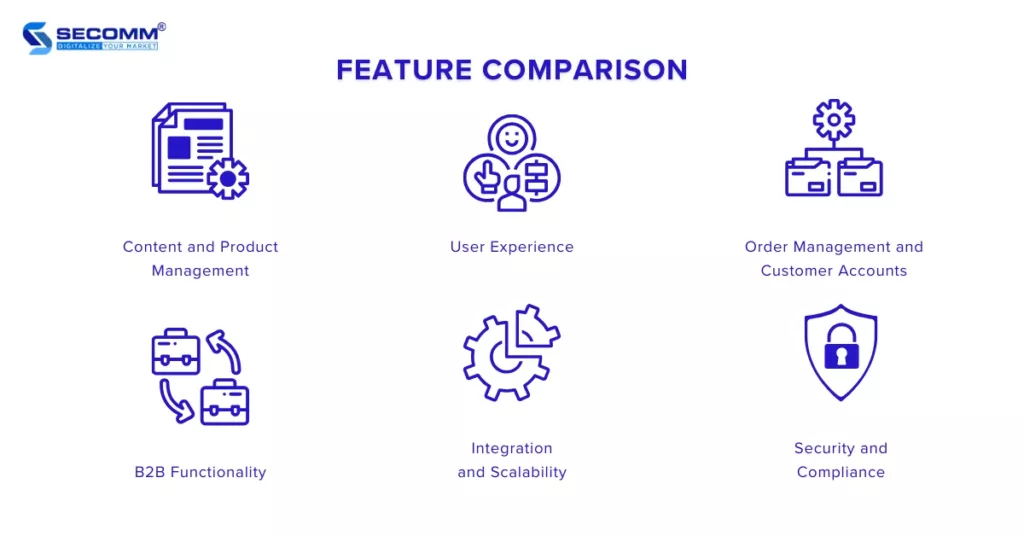
Content and Product Management:
User Experience:
Order Management and Customer Accounts:
B2B Functionality:
Integration and Scalability:
Security and Compliance:
Salesforce Commerce Cloud and Adobe Commerce (Magento) are both powerful eCommerce platforms. However, Salesforce Commerce Cloud is suitable for large enterprises seeking a tightly integrated eCommerce solution with their CRM system.
On the other hand, Adobe Commerce would be a better choice for businesses with high customization needs and a desire for more control over the eCommerce platform.
The selection of the most suitable eCommerce platform for each business will depend heavily on the core needs of the brand.
With deep expertise and the development of complex eCommerce systems for clients such as Changi Airport Group (Singapore), Trentham Estate (Australia), and The Warehouse (Vietnam), SECOMM understands the challenges in choosing a platform and deploying eCommerce that businesses are facing.
Contact SECOMM now or call directly at the hotline number (028 7108 9908) for free advice on the eCommerce website building roadmap!
 2
2
 4,366
4,366
 0
0
 1
1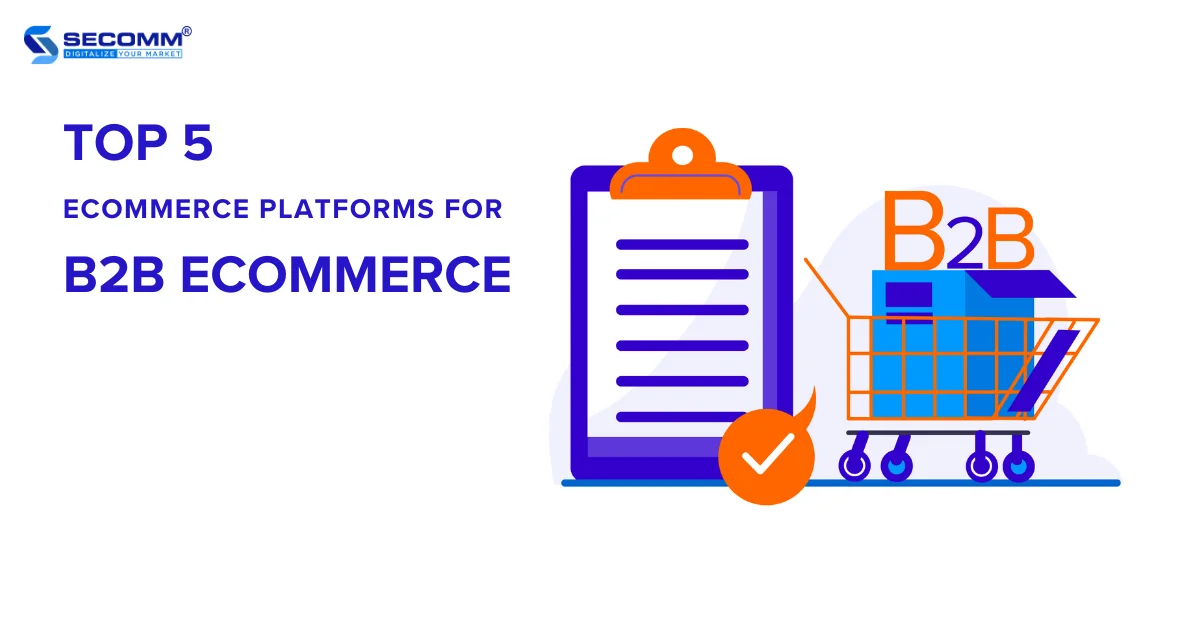
The global B2B eCommerce market is expected to reach $18.771.4 trillion by 2027.
According to McKinsey & Company, B2B enterprises are expanding their touchpoints in eCommerce, with 80% making online channels perform better than offline channels.
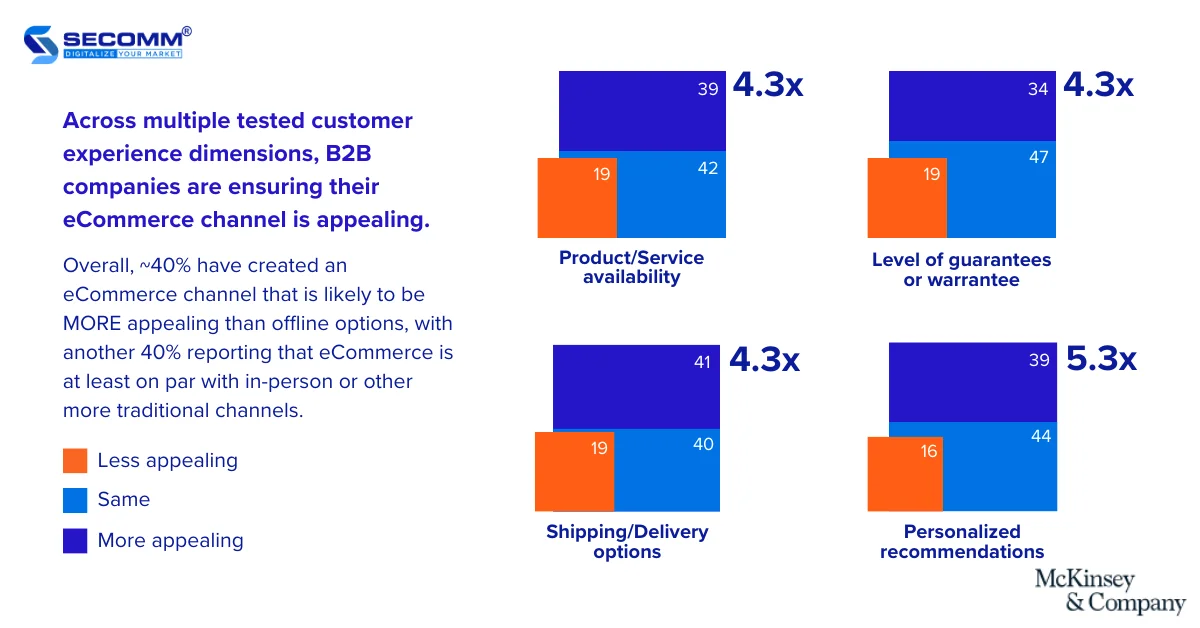
Therefore, B2B eCommerce is a rapidly growing market, with projected sales expected to reach 12.2 trillion USD by 2023. To succeed in this market, businesses always need a robust eCommerce platform.
It is crucial for businesses to clearly define the specificities and considerations of B2B eCommerce before deciding on which eCommerce platform to implement.
Specifically, Business-to-Business (B2B) eCommerce involves commercial transactions between businesses. As a result, B2B eCommerce has distinct characteristics compared to Business-to-Consumer (B2C) eCommerce, namely:
To succeed in B2B eCommerce, businesses need to take note of the following considerations:
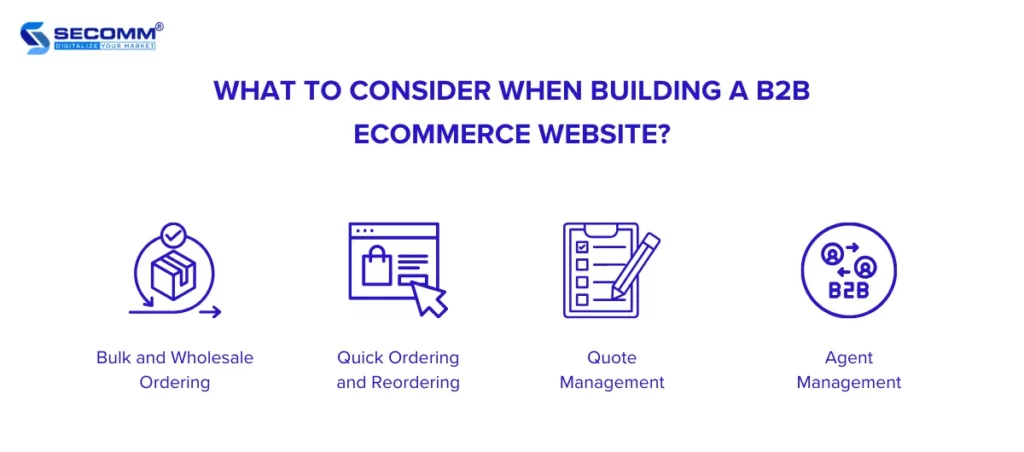
Bulk and wholesale ordering are crucial factors in the revenue of B2B businesses. The quantity and pricing can vary for each business depending on the customer group and the purchased product categories.
To efficiently handle these orders in B2B eCommerce, businesses need to use order management systems and establish clear, detailed, and appropriate order processing workflows.
The feature of quick ordering is often provided by B2B eCommerce platforms, allowing customers to create and place orders with just a few clicks. Quick ordering can be implemented through various methods, such as:
Unlike individual customers, B2B customers often repeat purchases of specific product categories in seasonal quantities. Therefore, B2B businesses should also incorporate a feature to remember previous orders for quick reordering.
Quote management in B2B eCommerce is a crucial process that helps businesses provide accurate and timely pricing information to customers, ultimately increasing sales and improving profits.
Specifically, in quote management, negotiating prices with multiple quote versions or from different suppliers is an important part of many B2B eCommerce models, allowing businesses to negotiate prices for large or complex transactions.
Managing information about agents, such as agent details, agent approval processes, agent hierarchies, credit limits, stock management for each agent, and managing discounts/commissions for agents, is essential.
Additionally, for B2B models involving multiple manufacturers and distributors, there may be a need for additional management of relationships between these entities and agents.
Therefore, depending on the current offline business model and the B2B eCommerce business model that the business aims to establish the most effective agent management process should be detailed.
Below are the top 5 eCommerce platforms for B2B businesses, capable of addressing the specificities of B2B eCommerce.
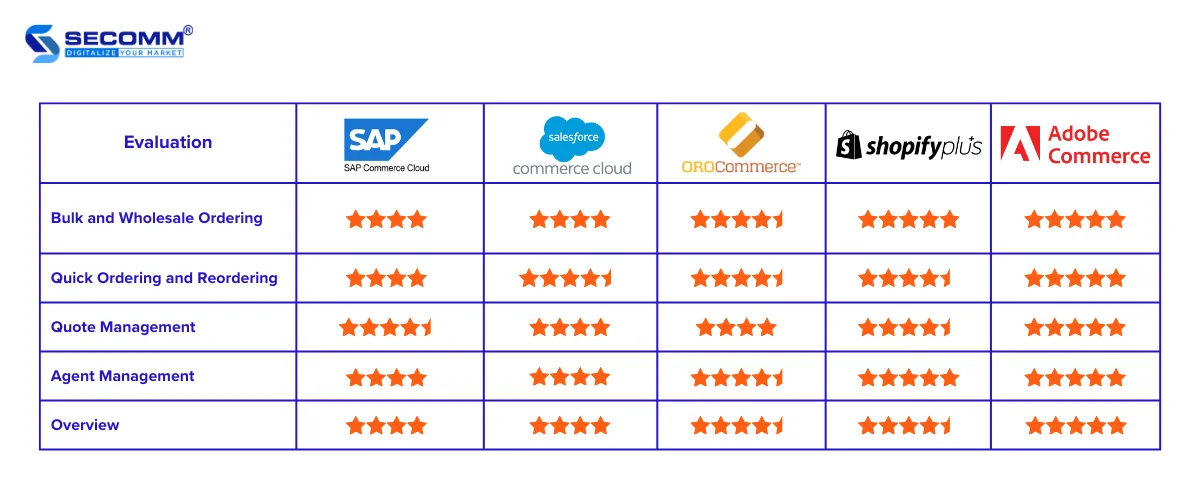
SAP Commerce Cloud is a powerful eCommerce platform suitable for B2B eCommerce businesses.
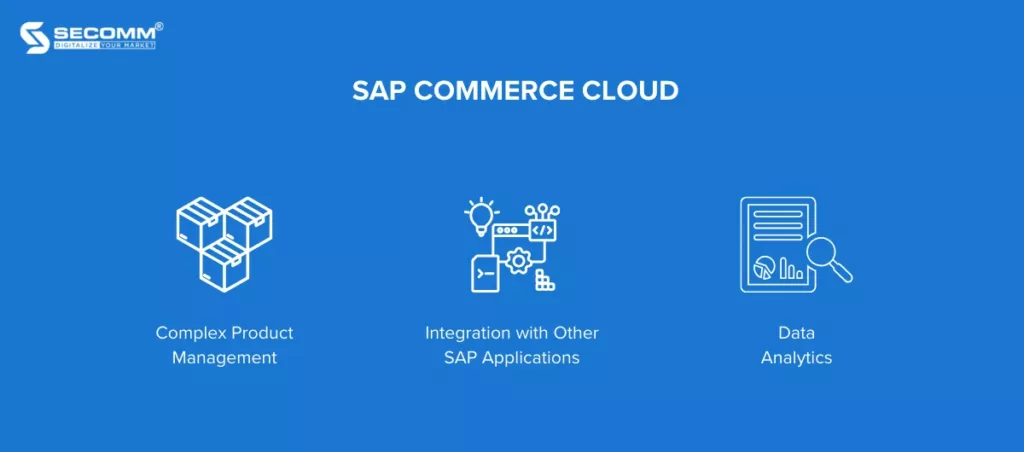
Here are some ways in which SAP Commerce Cloud can cater to B2B eCommerce:
Therefore, SAP Commerce Cloud can align with B2B eCommerce by offering features and customization capabilities to meet the specific requirements of businesses in the B2B industry.
Salesforce B2B Commerce is an eCommerce platform designed for large enterprises, including B2B businesses.
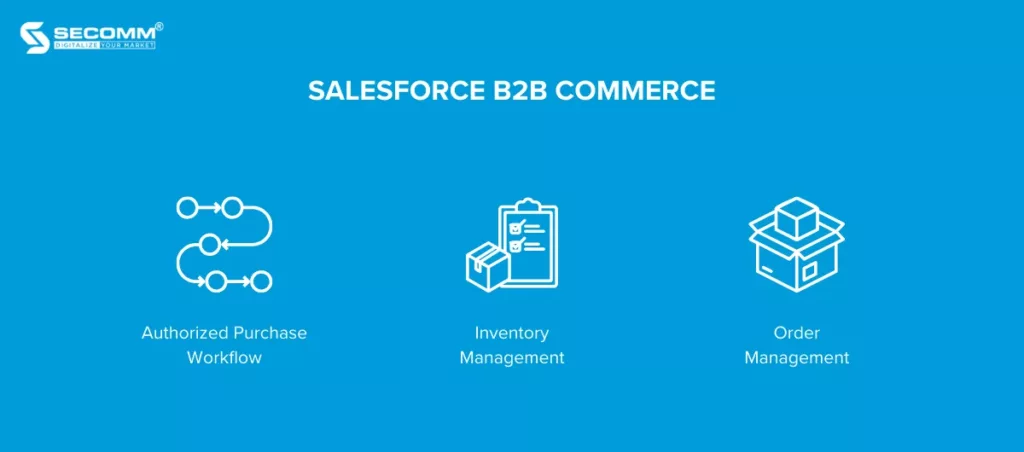
Here are some specific features and functionalities of Salesforce B2B Commerce that are suitable for B2B eCommerce:
In summary, the B2B functionalities of Salesforce B2B Commerce help B2B businesses enhance sales and customer service effectiveness.
OroCommerce is an open-source eCommerce platform designed for B2B enterprises. This platform provides powerful and flexible features, catering to the needs of B2B businesses of all sizes.
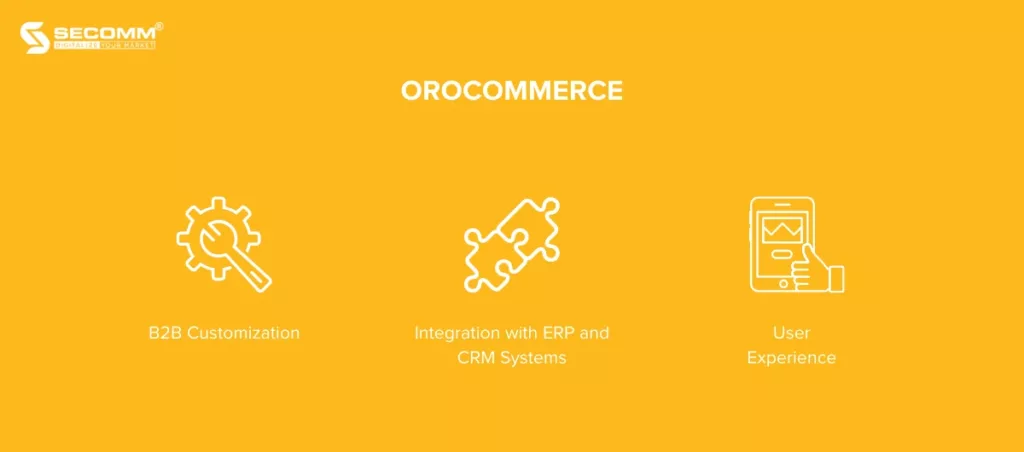
OroCommerce offers several features and functionalities specifically suitable for B2B eCommerce, including:
Overall, OroCommerce is a robust eCommerce platform worth considering for B2B enterprises.
Shopify Plus is a cloud-based SaaS eCommerce platform designed for large enterprises, especially B2B businesses.
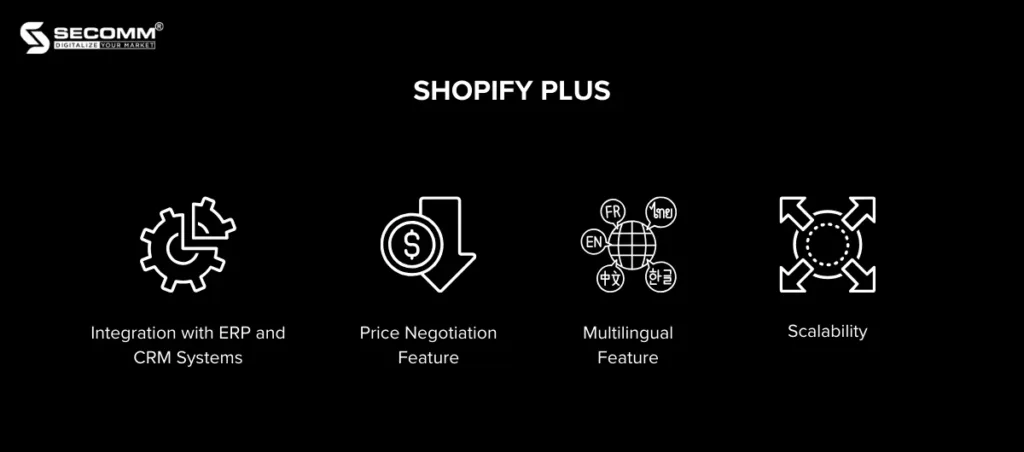
Shopify Plus provides powerful features and functionalities to meet the needs of B2B enterprises, including:
Some notable features of Shopify Plus that businesses can leverage include Shopify Flow, Shopify Launchpad, Shopify Payments, Shopify POS, etc.
Therefore, Shopify Plus is also an excellent choice for B2B businesses looking for a robust, flexible, and scalable eCommerce platform.
Xem thêm: 15 Lý do để chuyển đổi sang nền tảng Shopify Plus
Adobe Commerce (Magento) is a powerful and flexible eCommerce platform suitable for various types of businesses, including B2B enterprises.
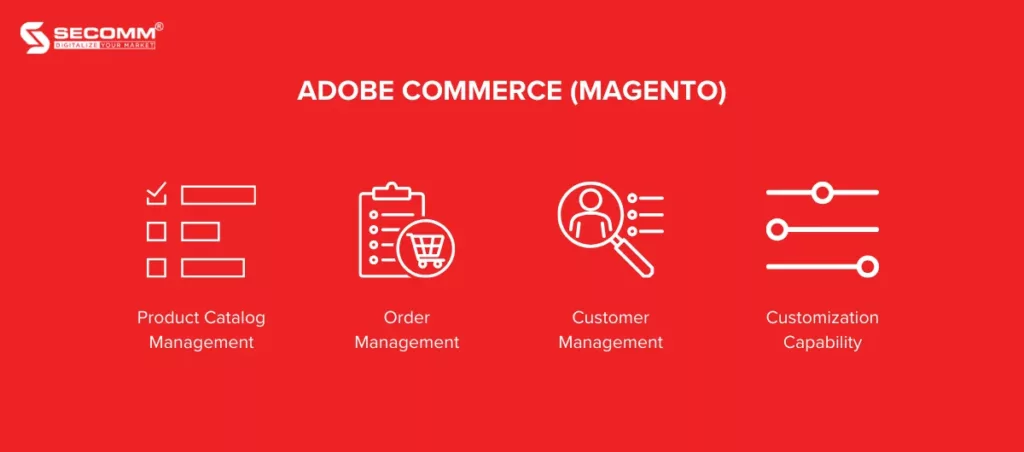
Adobe Commerce offers many features and functionalities that are well-suited for B2B eCommerce, including:
Moreover, Adobe Commerce can quickly deploy B2B-specific features thanks to its diverse ecosystem. It is also the most customizable platform among the five mentioned.
Additionally, Adobe Commerce has a large and active user community, providing support and resources for B2B businesses.
Read more: Shopify Plus vs Adobe Commerce: Key Differences 2023
Above are 5 popular platforms preferred by B2B businesses to build eCommerce websites, serving online business goals for brands.
However, choosing the most suitable platform for each business will depend on various factors, including business strategy, budget, deployment timeline, and the long-term direction set by business managers.
With deep expertise and the development of complex eCommerce systems for clients such as Changi Airport Group (Singapore), Trentham Estate (Australia), and The Warehouse (Vietnam), SECOMM understands the challenges in choosing a platform and deploying eCommerce that businesses are facing.
Contact SECOMM now or call directly at the hotline number (028 7108 9908) for free advice on the eCommerce website building roadmap!
 2
2
 8,116
8,116
 0
0
 1
1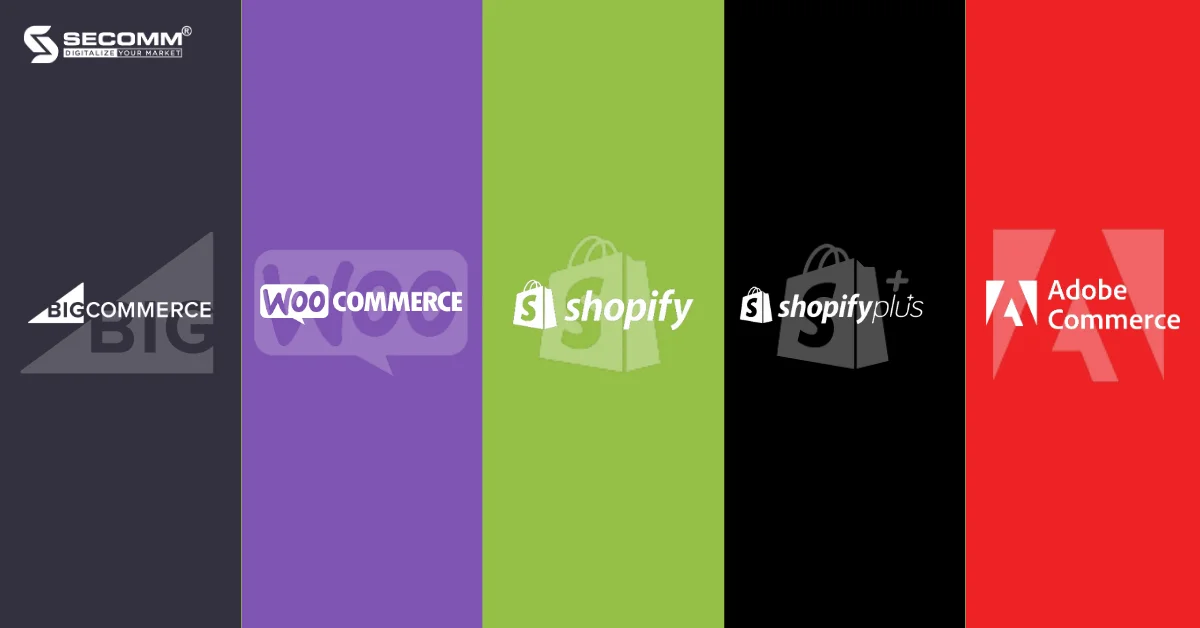
The global B2C eCommerce market is valued at 4.44 trillion USD in 2023 and is projected to reach 7.45 trillion USD by 2030, with a compound annual growth rate (CAGR) of 7.6% during the forecast period from 2021 to 2030.
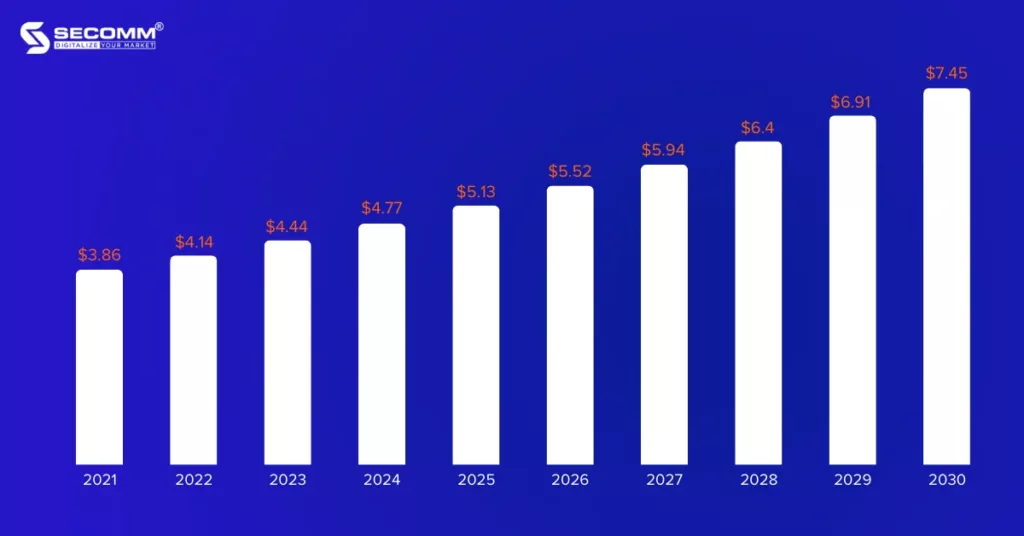
This demonstrates that eCommerce is increasingly thriving, becoming a crucial sales channel for B2C businesses. To build and develop a successful online store, businesses need to choose an eCommerce platform that aligns with their needs and business objectives.
B2C eCommerce platforms typically provide a seamless shopping journey, and user-friendly interfaces, allowing customers to easily navigate, search for items, and complete transactions quickly.
This is achieved through professional UI/UX design and advanced functionality systems for eCommerce websites.
An exemplary example is CHARLES & KEITH, a fashion eCommerce website, designed with sophistication and appeal, along with easy navigation and search capabilities.
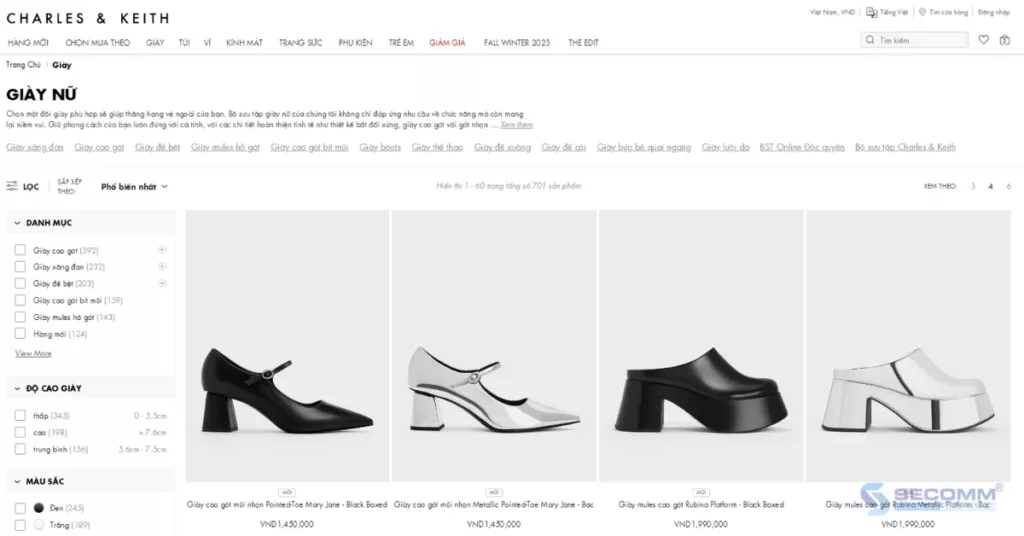
According to Statista’s statistics, the expected number of smartphone users worldwide is projected to reach 4.96 billion by 2025. This indicates that mobile commerce is virtually indispensable in B2C eCommerce strategies.
Consumers increasingly desire the ability to shop anytime, anywhere, even while on the move, and optimizing eCommerce websites for mobile devices will meet this consumer demand.
Choosing a suitable eCommerce platform will support a range of mobile-optimized themes catering to various industries and preferences, enabling businesses to establish an effective online store and navigate for mobile users.
Leading B2C eCommerce platforms will have a streamlined order processing system, ensuring a hassle-free payment experience for both business owners and buyers.
OneStep Checkout is a typical example that allows customers to complete their order payment on a single page. This simplifies and facilitates the payment process for customers, potentially increasing conversion rates.
Businesses can refer to PNJ’s Checkout page for comprehensive information on streamlining the shipping process all within one webpage.
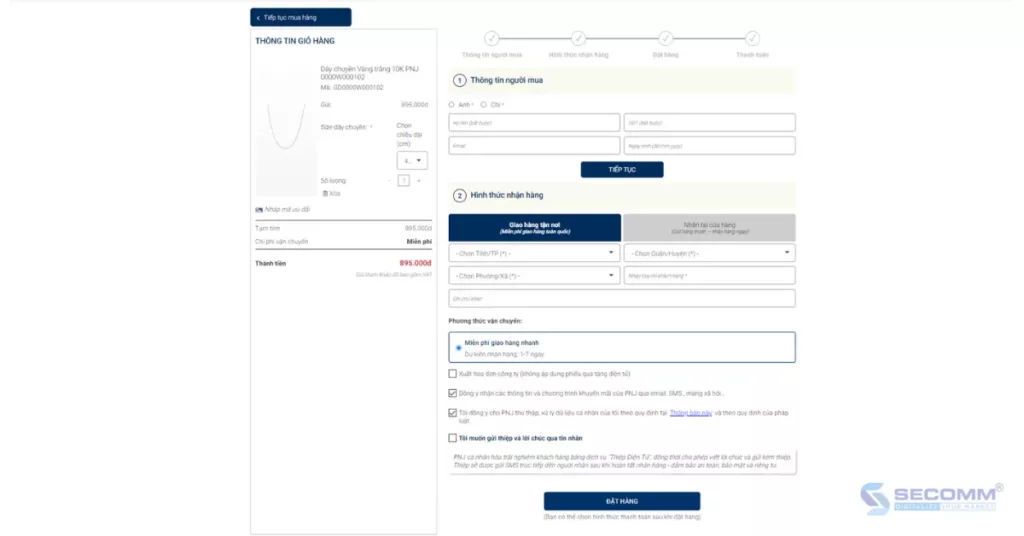
Personalization tools allow businesses to tailor content and promotions based on consumer behaviour and preferences, supported by AI.
By integrating personalized features at relevant touchpoints within an eCommerce website, businesses can enhance conversion rates and ROI (Return on Investment).
Major eCommerce brands like Amazon, Alibaba, Best Buy, etc., consistently incorporate product recommendation features to encourage shopping behaviour from customers.
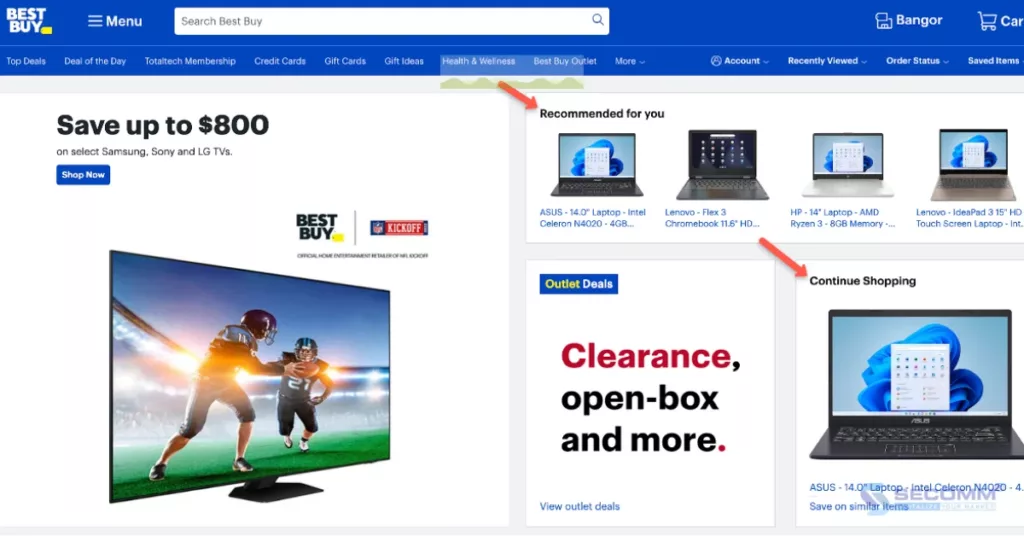
Another crucial aspect of B2C eCommerce is the ability for pages to load quickly and efficiently, ensuring the website maintains stable performance and effectively delivers content on all devices.
To ensure website performance, businesses should opt for major eCommerce platforms such as Adobe Commerce (Magento), Shopify Plus, BigCommerce Enterprise, etc. These platforms offer advanced performance features and robust caching mechanisms, tailored for various industries and preferences, enabling businesses to establish online stores with responsive feedback and faster page loading.
Below are the top 5 eCommerce platforms that SECOMM has evaluated as suitable for businesses following the B2C model.
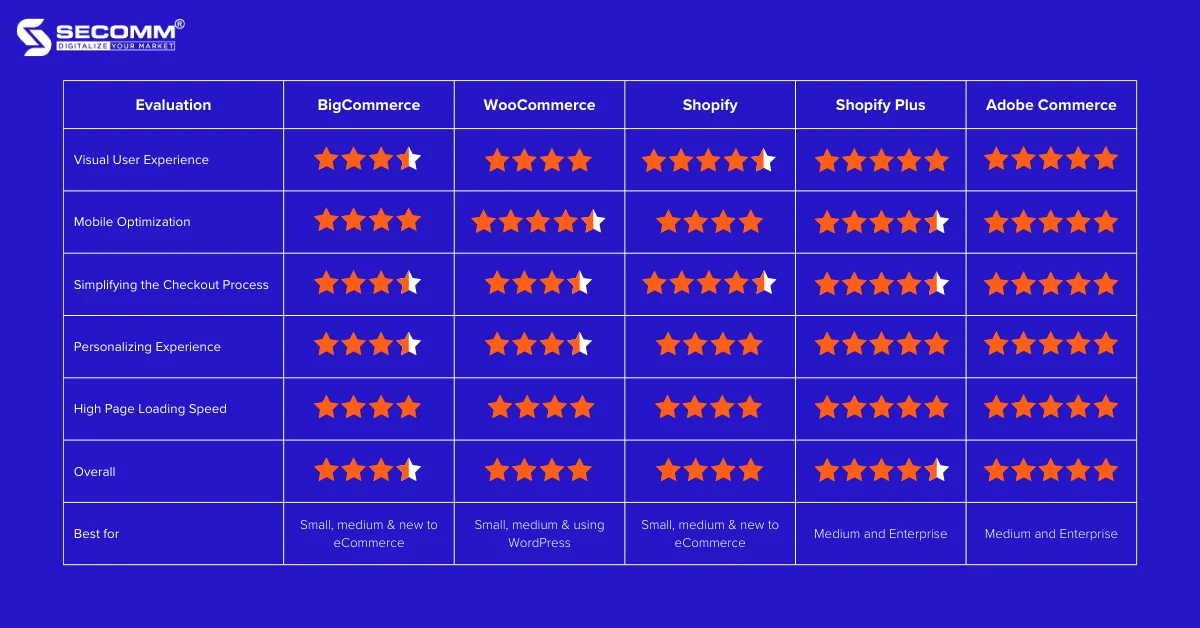
BigCommerce is an eCommerce platform designed for ease of use to assist businesses in initiating their journey to build an eCommerce website.
After years of development, BigCommerce has become one of the feature-rich platforms available for creating websites, optimizing search tools, marketing, etc., with reasonable deployment costs.
Compared to other popular platforms mentioned in this article, the performance, features, and application ecosystem of BigCommerce are not overly outstanding. However, BigCommerce remains a good choice for small, and medium-sized businesses, or those entering the market.
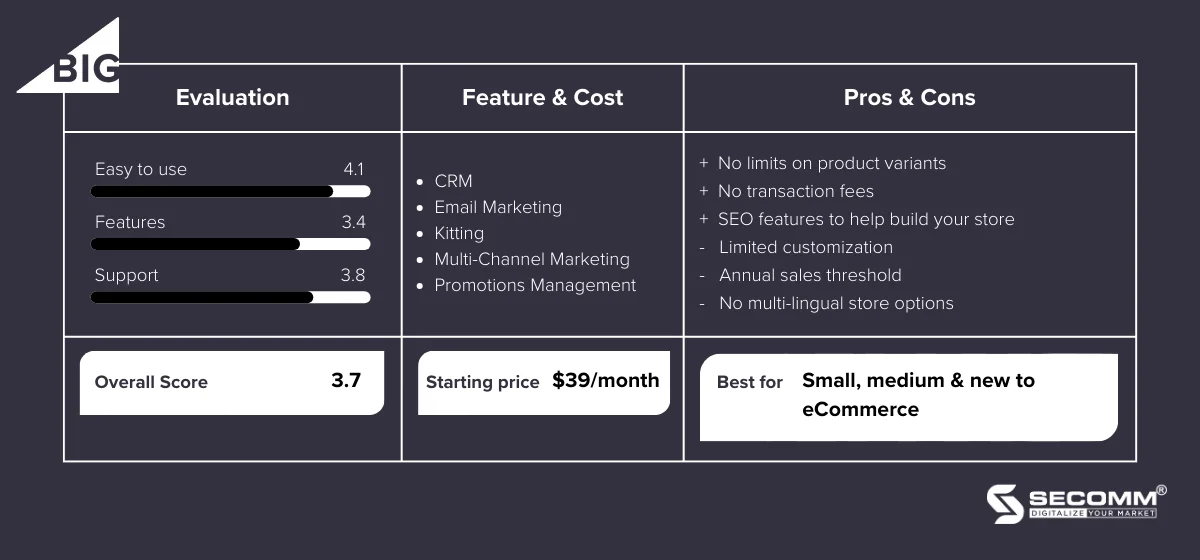
Read more: Shopify vs BigCommerce: Which platform is right for you?
WooCommerce is a free WordPress plugin that enables brands to establish an eCommerce website by adding eCommerce functionality to an existing WordPress site. The WooCommerce plugin helps transform a regular WordPress website into an eCommerce site with all the necessary features, easily customizable with just a few clicks.
Businesses can leverage the extensive ecosystem of WooCommerce to upgrade both functionality and design for the most suitable interface. Therefore, WooCommerce is also a good choice for small or medium-sized B2C businesses, especially those that have previously used WordPress.
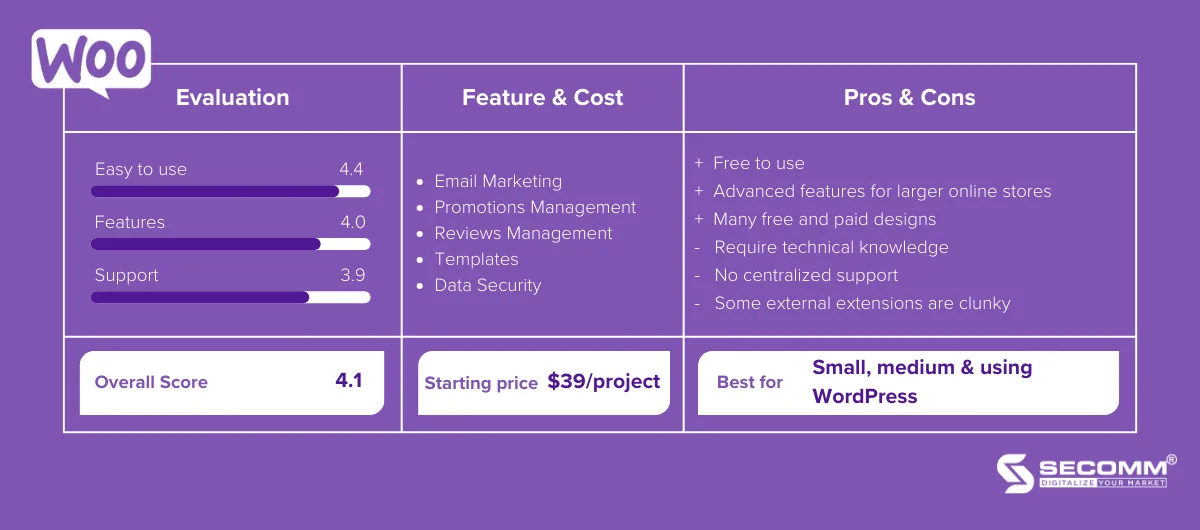
Shopify is one of the popular eCommerce platforms that businesses can use to build, develop, and manage online stores.
Shopify operates on the SaaS (Software as a Service) model, so businesses pay a monthly fee to use the platform and must adhere to its regulations.
However, Shopify manages hosting and takes responsibility for technical issues to ensure the safety and efficient operation of the business’s eCommerce website.
The platform provides the necessary features and benefits for businesses to successfully build and develop an online store. In terms of suitability for B2C businesses, Shopify is most suitable for small to medium-sized enterprises or those entering the eCommerce market.
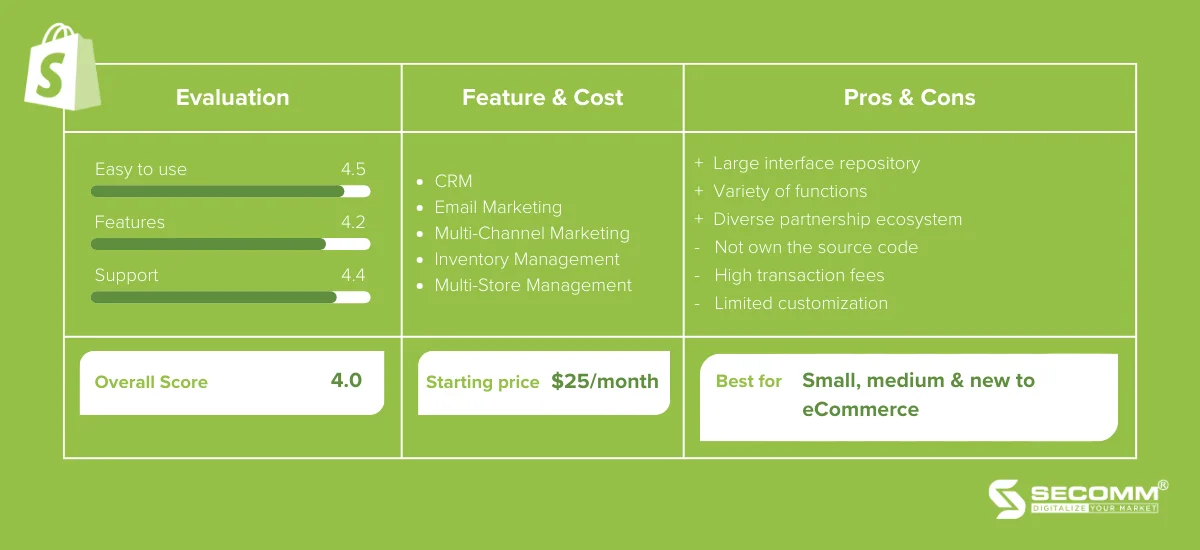
Shopify Plus is the enterprise-level version of the eCommerce platform provided by Shopify, specifically designed for large brands with an annual transaction value of over 1 million USD and high growth rates.
Unlike Shopify, Shopify Plus follows the PaaS (Platform as a Service) model, allowing businesses to utilize the development environment of Shopify Plus to develop databases, web servers, functionality, etc., for their eCommerce system.
The initial cost for using Shopify Plus is around $2,000 per month and increases gradually based on revenue. Therefore, using this platform to meet the needs of B2C eCommerce or any industry-specific requirements is relatively straightforward.
However, Shopify Plus is more suitable for medium to large-scale businesses as it requires technical knowledge and involves relatively high usage costs.
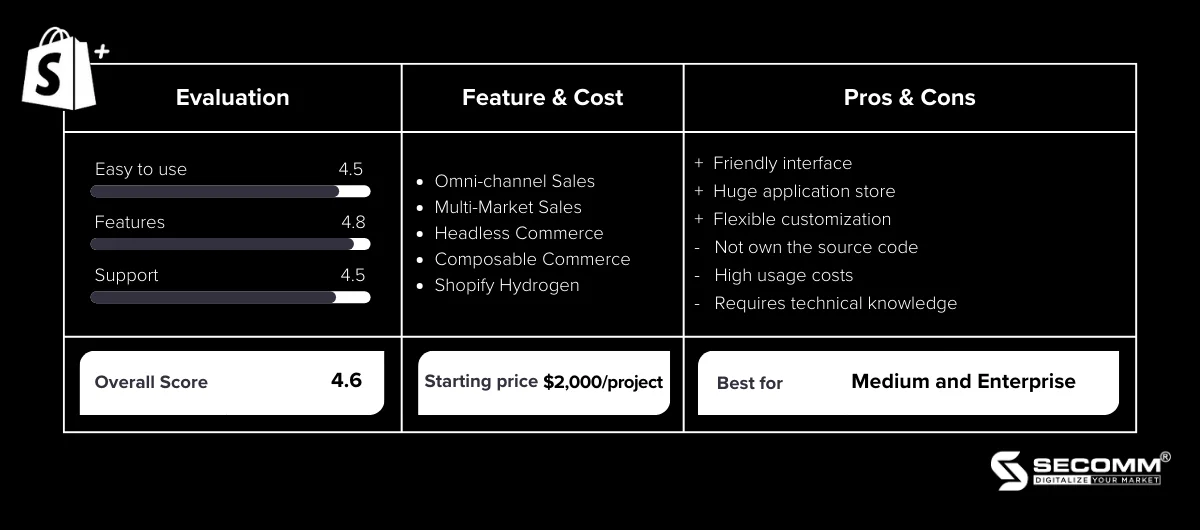
Read more:
Adobe Commerce is an open-source eCommerce platform specially designed to serve medium to large-scale businesses, offering high customization and scalability. Currently, Adobe Commerce has two main versions: Adobe Commerce Cloud and Magento Open Source.
As one of the leading platforms in eCommerce, Adobe Commerce is consistently highly regarded across all scales and industries, including B2C eCommerce businesses.
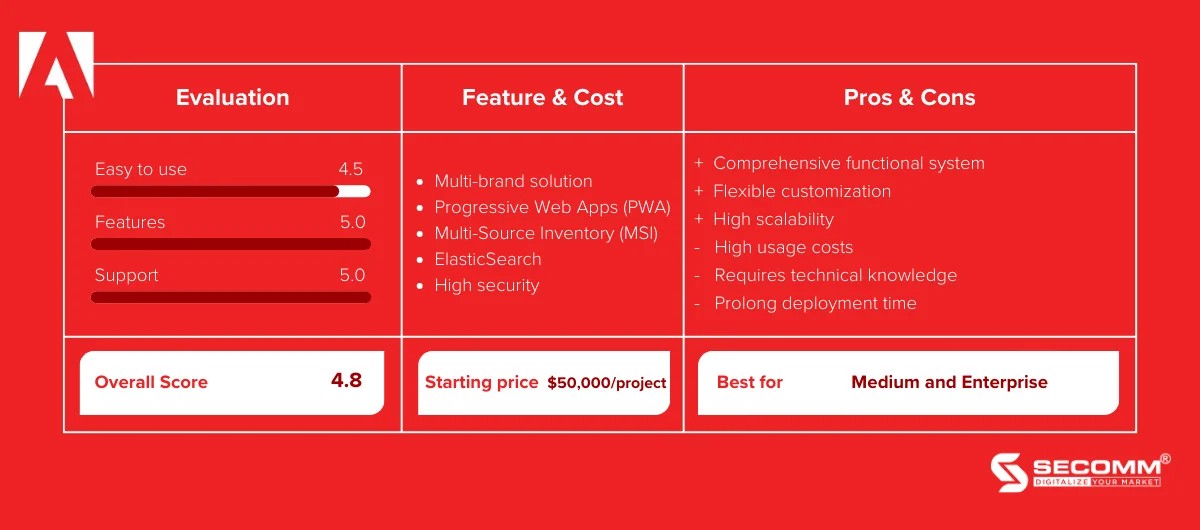
Read more:
Above are the 5 popular platforms that B2C businesses prefer to use for building eCommerce websites, catering to online business goals for their brands.
However, choosing the most suitable platform for each business will depend on various factors such as business strategy, budget, deployment time, and the long-term direction set by business managers.
With deep expertise and the development of complex eCommerce systems for clients such as Changi Airport Group (Singapore), Trentham Estate (Australia), and The Warehouse (Vietnam), SECOMM understands the challenges in choosing a platform and deploying eCommerce that businesses are facing.
Contact SECOMM now or call directly at the hotline number (028 7108 9908) for free advice on the eCommerce website building roadmap!
 2
2
 9,230
9,230
 0
0
 1
1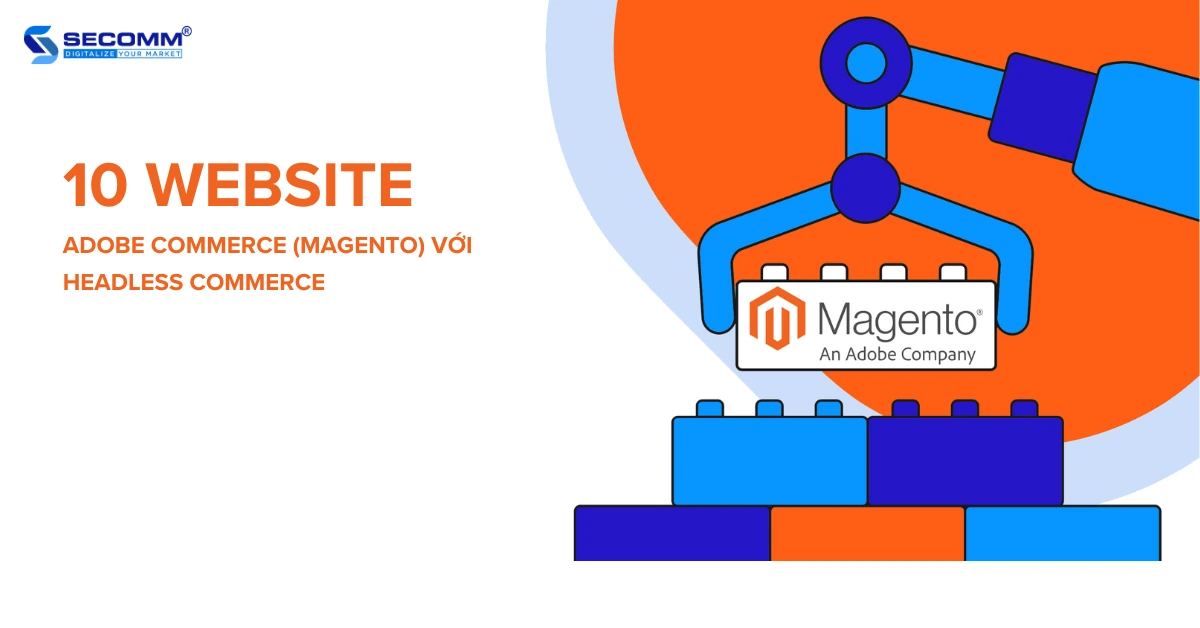
Headless Commerce is a significant revolution in the technology sector, changing the way businesses approach eCommerce. In this field, Adobe Commerce leads in providing solutions and tools for implementing Headless Commerce.
Below is a list of 10 well-known brands currently utilizing Adobe Commerce and Headless Commerce.
Samsung is a multinational conglomerate based in South Korea, operating in various sectors, with its most prominent being consumer electronics, generating a revenue of $234 billion in 2022.
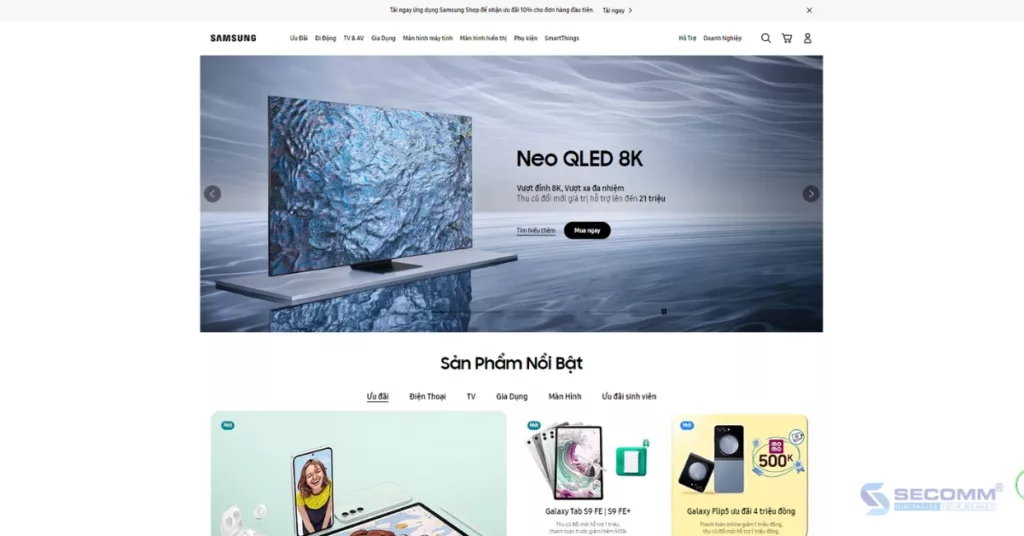
Samsung’s eCommerce website is built on the Adobe Commerce Cloud platform, utilizing Headless Commerce technology as its core. Thanks to this, Samsung has developed a virtual assistant to support customers in online and in-store shopping. In the U.S. market, customers can use this assistant to view product demos, receive usage instructions, and make online purchases. Customers have highly praised this feature for providing a more comfortable and convenient shopping experience.
Target Corporation is a major retail company in the United States, offering a wide range of products and services, including clothing, footwear, electronics, household goods, toys, and furniture. According to the financial report of Target Corporation in 2022, the revenue reached $106.8 billion, a growth of 8.4% compared to 2021.
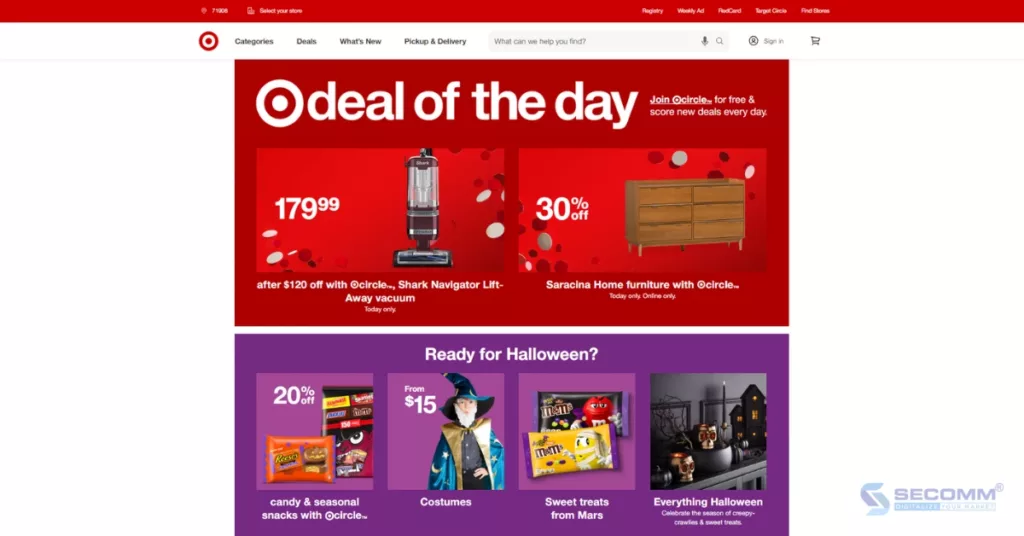
Target recognized that the brand was losing revenue as customers began their shopping journey on one device and ended it on another. The retailer has implemented Headless Commerce to deploy omnichannel sales to increase conversion rates on various devices, thereby making it easier for customers to complete their purchase transactions.
Toyota is one of the largest automobile manufacturers in the world, selling over 10 million vehicles globally each year. Toyota produces a variety of vehicles and accessories, including cars, trucks, buses, and sports utility vehicles, as well as engines, transmissions, and auto parts.

Toyota’s website utilizes Headless Commerce to leverage Application Programming Interfaces (APIs) for integration with legacy systems and inventory management, providing a personalized omnichannel experience.
Under Armour is an American sportswear company founded in 1996 by Kevin Plank. The company is headquartered in Baltimore, Maryland, and specializes in the production of sportswear, footwear, and accessories, with an annual revenue of over $10 billion.

Currently, Under Armour is using Headless Commerce to enhance the personalized fitness experience based on location, purchase history, and workout activities, as well as training logs. The Under Armour website features notable functionalities such as inventory alerts, traffic history, payment information, and content management using data from the order management system.
Kirkland’s is a chain of home décor, furniture, textiles, accessories, and gift stores in the United States. The company is headquartered in Brentwood, Tennessee, and operates 431 stores in 35 states and an eCommerce website.

Kirkland’s has implemented Headless Commerce to address website-related issues such as flexibility, custom design, and providing a smooth shopping experience (single-click login and biometric payment capabilities).
Coca-Cola is a carbonated beverage brand established in 1886. It is currently the world’s best-selling beverage brand, available in over 200 countries and territories, with over 2 billion cans sold every day.
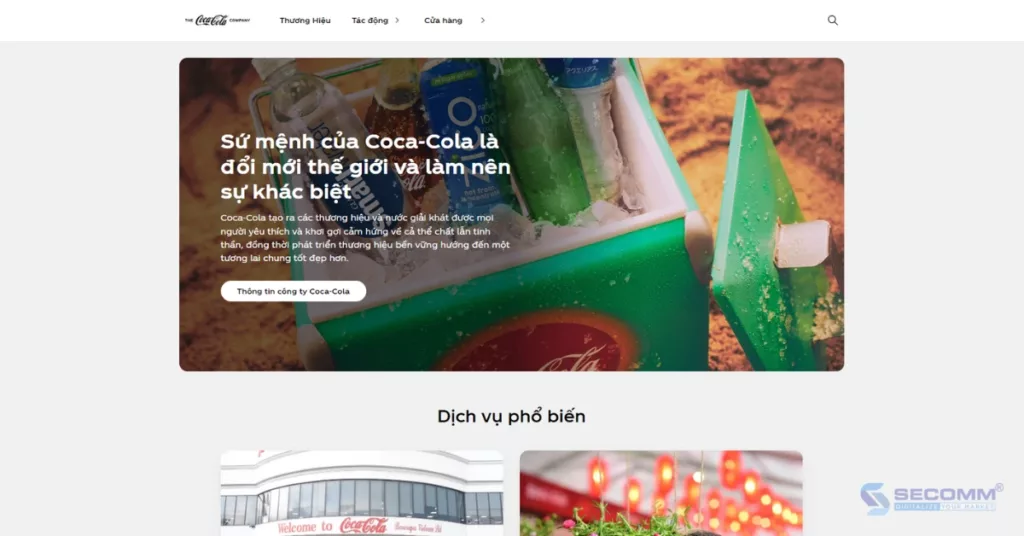
The Coca-Cola website utilizes Headless Commerce technology to leverage API integration, providing a seamless end-to-end omnichannel experience for global customers. This technology allows the business to expand through its markets, customize experiences, and integrate with third-party suppliers and solutions.
Technodom is one of the largest retailers in Central Asia, with an annual revenue of $800 million. This retail giant has around 9,000 employees, offering over 60,000 products and 4,000 categories.
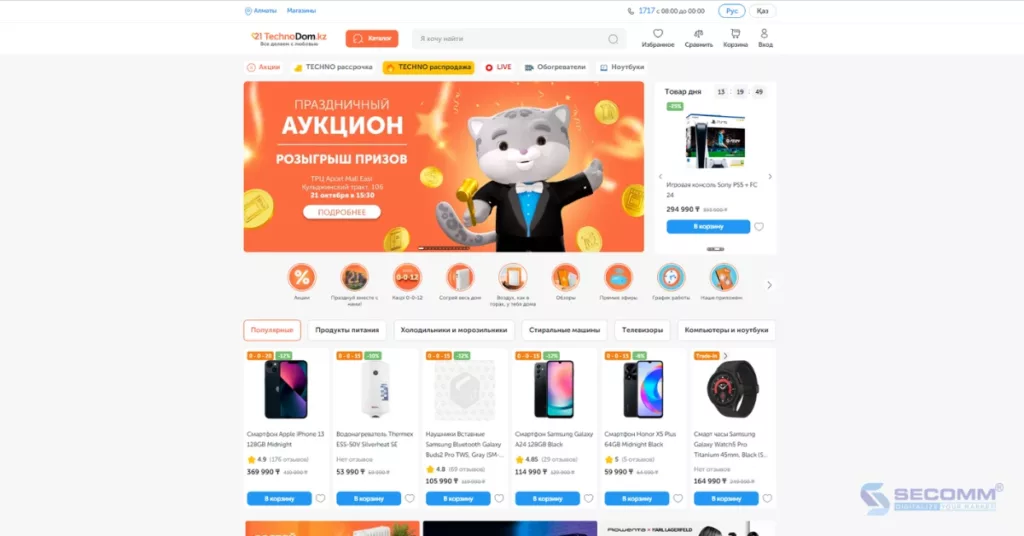
Technodom has implemented Headless Commerce on Magento with a page load speed of under one second, thanks to the PWA (Progressive Web App) pre-rendering solution. Additionally, the website’s backend is integrated with Akeneo PIM (Product Information Management) and ESB (Enterprise Service Bus), essential components for businesses to efficiently manage and distribute their databases.
Helly Hansen is a renowned Norwegian company that manufactures and retails clothing, sports gear, and outdoor accessories. Established in 1877, the company is now one of the world’s leading fashion and lifestyle brands, with a revenue of $2.8 billion in 2022.

Initially, Helly Hansen’s eCommerce website was built on the Magento platform. After a period of business operations, Helly Hansen decided to transition to Adobe Commerce to implement Headless Commerce. As a result, Helly Hansen’s website quickly saw a 24% increase in traffic, a 48% increase in mobile traffic, and a more than 45% increase in total revenue.
Kaporal is a French fashion brand specializing in jeans, T-shirts, shirts, jackets, and accessories. The brand was established in 2004 and is currently present in over 30 countries worldwide.

Similar to many longstanding Magento businesses, Kaporal has migrated its platform from Magento 1 to Magento 2 to take advantage of the Headless Commerce features from PWA Studio, addressing issues related to slow speed and poor mobile performance.
G-SP is a brand specializing in the business of spare parts and digital accessories, established in 2009. This Swedish company currently has offices in Sweden, the Netherlands, and China, offering over 10,000 products.

Similar to many other Magento stores, G-SP faced issues with website performance and stability. Therefore, G-SP opted for Headless PWA to enhance their digital conversions. The implementation of Headless PWA accelerated the mobile website speed by 2.7 times, which is particularly crucial for a complex Magento website with numerous plugins and categories like G-SP.
Above is the list of the top 10 eCommerce websites currently using the Adobe Commerce (Magento) eCommerce platform and Headless Commerce globally.
With deep expertise and the development of complex eCommerce systems for clients such as Changi Airport Group (Singapore), Trentham Estate (Australia), and The Warehouse (Vietnam), SECOMM understands the challenges in choosing a platform and deploying eCommerce that businesses are facing.
Contact SECOMM now or call directly at the hotline number (028 7108 9908) for free advice on the eCommerce website building roadmap!
 2
2
 3,264
3,264
 0
0
 1
1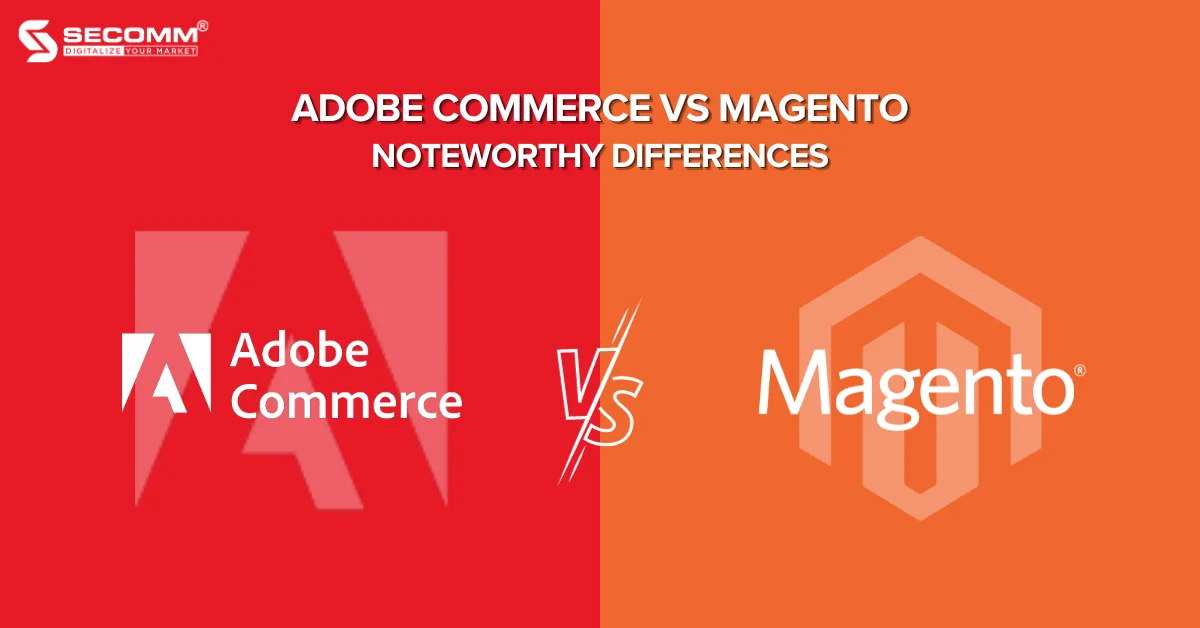
Magento and Adobe Commerce are considered popular eCommerce platforms, used by hundreds of thousands of businesses worldwide.
Both platforms have strong growth potential in the future, given the increasing trend of eCommerce and the demand for robust and flexible eCommerce solutions.
Magento is an open-source eCommerce platform used by over 300,000 eCommerce websites before being officially acquired by Adobe in 2018. Magento is known for its performance, user-friendliness, scalability, and security, especially in Magento 2.0.
Since its establishment, Magento has provided two main versions for businesses:
Currently, there are two main versions:
Magento Open Source and Adobe Commerce. Adobe Commerce is further divided into two versions, On-Premise (referred to as Adobe Commerce) and On-Cloud (referred to as Adobe Commerce Cloud).
Magento Open Source is a free, open-source eCommerce platform that requires users to have technical knowledge and skills to install, build, and manage the website. This platform also takes time and money to deploy basic to advanced features.
Key features include:
Depending on the complexity of the system, the cost of deploying a Magento website can fluctuate around $50,000 for the first year.
This is a paid on-premises service from Adobe, so this platform includes all the premium features of Magento Open Source and more.
After merging with Adobe, Magento Commerce was renamed Adobe Commerce and is considered part of the Adobe Experience Cloud—a set of solutions designed to help businesses make informed decisions and provide enhanced customer experiences based on detailed information and data.
Adobe Commerce is often integrated with Adobe Experience Manager, Adobe Analytics, and Adobe Target. Through Adobe Commerce, businesses have access to smart business services provided by Adobe, as well as machine learning capabilities and personalization provided by Adobe Sensei.
This makes Adobe Commerce the perfect eCommerce platform for businesses with complex needs and a desire to leverage leading capabilities to provide superior experiences for customers across multiple devices and channels. However, due to the relatively complex functional eCommerce website system on Adobe Commerce, businesses will need to be autonomous in the complex infrastructure as well.
The following diagram illustrates the reference architecture for deploying Adobe Commerce on AWS infrastructure. Other cloud service providers such as Azure, Google Cloud, and Alibaba Cloud also have similar infrastructure designs and services.
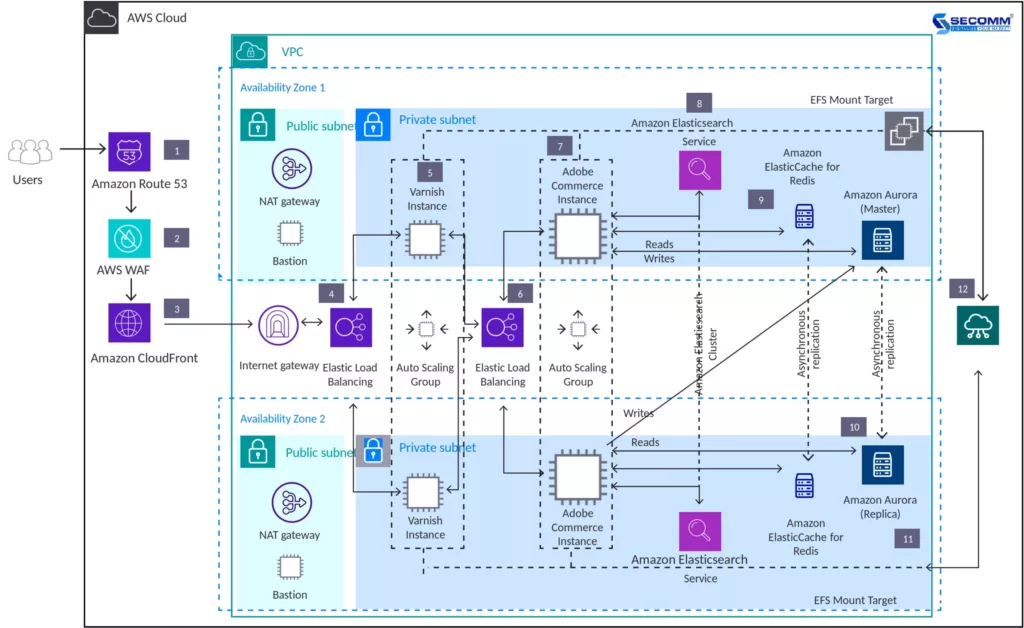
With all the reasons mentioned above, Adobe Commerce will have relatively high deployment costs, around $130,000 per project for the first year, depending on the complexity of the website system.
In contrast to the self-hosted version like Adobe Commerce, Adobe Commerce Cloud is a version that includes cloud services.
Specifically, this platform includes all the features of Adobe Commerce along with enhanced Adobe Cloud infrastructure, including integrated GIT (distributed source code management software) and specific environments for development, staging, and building the website system.
This means that developers using this platform can write code, test, and deploy on suitable environments, ensuring smooth performance.
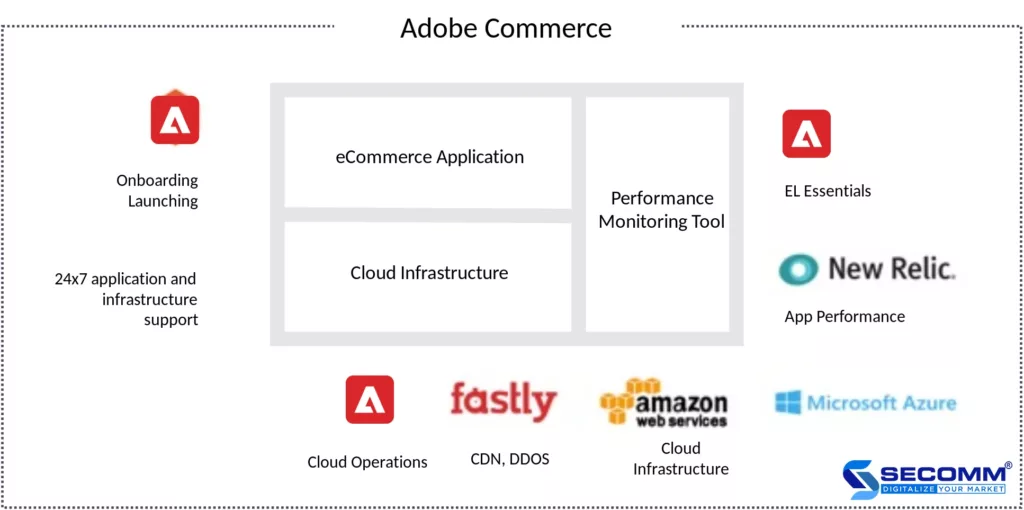
Similar to Adobe Commerce, Adobe Commerce Cloud is also suitable for large enterprises with special requirements because this version can meet all specialized needs, with flexibility and scalability through available management features.
However, the cost for enterprises to deploy Adobe Commerce Cloud will be higher than Adobe Commerce, around $150,000 per project for the first year, depending on the complexity of the website system.
Read more: The cost of building an Adobe Commerce (Magento) website
Although Adobe Commerce and Magento share the same core technology platform, they have functional differences. Magento includes some core features, and businesses can develop or integrate additional features through extensions.
On the other hand, Adobe Commerce includes features from Magento Open Source, along with additional features developed by the Adobe team.
Similarly, Adobe Commerce Cloud includes features from Adobe Commerce, along with advanced and more specialized features designed to address specific challenges for each business.
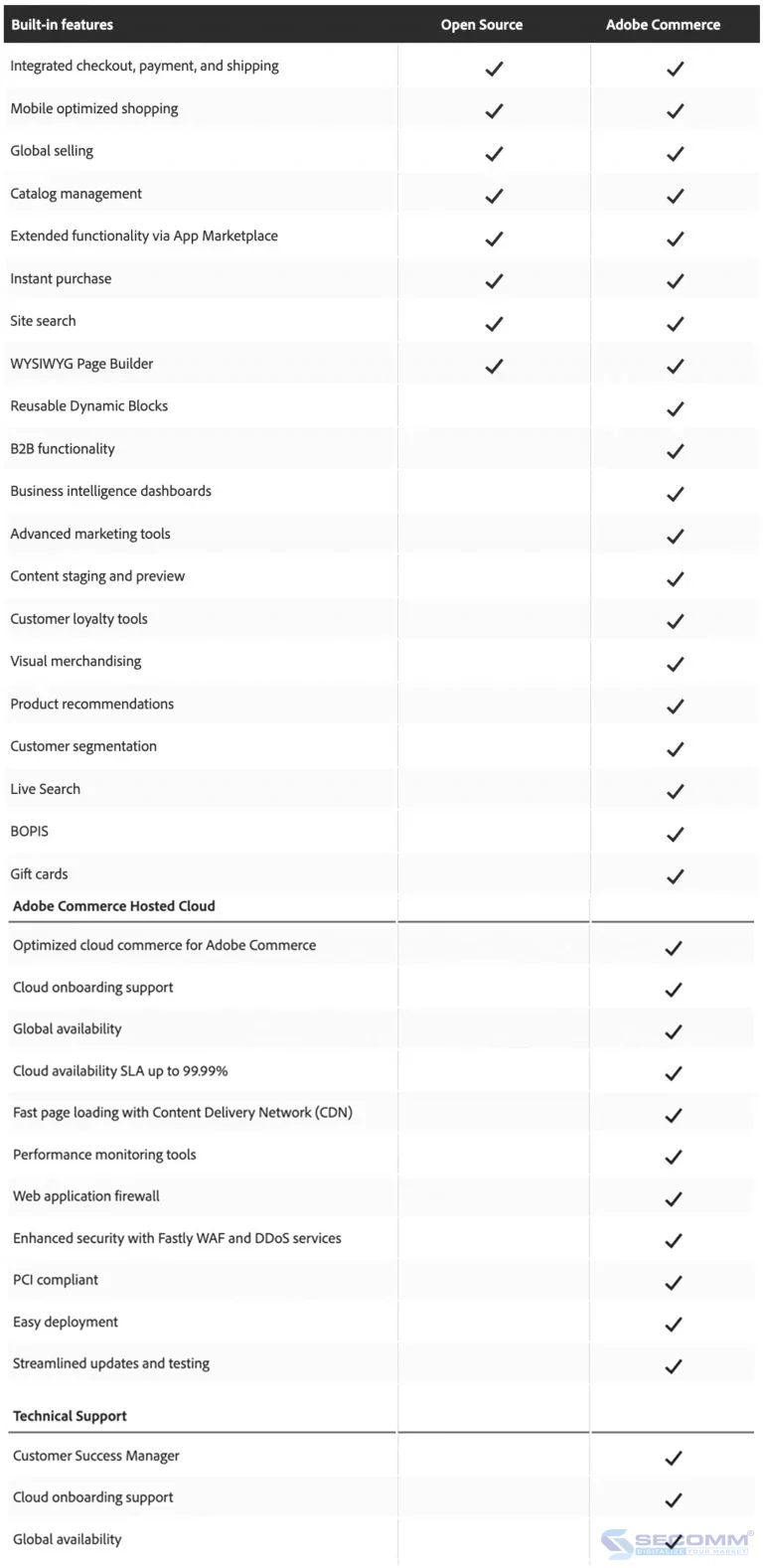
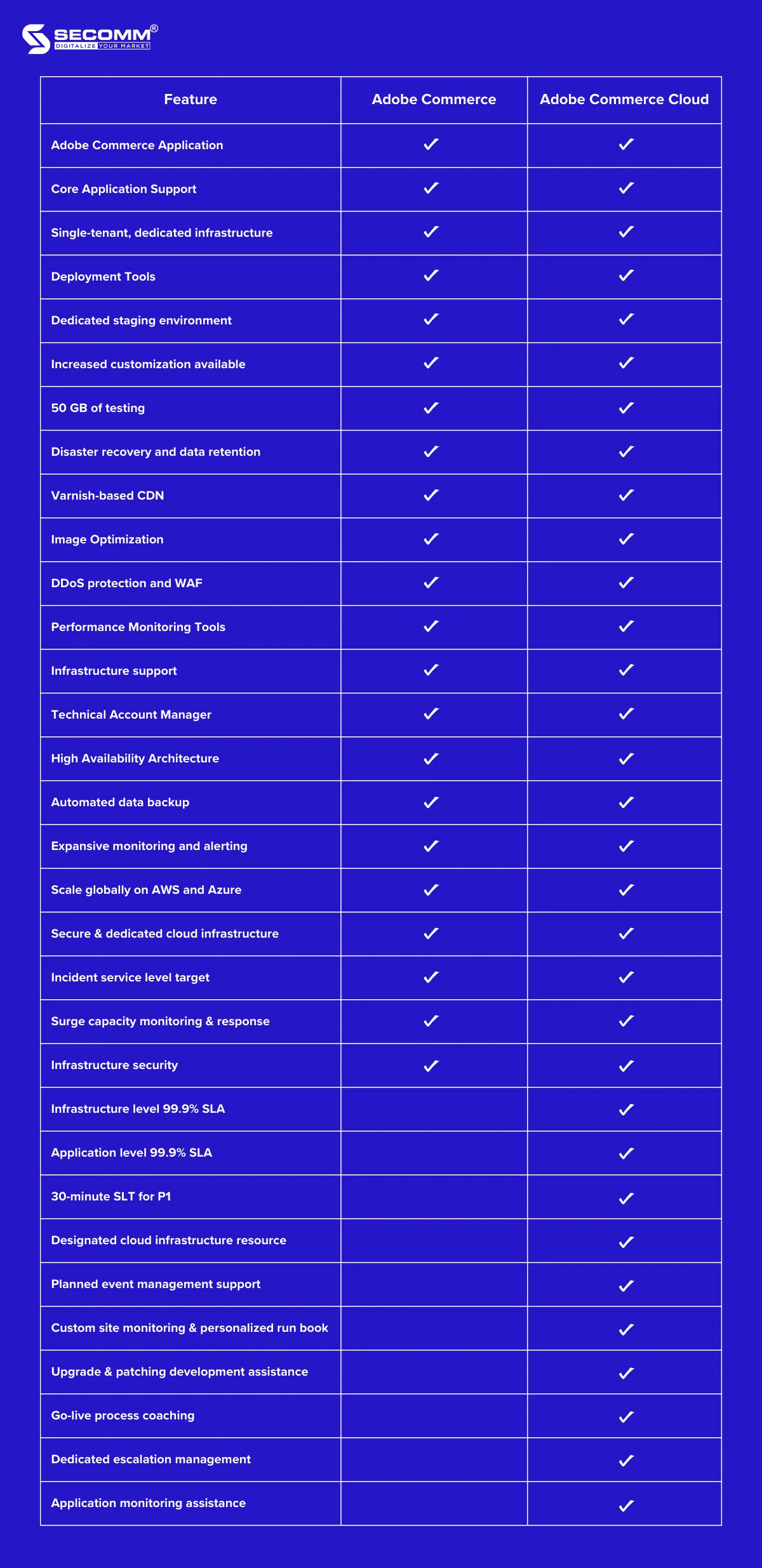
Besides the features, Magento and Adobe Commerce (both versions) also have some other differences.
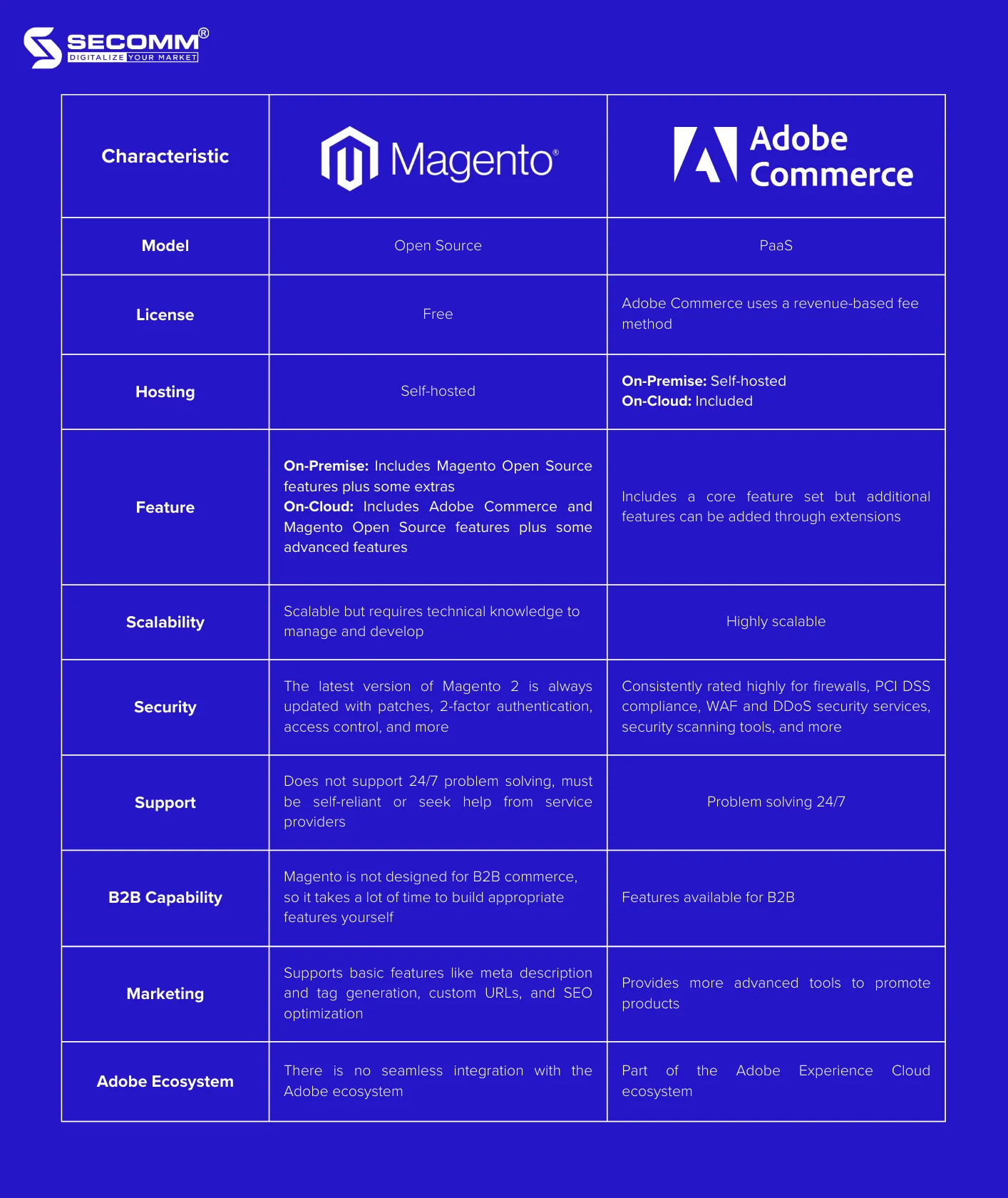
Magento and Adobe Commerce are both powerful eCommerce platforms that can meet the needs of businesses of all sizes. However, there are some notable differences between these two platforms.
Choosing the right eCommerce platform for a brand depends on the specific needs and budget of each business. If a business is a small to medium-sized enterprise, newly entering the market, and only requires basic and advanced features, then Magento Open Source is a good choice.
However, if the business is large and complex, requiring extensive features and scalability, then Adobe Commerce is a better choice.
With deep expertise and the development of complex eCommerce systems for clients such as Changi Airport Group (Singapore), Trentham Estate (Australia), and The Warehouse (Vietnam), SECOMM understands the challenges in choosing a platform and deploying eCommerce that businesses are facing.
Contact SECOMM now or call directly at the hotline number (028 7108 9908) for free advice on the eCommerce website building roadmap!
Read more:
 8
8
 6,249
6,249
 0
0
 1
1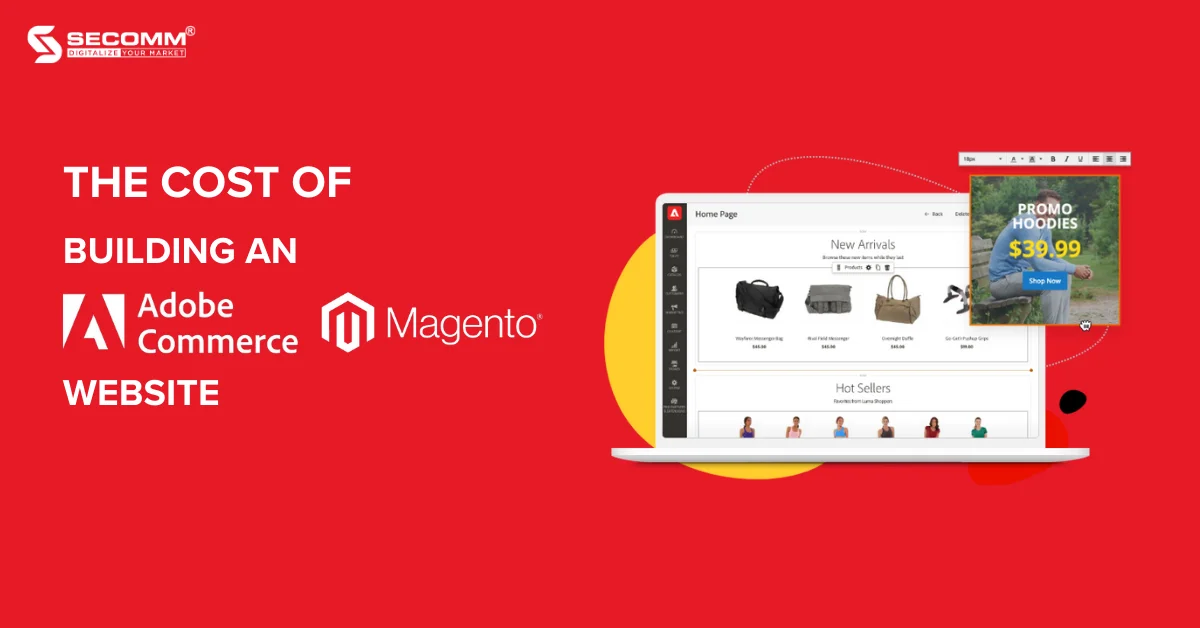
Adobe Commerce (Magento) is a powerful and feature-rich eCommerce platform that can help businesses build and operate professional eCommerce websites.
Therefore, Adobe Commerce is trusted by many businesses, especially medium to large enterprises, with over 100,000 websites, including the Magento Open Source version (According to Builtwith).
So, what is the cost to build a website on Adobe Commerce (Magento)?
Adobe Commerce is an open-source eCommerce platform designed specifically to cater to medium to large-scale businesses, offering high customization and scalability.
Formerly known as Magento Commerce, it was founded in 2007 in Culver City, California, USA. After several changes in ownership, in 2018, Adobe acquired Magento for $1.68 billion and rebranded it as Adobe Commerce.
Today, Adobe Commerce has become an integral part of the Adobe Experience Cloud, a suite of products and services designed to help businesses build, manage, and deliver digital experiences.
Currently, Adobe Commerce has two main versions: Adobe Commerce Cloud and Magento Open Source.
Magento Open Source (referred to as Magento) is a free version that can be downloaded and used by anyone. This version provides essential functions for creating and managing online stores, including:
However, businesses using the free Magento version do not necessarily mean that the cost of building an eCommerce website will be low, as additional costs need to be considered by the business.
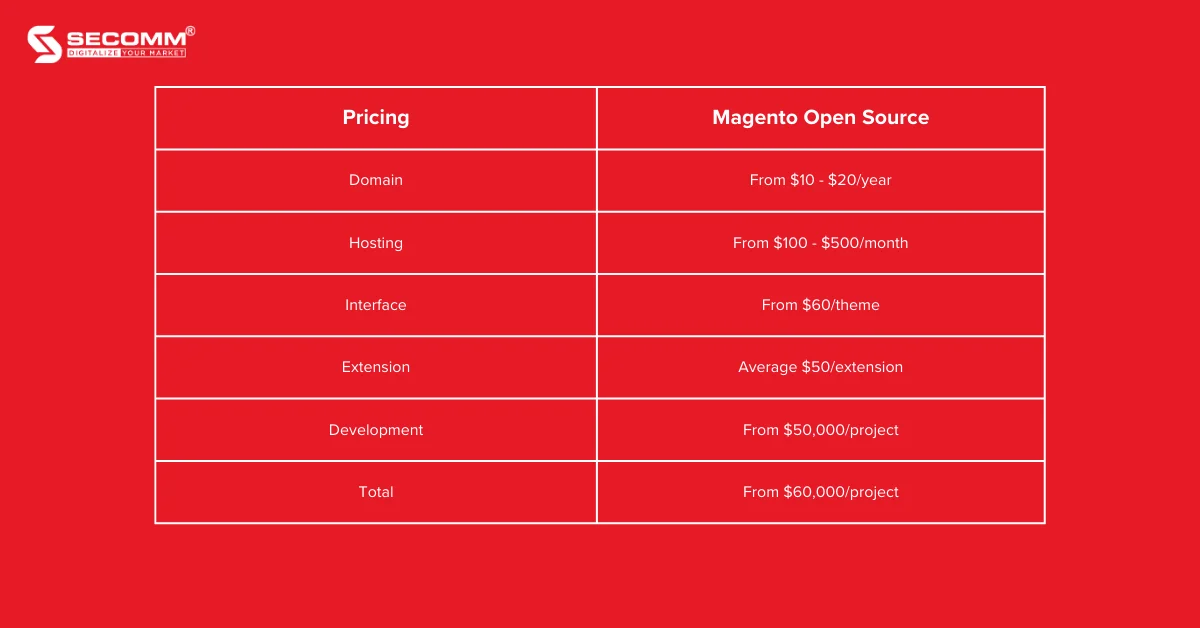
Depending on the complexity of the system, the cost to deploy a Magento website can be lower or higher than $60,000 for the first year.
Read more: The Significant Differences between Magento 1 and Magento 2
Formerly known as Magento Enterprise Edition (EE) or Magento Commerce On-Premise (On-Prem), Adobe Commerce is an enterprise-level option that doesn’t require businesses to manage performance or hosting.
Adobe Commerce is specifically designed for businesses engaged in more complex eCommerce operations, fully supported by Adobe’s technically skilled team. Its built-in features provide businesses with more control without the need for integrating many extensions, as seen in Magento Open Source.
Key features of Adobe Commerce include:
Below is the licensing fee table for Adobe Commerce for businesses based on annual revenue.
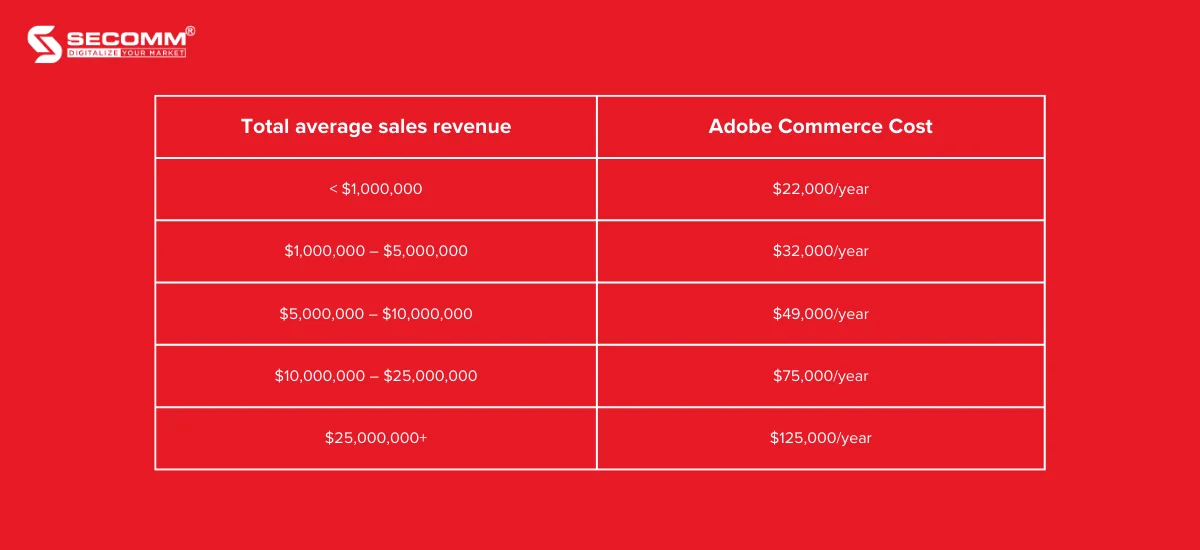
In addition to the license usage fee, businesses need to independently manage other fees such as hosting, domain, interface, website development, extensions, and system maintenance. Therefore, the cost to implement Adobe Commerce will be relatively high, around $130,000 per project for the first year, depending on the complexity of the website system.
Related article: Magento Open Source vs Magento Commerce Real Comparison
Adobe Commerce Cloud is a free version that includes hosting services, technical support specialists, and specialized features to build and operate successful online stores.
The most significant highlight of Adobe Commerce Cloud is the hosting service built on AWS cloud servers and performance monitoring tools such as New Relic and Blackfire.io, reducing additional costs and providing optimal performance for the website system.
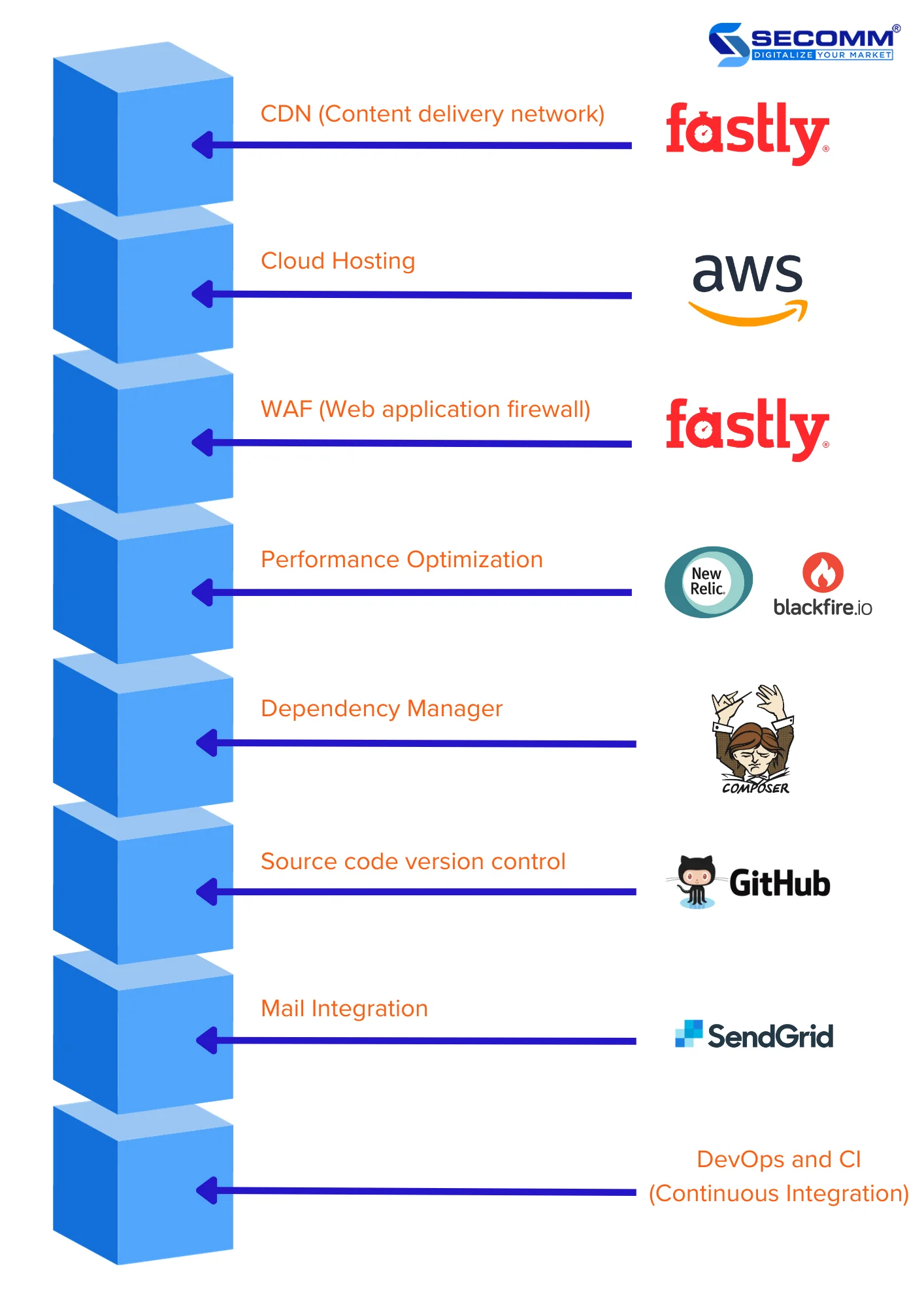
Another advantage of Adobe Commerce Cloud is that businesses don’t need to take responsibility for serious issues; all incidents are handled directly by Adobe’s personnel.
Furthermore, the functionality of Adobe Commerce Cloud is also rated higher than Adobe Commerce On-Premise.
| Feature | Adobe Commerce | Adobe Commerce Cloud |
| Adobe Commerce Application | ✔ | ✔ |
| Core Application Support | ✔ | ✔ |
| Single-tenant, dedicated infrastructure | ✔ | ✔ |
| Deployment Tools | ✔ | ✔ |
| Dedicated staging environment | ✔ | ✔ |
| Increased customization available | ✔ | ✔ |
50 GB of testing | ✔ | ✔ |
| Disaster recovery and data retention | ✔ | ✔ |
| Varnish-based CDN | ✔ | ✔ |
| Image Optimization | ✔ | ✔ |
DDoS protection and WAF | ✔ | ✔ |
| Performance Monitoring Tools | ✔ | ✔ |
| Infrastructure support | ✔ | ✔ |
Technical Account Manager | ✔ | ✔ |
| High Availability Architecture | ✔ | ✔ |
Automated data backup | ✔ | ✔ |
| Expansive monitoring and alerting | ✔ | ✔ |
| Scale globally on AWS and Azure | ✔ | ✔ |
| Secure & dedicated cloud infrastructure | ✔ | ✔ |
| Incident service level target | ✔ | ✔ |
Surge capacity monitoring & response | ✔ | ✔ |
| Infrastructure security | ✔ | ✔ |
| Infrastructure level 99.9% SLA | ✔ | ✔ |
| Application level 99.9% SLA | ✔ | |
| 30-minute SLT for P1 | ✔ | |
| Designated cloud infrastructure resource | ✔ | |
| Planned event management support | ✔ | |
| Custom site monitoring & personalized run book | ✔ | |
| Upgrade & patching development assistance | ✔ | |
| Go-live process coaching | ✔ | |
| Dedicated escalation management | ✔ | |
Application monitoring assistance | ✔ |
Source: Adobe Commerce Pricing
Here is the licensing fee table for using Adobe Commerce Cloud for businesses based on annual revenue.
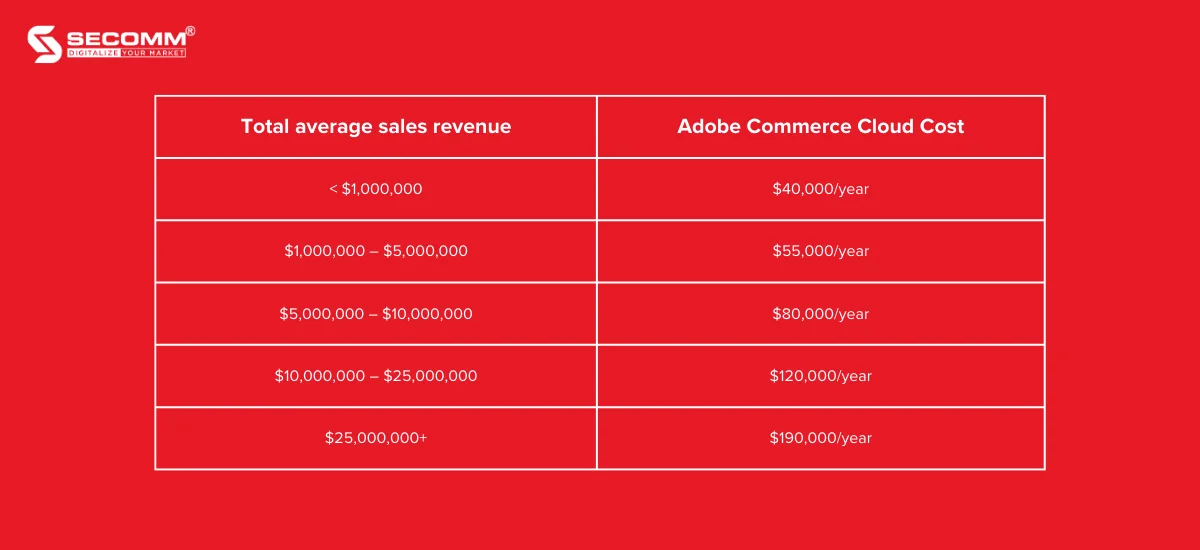
For the On-Cloud version, businesses also need to consider additional costs such as domain, interface, website development, and extensions. The cost to complete an Adobe Commerce Cloud website will be around $150,000/project for the first year, depending on the complexity of the website system.
In general, Adobe Commerce (Magento) is a perfect choice for large businesses with high feature requirements, so the cost of building an eCommerce website on this platform will be relatively high compared to other eCommerce platforms.
However, finding the best-suited platform will depend on various factors such as strategic models, business scale, deployment time, and budget.
With deep expertise and the development of complex eCommerce systems for clients such as Changi Airport Group (Singapore), Trentham Estate (Australia), and The Warehouse (Vietnam), SECOMM understands the challenges in choosing a platform and deploying eCommerce that businesses are facing.
Contact SECOMM now or call directly at the hotline number (028 7108 9908) for free advice on the eCommerce website building roadmap!
Related article:
 2
2
 7,356
7,356
 0
0
 1
1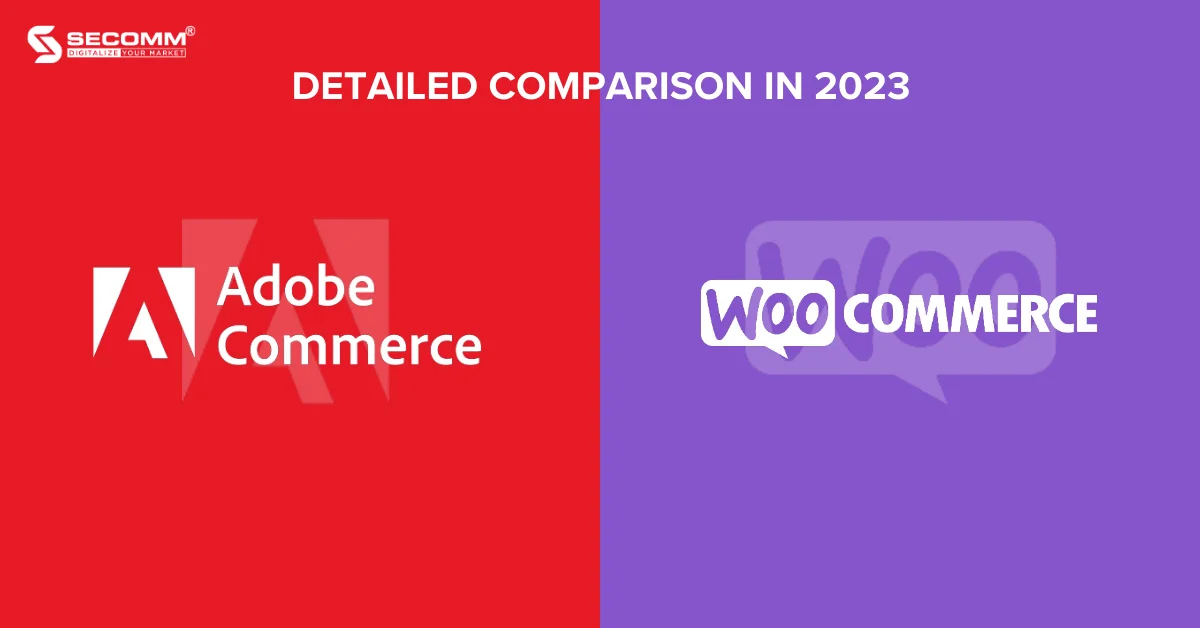
Among the eCommerce platforms that businesses consider choosing to develop their online stores, the two names Adobe Commerce and WooCommerce are always put on the scale for comparison.
Both are suitable for small and large businesses to build websites due to their flexible customization capabilities and high scalability. However, there are significant differences between WooCommerce and Adobe Commerce that are worth noting.
Adobe Commerce, formerly known as Magento Commerce, is an open-source eCommerce solution designed for medium to large-scale businesses, particularly those undergoing rapid growth and with high demands for customization and scalability.
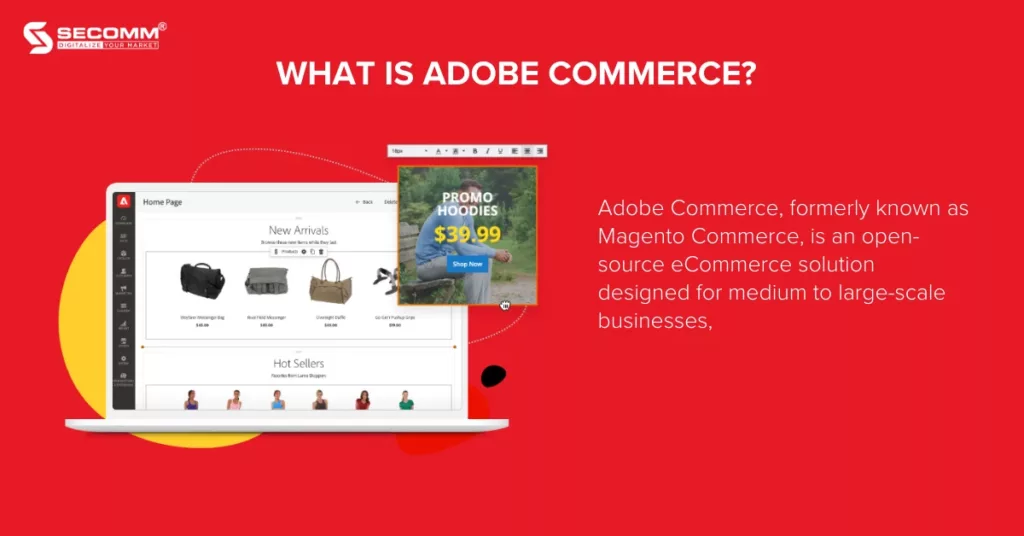
Currently, Adobe Commerce offers two different version options:
Related article: Top 20 eCommerce websites using Adobe Commerce (Magento)
WooCommerce is an open-source eCommerce plugin developed for the WordPress platform, a widely used Content Management System (CMS) for creating and managing websites.
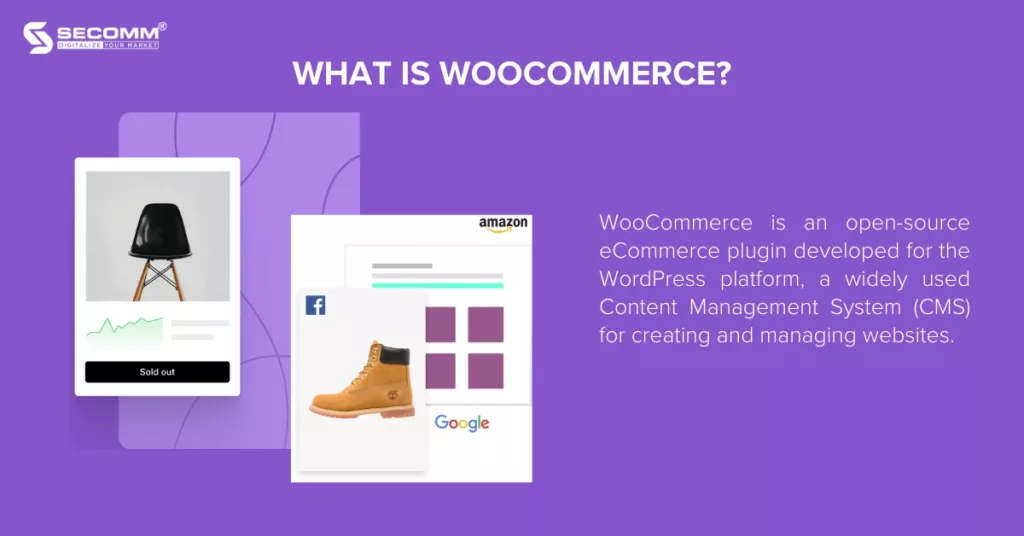
Consequently, WooCommerce is favoured by many businesses utilizing WordPress to develop their eCommerce websites.
Related article: Top 20 eCommerce websites using WooCommerce
Adobe Commerce and WooCommerce are two popular eCommerce platforms, but each platform serves different business needs due to differences in deployment costs, feature systems, scalability, and security.
The deployment costs of Adobe Commerce will depend largely on the version chosen by the business.
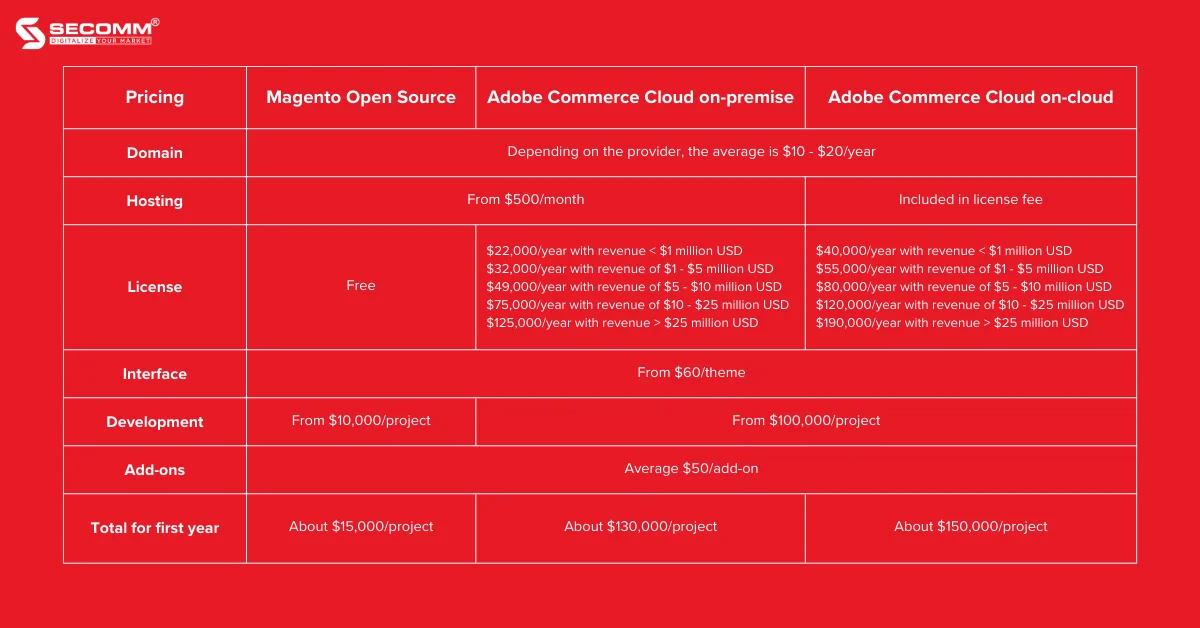
It can be seen that the deployment cost for an eCommerce website on Adobe Commerce is relatively high, starting from $15,000 per project for the Magento version and $130,000 per project for the first year with the Adobe Commerce version.
In contrast, the cost of using WooCommerce is entirely free, and the website construction cost is also relatively more budget-friendly compared to Adobe Commerce. Below are some estimated costs for deploying an eCommerce website on WooCommerce:
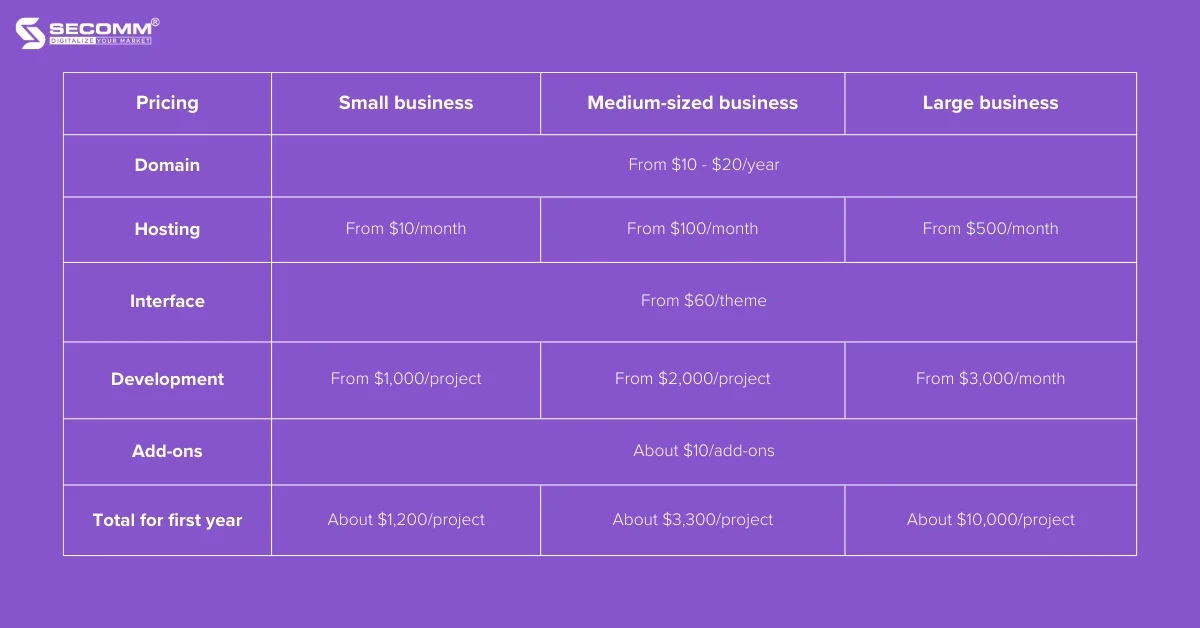
Note: These are only cost estimates. Actual costs may vary depending on factors such as needs, service providers, and optional features.
Adobe Commerce and WooCommerce are both comprehensive eCommerce platforms covering everything from A to Z. Both have their advantages and disadvantages, catering to the diverse functional needs of businesses.
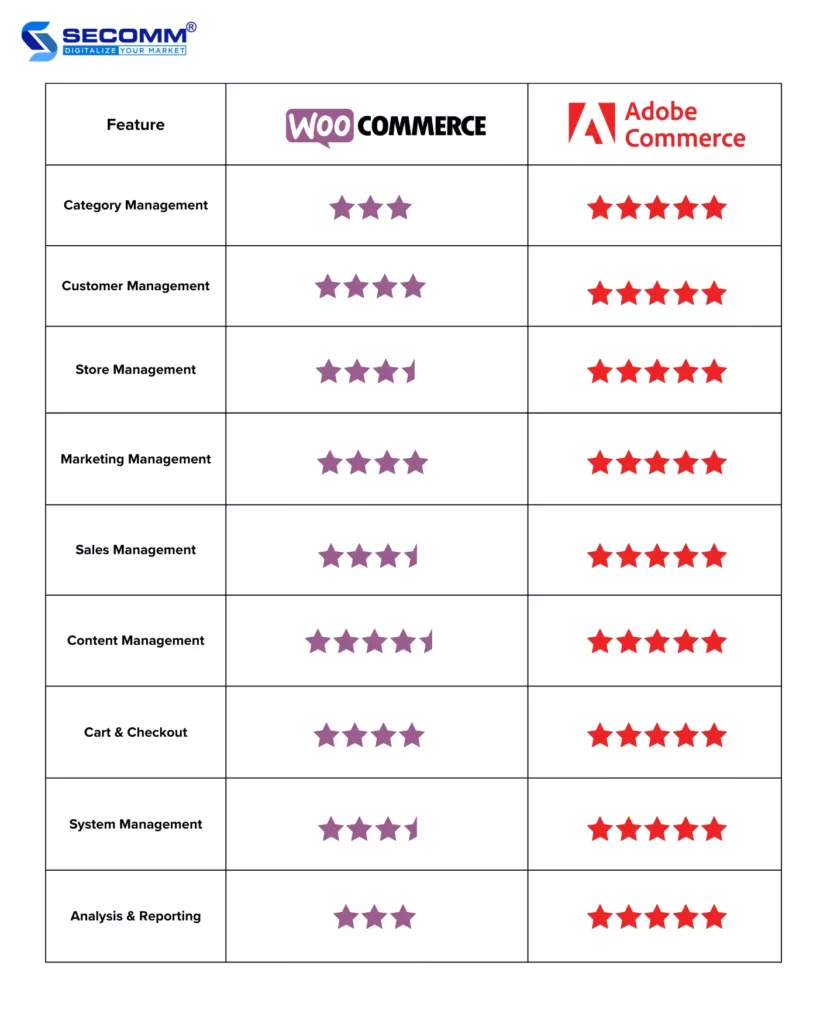
In addition to the basic feature set, businesses also need to consider advanced features that the system can accommodate.
It can be seen that the feature system of Adobe Commerce is more comprehensive than WooCommerce, covering both basic and advanced functionalities.
Therefore, for small to medium-sized businesses just starting in eCommerce, WooCommerce is a suitable choice. If the brand is a large enterprise with the need to build a large, complex online store, Adobe Commerce would be a perfect choice.
Read more: Top 10 Features To Increase eCommerce Website Revenue
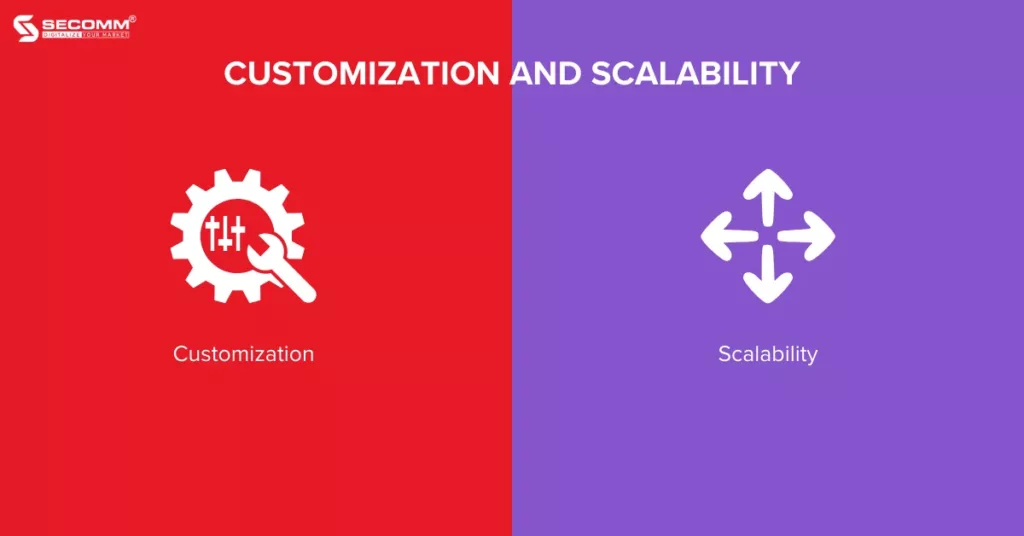
Adobe Commerce is an open-source platform, especially the Magento Open Source version, meaning developers can access the source code, making customization easier. This allows businesses to create features and integrate customizations to meet specific needs.
Similarly, WooCommerce also provides high customization capability with numerous available themes, plugins, and apps.
However, as a WordPress plugin, WooCommerce’s customization capability is not as extensive as Adobe Commerce.
Both platforms have high scalability to handle traffic and large transaction volumes. However, Adobe Commerce’s scalability is higher than WooCommerce’s, especially for businesses with large, complex product catalogues or significant inventory management needs.
In summary, Adobe Commerce offers higher customization and scalability capabilities compared to WooCommerce. Still, the website development process with Adobe Commerce is more complex, requiring developers with substantial experience and technical expertise.
Adobe Commerce and WooCommerce both provide features and tools for securing customer and business data. However, there are some notable differences in security capabilities between these two platforms.
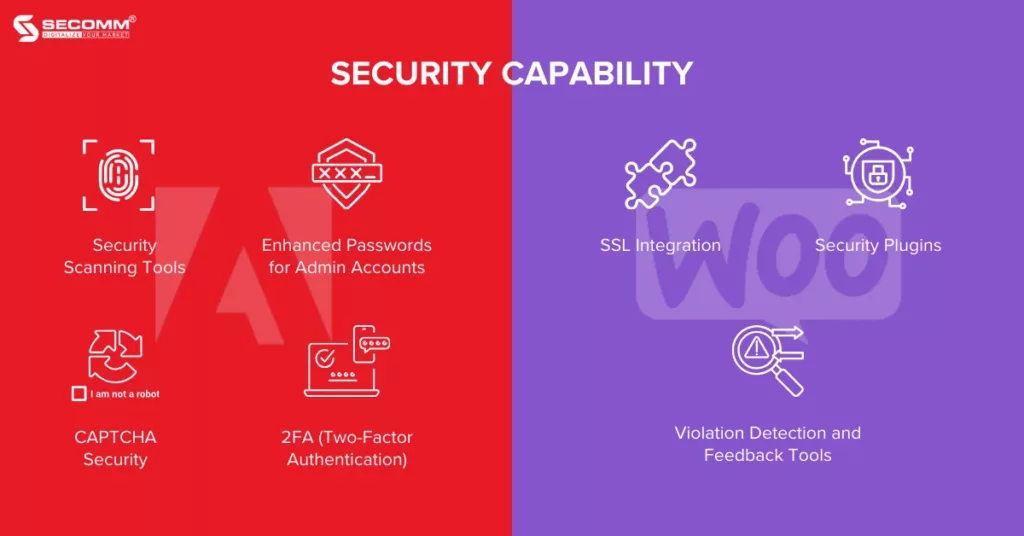
Adobe Commerce offers a range of security features and tools, including:
WooCommerce also provides some security features and tools, including:
Similar to the above factors, Adobe Commerce is generally considered to have higher security compared to WooCommerce.
It can be seen that Adobe Commerce is rated higher than WooCommerce in many aspects. However, while WooCommerce is known for being a user-friendly platform, making it easy for businesses without strong technical capabilities to quickly deploy, Adobe Commerce requires a professional team to build and manage a highly customized, scalable, and complex system.
In general, WooCommerce is suitable for small to large businesses using WordPress, wanting to start e-commerce deployment, and requiring basic customization and expansion solutions. However, Adobe Commerce offers flexibility, customization, and scalability, making it more suitable for corporations with complex system requirements.
In reality, the more flexible and customizable platforms with high scalability, the more complex and costly the deployment process becomes. Therefore, businesses need to consider the scale and development needs to make an appropriate choice.
With deep expertise and the development of complex eCommerce systems for clients such as Changi Airport Group (Singapore), Trentham Estate (Australia), and The Warehouse (Vietnam), SECOMM understands the challenges in choosing a platform and deploying eCommerce that businesses are facing.
Contact SECOMM now or call directly at the hotline number (028 7108 9908) for free advice on the eCommerce website building roadmap!
Read more: Shopify Plus vs Adobe Commerce: Key Differences 2023
 2
2
 6,270
6,270
 0
0
 1
1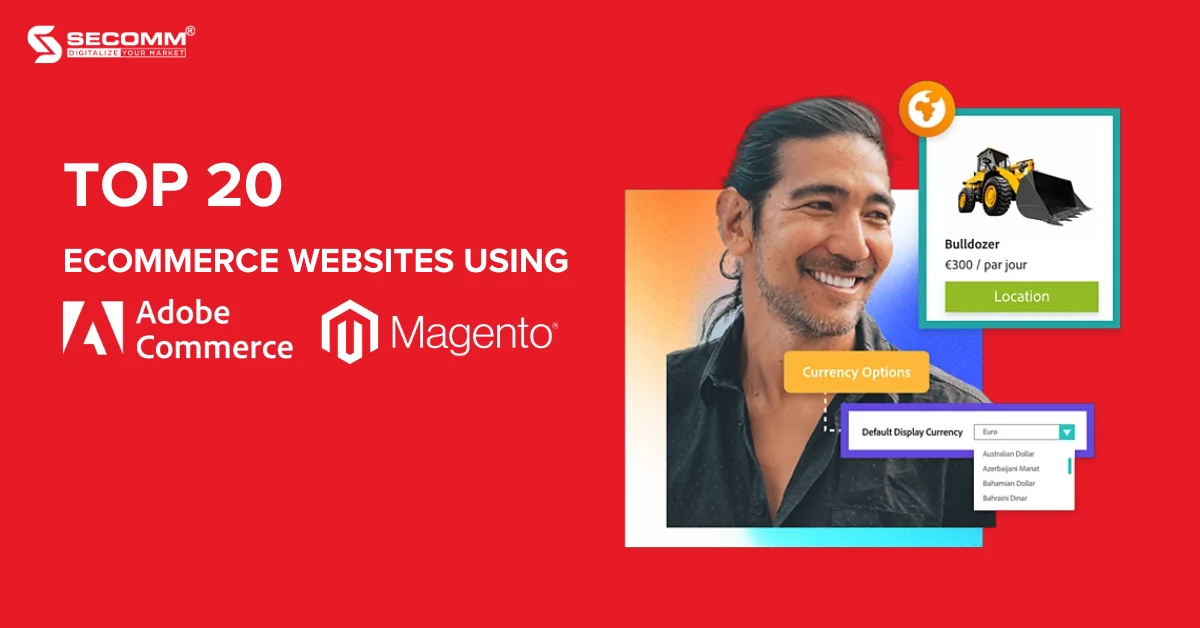
Adobe Commerce is an open-source eCommerce platform designed specifically for businesses ranging from medium to very large scales with high growth and significant customization and scalability needs.
Adobe Commerce has two versions, including:
According to reports from W3Techs and Adobe Commerce, as of July 2023, there are a total of over 367,000 eCommerce websites using Magento and Adobe Commerce. Among them, Magento holds about 5% of the global eCommerce market share, and Adobe Commerce holds about 3% of the global eCommerce market share.
See more: What is Adobe Commerce? Should we use Adobe Commerce?
Here is a list of 10 famous international brands and 10 famous brands in Vietnam currently using Adobe Commerce.
HP is a multinational IT company based in Palo Alto, California, specializing in the development of personal computers, printers, and related supplies, as well as 3D printing solutions.

HP deployed its first Magento Open Source 1 (formerly known as Magento Commerce) website in Thailand and Indonesia in 2013. When opening stores in China, they decided to switch to the Adobe Commerce version to support customers searching for products globally.
With Adobe Commerce, HP can further optimize the shopping experience and implement new features more quickly, helping the business achieve its eCommerce goals.
ASUS is an abbreviation for Asus Software Unit Systems, a multinational conglomerate headquartered in Taiwan, specializing in the manufacturing of electronic products and computer hardware. ASUS was founded in 1989 and is currently one of the world’s largest computer manufacturers.

ASUS aimed to have a unified platform for both B2B and B2C eCommerce, so the business chose Adobe Commerce for its flexibility in integration, high customization, and streamlining of support processes.
Hydro Flask is a brand of thermal flasks and water bottles established in 2009 in Seattle, Washington, USA. The brand is known for its high-quality, well-insulated, and visually appealing products.

Hydro Flask utilized Magento Open Source to build and develop its eCommerce website due to its ability to provide the necessary features and functionalities.
Filson is an outdoor gear manufacturing company based in Seattle, Washington, USA. The company was established in 1897 by Charles Filson, a tailor and cobbler. Filson specializes in producing high-quality, durable products designed for outdoor activities such as camping, fishing, hiking, etc.

In 2022, Filson adopted Magento 2 to build its eCommerce website. With the microservices architecture of Magento 2, Filson can easily customize and scale its eCommerce website as needed.
Alshaya is one of the major franchise operators globally, managing brands such as American Eagle Outfitters, H&M, Debenhams, Victoria’s Secret, Bath & Body Works, The Body Shop, Boots, and M.A.C in the United Arab Emirates (UAE). As shopping habits began to change, Alshaya gradually shifted towards developing its eCommerce sector and decided to choose Adobe Commerce to build its website in 2017.
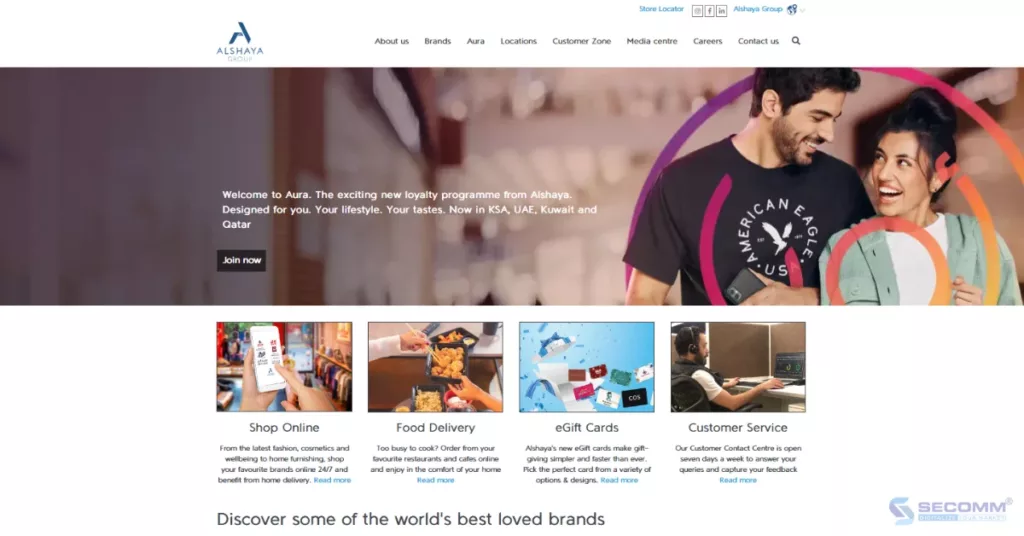
“Thankfully, when COVID-19 hit, we had already built up the digital framework to launch new websites quickly. And because we had built our approach on the Adobe Commerce global reference architecture, we were able to leverage parent configurations rather than building new sites from scratch. With IT complexity removed from the equation, we were able to roll out the new sites in a matter of weeks.” – Marc van der Heijden, Chief Technology Officer, Alshaya Group.
Catbird is a high-end jewelry brand established in 2004 in New York City, USA. The brand is known for its delicate and artistic designs. Catbird’s products are crafted from various materials, including gold, silver, gemstones, etc.

Catbird has utilized Adobe Commerce to build custom functionalities for the jewelry eCommerce industry, including notifications for available, and out-of-stock items, and advance delivery notices to ensure customers can view complete inventory. According to Ali Ahmed, the Founder of Imagination Media, “Like Catbird, Adobe Commerce is a truly robust, dazzling, and creative platform that allows us to build and create basically whatever we want because it is open and extensible”.
DKNY, short for Donna Karan New York, is a high-end fashion and apparel brand founded by designer Donna Karan in 1989. DKNY is known for its youthful, modern, and highly practical fashion products.

DKNY leveraged Magento to build its fashion eCommerce website in 2023. Thanks to the advantages of open source, DKNY prioritizes user interface personalization, showcasing its distinctive brand style, and providing advanced features such as intelligent product search, product previews, and product customization.
Ranking: 95,191 (US) & 173,066 (Global)
Volkswagen Classic Parts is a part of the Volkswagen Group, responsible for supplying genuine replacement parts for classic Volkswagen vehicles. Volkswagen Classic Parts is headquartered in Wolfsburg, Germany, and operates in over 100 countries worldwide.
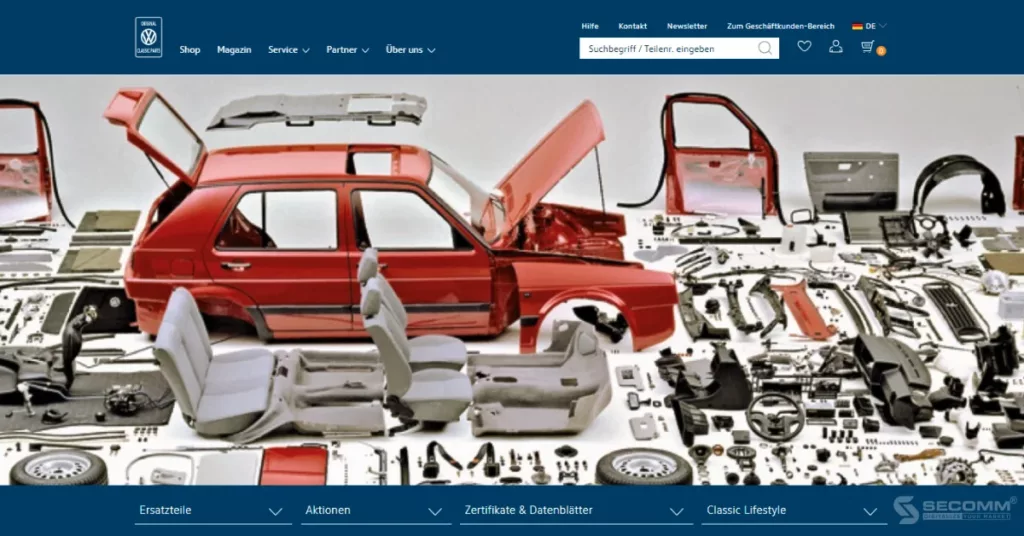
The eCommerce website for Volkswagen parts features around 60,000 accessories, catering to the needs of both new and seasoned Volkswagen enthusiasts, bringing joy to fans of classic Volkswagen vehicles.
Initially, Volkswagen used Magento Commerce 1 for several years and reaped significant benefits from this open-source platform. Recently, Volkswagen Classic Parts decided to upgrade to Adobe Commerce and utilize Adobe Experience Manager to further develop the brand in the eCommerce market.
Laybyland is a ‘Buy Now, Pay Later’ retail business for consumer electronics established by Stuart Duff in 2012 in Australia. After two years of operation, Laybyland realized that the current CMS system using Drupal was not meeting the operational requirements and struggled to handle the growing data volume.

Therefore, Laybyland chose SECOMM to migrate the website to a robust eCommerce platform like Magento Open Source. With over 10 years of operation, thanks to a unique business strategy—the exclusive Lay-by payment process allowing customers to customize the time and frequency of instalments when shopping online—and a professionally controlled eCommerce system by SECOMM, Laybyland expanded the ‘Buy Now, Pay Later’ retail system to two other major markets, the United States and New Zealand.
“SECOMM’s technical expertise allowed us to successfully overcome these development challenges and deploy a website that has performed exactly as we wanted from day one.” – Stuart Duff, CEO at Laybyland
Covento is a young business in the renewable energy sector, operating in five countries: Denmark, Germany, Spain, the Netherlands, and France. At Covento, users can find the necessary spare parts/components for turbine models from various manufacturers and suppliers.
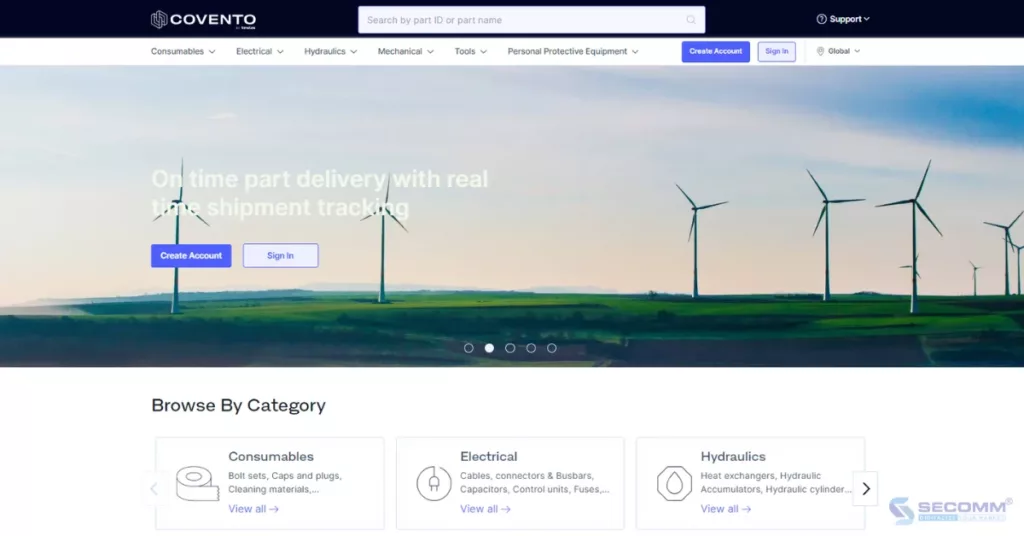
Jill Ashley Brandt, CEO of Covento, plans to leverage the continuous improvements of Adobe Commerce to make Covento more user-friendly for buyers and suppliers in the U.S. market, serving the goal of expanding the business.
Di Dong Viet is a reputable brand in the field of electronic devices and a strategic partner of global technology conglomerates such as Apple, Samsung, OPPO, Sony, ASUS, and more.
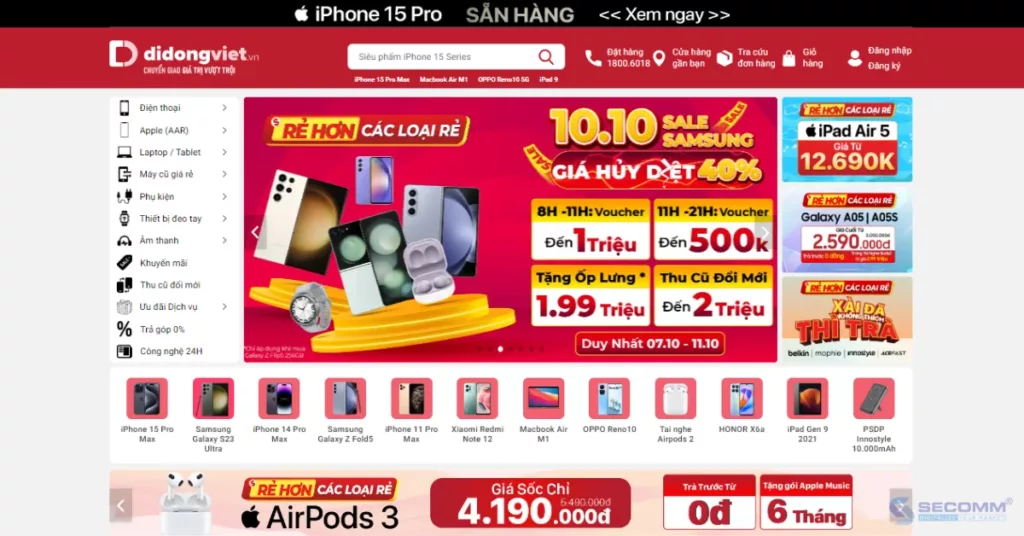
By using Magento Open Source, Di Dong Viet has successfully built a high-quality eCommerce website with features such as product management, shopping cart, online payment, order management, and various other extended features to create a convenient online shopping experience for customers.
CGV is one of the top 5 largest cinema chains globally and is a major film distributor and cinema chain in Vietnam, alongside Galaxy, Lotte Cinema, BHD Star Cineplex, and CineStar.

CGV has built an eCommerce website on the Magento Enterprise platform (the paid version of Magento, now known as Adobe Commerce) to meet the feature requirements suitable for large enterprises like CGV.
Established in 2009, Kids Plaza is a major player in the eCommerce race in the Baby industry. Kids Plaza has deployed an eCommerce website on the Magento platform to efficiently manage a diverse and extensive product portfolio. The brand regularly runs promotional programmes such as gift shopping promotions, flash sales, buy 5 get 1 free, and loyalty point accumulation for attractive rewards.

This has contributed significantly to the increase in website traffic on every promotional occasion, and deploying Magento can enhance customization and scalability to handle sudden traffic increases. On average, the website receives about 1 million visits per month.
Hoang Phuc International is a high-end fashion retailer for Kappa, Ecko Unltd, Superga, Replay, and Staple, established in 1989. After three decades of traditional business development, the brand decided to transition to participate in the eCommerce market.
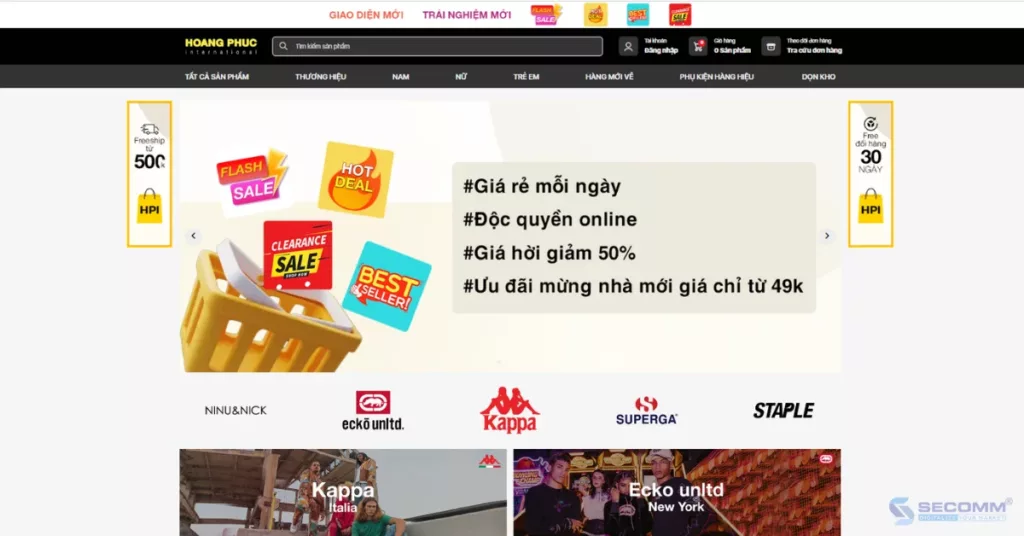
To successfully develop the current eCommerce website, Hoang Phuc has used and converted many platforms. As of now, the business is using the Magento platform – an open-source eCommerce platform specializing in eCommerce.
Bach Long is one of the popular retailers of smartphones, tablets, and technology accessories in Vietnam. Similar to other consumer electronics retailers like CellphoneS, Di Dong Viet, Bach Long Mobile also chose the Magento platform to build their websites.

Therefore, the brand’s website has seen significant improvements in features, customization capabilities, and performance, helping the company attract more customers, grow its market share, and increase revenue and profits.
On Off is a lingerie brand established in 2005 with a mission to bring daily comfort to everyone.

On Off has chosen the Magento Open Source version, the free version of Magento, to build its eCommerce website to meet the company’s specific needs for features, customization capabilities, and system scalability.
EROPI is another prominent jewelry brand in Vietnam, specialising in distributing various types of gold, silver, jewelry, gemstones, pearls, wedding jewelry, and feng shui jewelry. After many years of operation, the company has not only expanded its chain of stores nationwide but also developed an online sales channel to meet the shopping needs of customers.

The primary online channel that EROPI focuses on is the eCommerce website built on the Magento Open Source platform with superior customization capabilities. This allows EROPI to develop advanced features and flexible scalability, ensuring the long-term development goals of the business.
At first, the company was established in 2006 under the name Uma Furniture Supermarket and officially changed its name to Baya Furniture and Decoration Supermarket in 2019. Despite the name change, the brand still retains its core values and brings customers high-quality furniture with simple, elegant designs, in line with contemporary trends, featuring neutral colours, and each piece having its own beauty.
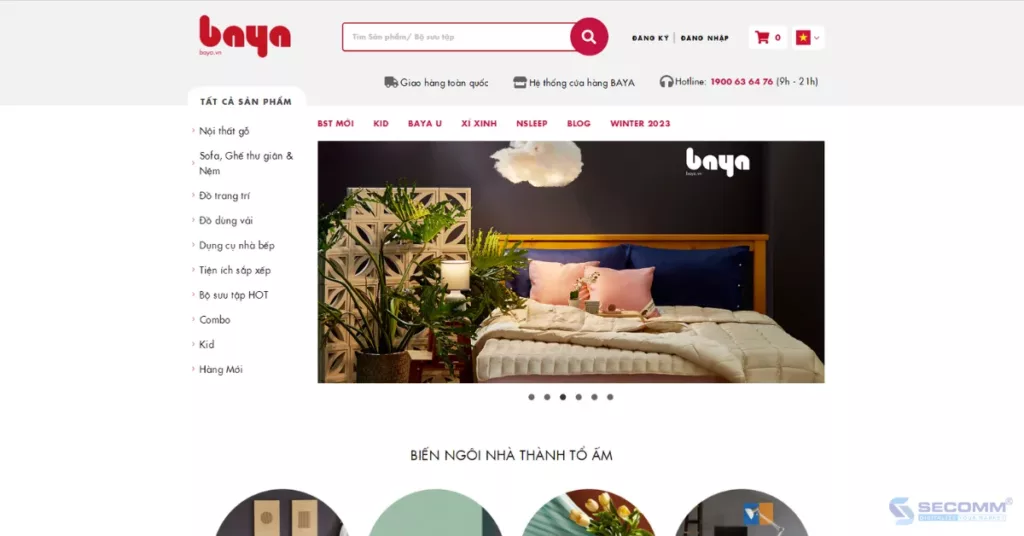
As of the current time, Baya’s website attracts nearly 100,000 visits per month, thanks to the proper investment in building an eCommerce furniture website with the open-source Magento platform. The website features an attractive, captivating interface that is user-friendly.
Rohto is a well-known Japanese pharmaceutical and cosmetic brand established in 1899, specialising in manufacturing and selling eye care, skincare, lip care, hair care, cosmetics, pharmaceuticals, etc.

Rohto Vietnam’s eCommerce website is built on the Magento Enterprise version. Through Magento, the website is designed with an attractive and user-friendly interface, integrating features and customer support services to make shopping easier and more convenient.
Annam Gourmet, born out of a deep passion for European cuisine by the founders of the Annam Group, has been a strong player in the Vietnamese market for over 20 years. The Annam Gourmet store chain has expanded significantly, offering imported high-quality products such as premium food, wine, beverages, and cosmetics.

While Annam Gourmet had an existing online presence, it was primarily used for brand development, and the effectiveness of eCommerce was not a primary focus. To ensure the website is fully developed and operates smoothly, Annam Gourmet chose SECOMM and strategic partner Synova to develop the eCommerce website on the Magento Open Source 2 platform.
Here is a list of the top 20 eCommerce websites using the Adobe Commerce (Magento) eCommerce platform in both the international and Vietnamese markets.
With deep experience and the development of complex eCommerce systems for clients such as Changi Airport Group (Singapore), Trentham Estate (Australia), and The Warehouse (Vietnam), SECOMM understands the challenges in choosing a platform and implementing eCommerce that businesses are facing.
Contact SECOMM now or call directly on the hotline (028 7108 9908) for free advice on developing eCommerce on the Adobe Commerce (Magento) platform!
 2
2
 9,466
9,466
 0
0
 1
1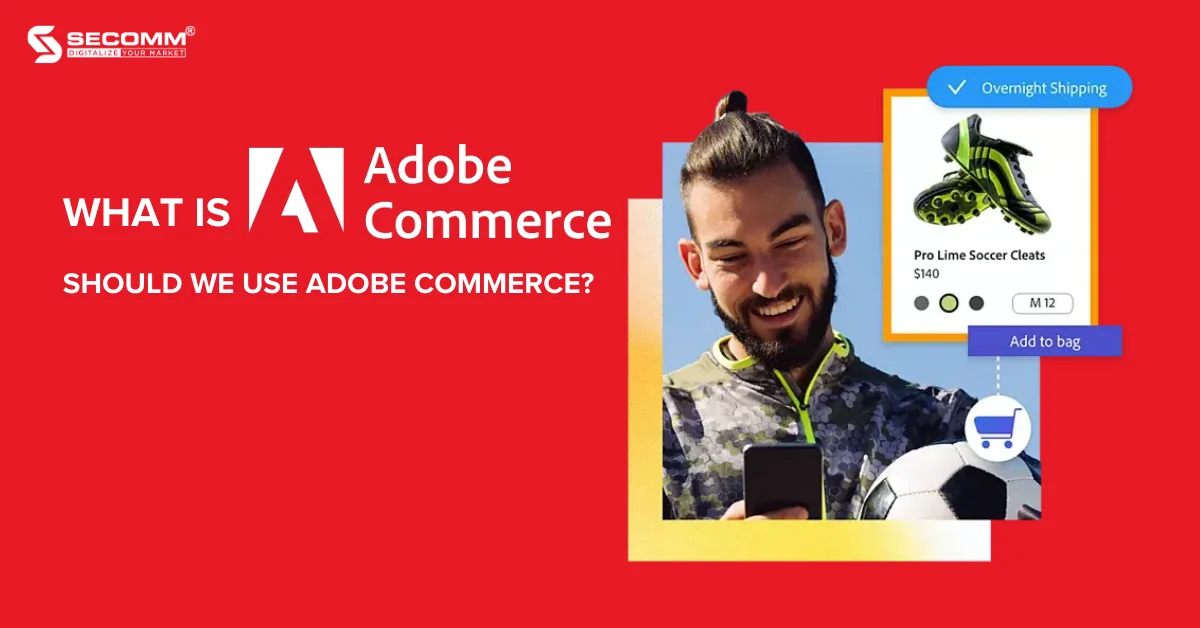
According to Adobe’s report in January 2023, there are more than 100,000 websites built using Adobe Commerce. Among them, over 50,000 websites are actively running, and more than 50,000 websites are in the deployment phase. This is an extremely impressive number for a platform specialized in supporting large enterprises like Adobe Commerce.
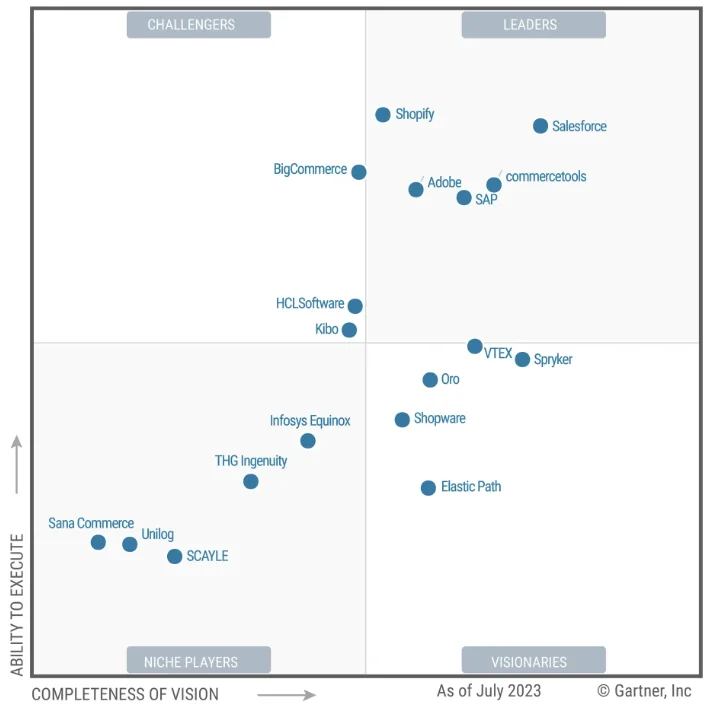
In 2023, Adobe Commerce was recognized by Gartner for its outstanding achievement, ranking first in the list of leading platforms in digital commerce for seven consecutive years.
Adobe Commerce is an open-source eCommerce platform designed specifically for businesses ranging from medium to very large scale, offering high customization and scalability.
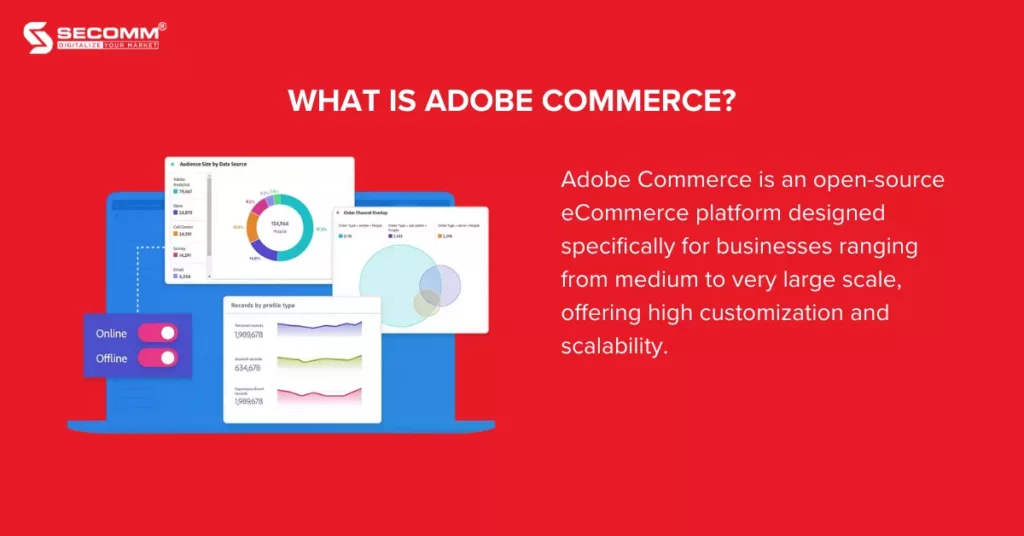
Formerly known as Magento Commerce, it was founded in 2007 by Roy Rubin and Yoav Kutner in Culver City, California, USA. After several changes of ownership, in 2018, Adobe acquired Magento for $1.68 billion and rebranded it as Adobe Commerce. Currently, Adobe Commerce is part of the Adobe Experience Cloud, a product and service suite helping businesses create, manage, and distribute digital experiences.
Adobe Commerce has two main versions: Adobe Commerce Cloud and Magento Open Source.
Adobe Commerce Cloud is a paid version, deployed and managed on the cloud by Adobe. It is divided into two types: on-premise, allowing businesses to be self-sufficient in hosting, and on-cloud, providing hosting at a specific cost.

Magento Open Source is a free version that can be downloaded and used by anyone. It provides essential functionalities for creating and managing online stores.
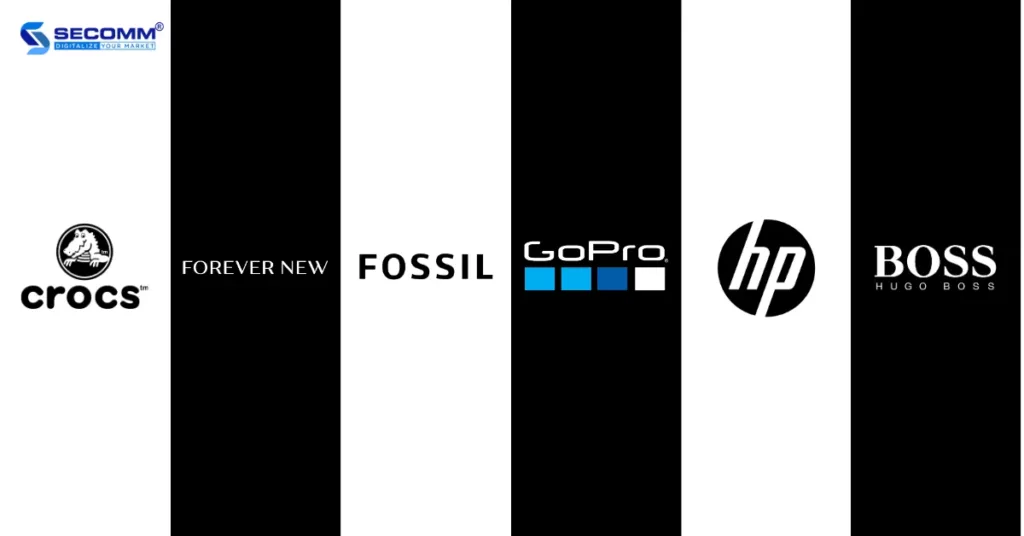
In addition, Adobe offers several additional versions of Adobe Commerce:
The cost of using Adobe Commerce depends on the version being used.
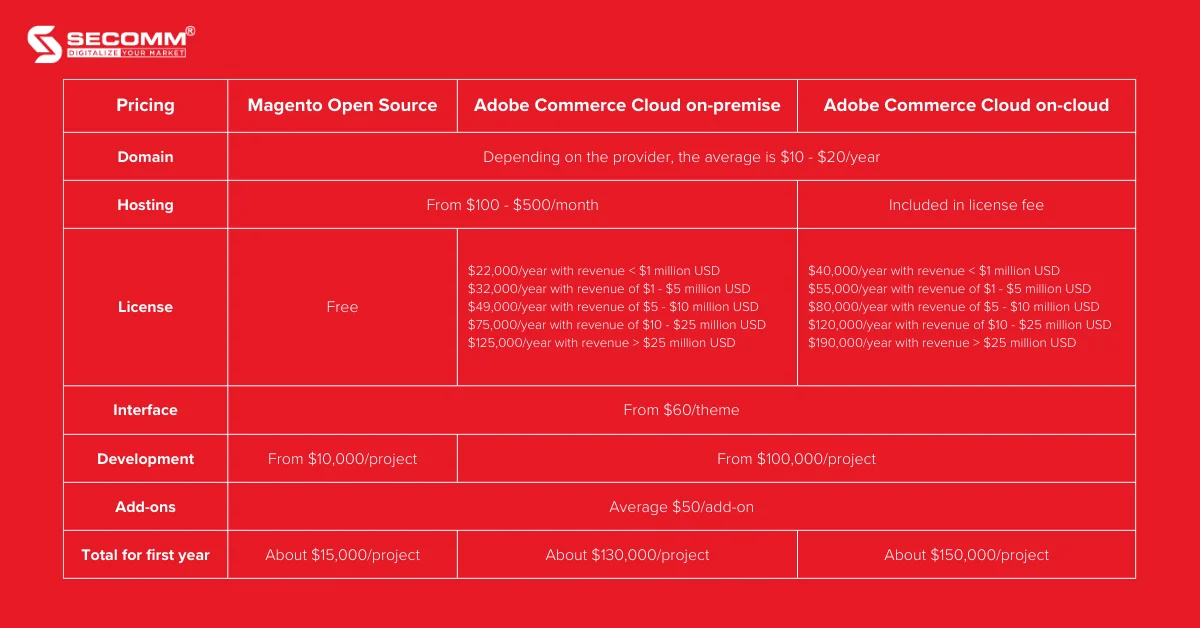
For Adobe Commerce Cloud (On-Cloud): Adobe provides hosting and operates Adobe Commerce on its cloud. License costs for Adobe Commerce on-cloud range from $40,000 to $190,000 per year, depending on the system’s complexity, scale, and business requirements.
For Adobe Commerce Cloud (On-Premise): Businesses need to purchase licenses and install the software on their servers. License costs for Adobe Commerce on-premise range from $22,000 to $125,000 per year, depending on system complexity, scale, and business needs.
For Magento Open Source: Magento provides a free license, and the overall cost is generally more reasonable compared to the two solutions above. However, the available built-in functionalities are limited, and additional investments are required for feature development and integration with third-party services.
In addition to license costs, businesses also need to invest in interface design, development costs, extension utility costs, and employee salaries.
Note: The cost of using Adobe Commerce can be significantly influenced by factors such as business scale, feature requirements, integration needs, and customization requirements.
Read more: Shopify Plus vs Adobe Commerce: Key differences 2023
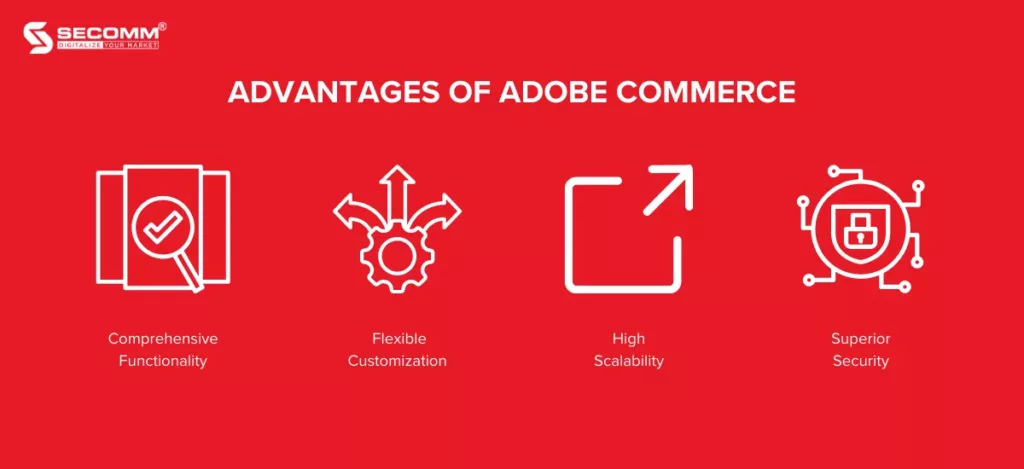
Adobe Commerce is a powerful eCommerce platform, providing all the essential features for building and managing a comprehensive eCommerce website. From product portfolio management, content creation, and conducting transactions, to marketing campaigns and customer management, Adobe Commerce is equipped with all the necessary tools.
In addition to basic features, Adobe Commerce offers many extensions with advanced functionalities.
One of the significant strengths of Adobe Commerce is its globally experienced support community, consisting of professional developers who assist in finding and solving any technical challenges or customizations needed for businesses. This creates favourable conditions to meet every requirement and goal of the business’s eCommerce.
Adobe Commerce possesses all the advantages of an open-source platform with flexible customization capabilities. Especially with ownership and control over the entire source code, businesses can easily customize code sections within the system, easily update, or even develop new features based on specific business needs.
In addition to customization capabilities, Adobe Commerce has excellent scalability for websites. Adobe Commerce allows businesses to expand from one website to multiple websites, one store to multiple stores while still managing everything on the same system. Additionally, Adobe Commerce supports multilingual and multi-currency conversions, helping businesses expand globally.
High-security capability is also a standout advantage of Adobe Commerce with regular system monitoring, proposed security solutions, enhanced security for administrators, and the ability to prevent bots or unauthorized malicious code. This platform helps businesses minimize potential risks from data systems and transaction processes on the system
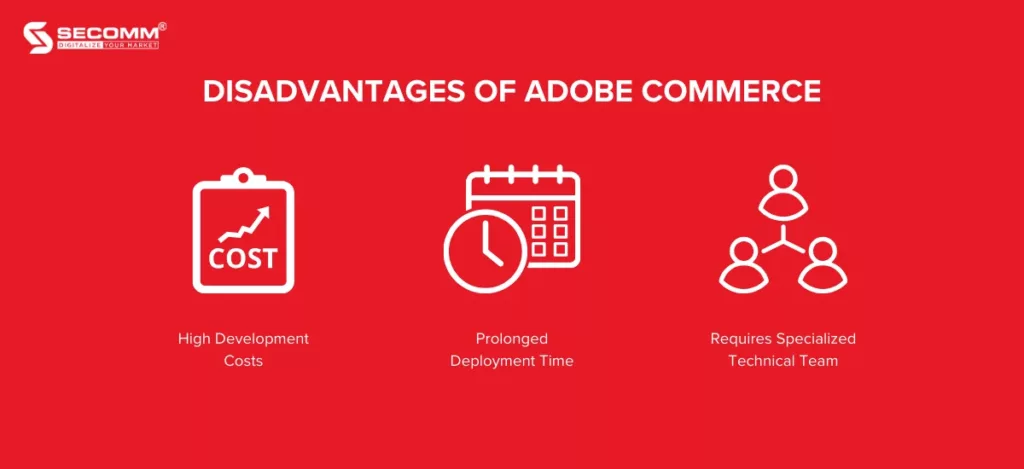
Due to its numerous outstanding features in functionality, customization capabilities, scalability, and high security, the cost of owning an Adobe Commerce website is inevitably high. As estimated earlier, websites developed on the Adobe Commerce platform often have higher costs compared to other platforms, ranging from $10,000 to $300,000 depending on the system’s complexity.
A complete Adobe Commerce project requires a deployment time ranging from 3 months to 1 year. This extended duration slows down the digital transformation process of businesses, making it challenging for them to keep up with the pace of development among competitors and stay updated with market trends.
To build and operate an in-depth eCommerce website system tailored to the specific characteristics of each product and industry with high performance, businesses require a specialized technical team with in-depth expertise. This is particularly crucial for complex Adobe Commerce projects, demanding a high level of technical specialization and experience on the Adobe Commerce platform.
As one of the world’s most renowned sportswear brands, Nike aimed to adopt a personalized eCommerce approach with a focus on mobile device experience. Hence, Nike chose Adobe Commerce to enhance its functionality, concentrating on user experience, increasing interaction, and optimizing images and CTA buttons for smaller screens.
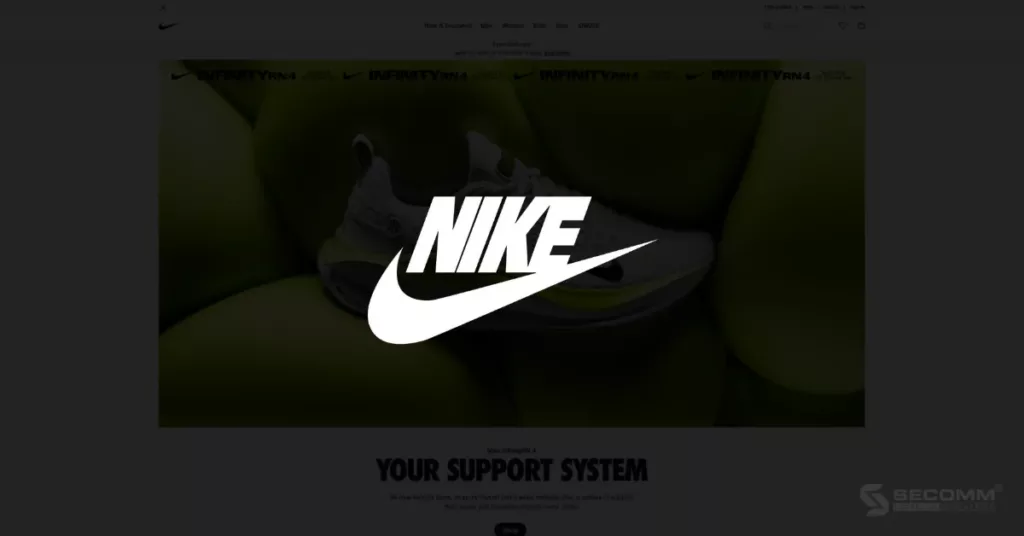
Additionally, customizing and optimizing the eCommerce website-building method through the Headless Commerce API architecture contributed to Nike’s success, turning the brand into a market leader and gaining more market share than its competing counterparts.
Canon, a multinational corporation based in Japan specializing in manufacturing cameras, printers, optical equipment, digital imaging devices, and office equipment, needed to build an eCommerce website to meet digital transformation needs after a long period of traditional business. Canon decided to select Adobe Commerce to deploy a comprehensive eCommerce solution.
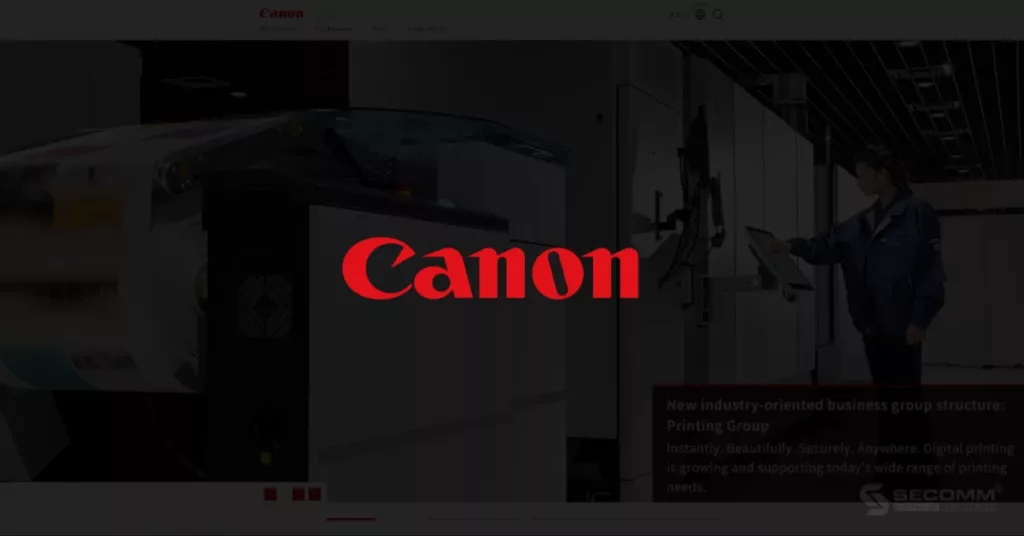
“The Commerce and Experience Manager tech stack helps us compress projects that previously took months of development time into just weeks. We can do so much more than before — if we’re developing a new component and trying to get it out within a couple of weeks, we can do that now” — Michael Lebron, Senior Director and Head of Front Office Applications
Annam Gourmet is a premium food and beverage retail brand in Vietnam established in 2001 by a French-Vietnamese couple. Although Annam Gourmet had an online presence before, it was mainly used to develop the brand, and the effectiveness of eCommerce was not emphasized. Annam Group, the parent company of Annam Gourmet, along with partner SECOMM, chose to use Magento 2 to build an eCommerce website.
Currently, Annam Gourmet’s Magento 2 website has officially launched, operating stably and effectively, helping the business successfully transform in the eCommerce market. Besides the Annam Gourmet project, Magento is also chosen by the Annam Group for other retail eCommerce systems within the group, such as The Warehouse (wine retail) and Nespresso.

In general, Adobe Commerce is a suitable eCommerce platform for businesses of all sizes, from startups and SMEs to large corporations. However, issues related to budget, time, and specialized teams have made many small and medium-sized enterprises hesitate to use Adobe Commerce for deploying eCommerce websites. Therefore, Adobe Commerce is often invested in by large enterprises to build in-depth eCommerce systems.
With profound experience and the development of numerous complex eCommerce systems on Adobe Commerce, such as Laybyland (Australia, the US, New Zealand), Jasnor (Australia, New Zealand), and The Warehouse (Vietnam), SECOMM understands the challenges in the platform selection and eCommerce deployment that businesses are facing.
Contact SECOMM today or call directly at the hotline (028 7108 9908) for a free consultation on deploying Adobe Commerce for your brand.
 2
2
 8,918
8,918
 0
0
 2
2
According to Grand View Research, the global jewelry eCommerce market is predicted to reach USD 117.8 billion by 2027, with a CAGR of 12.2% from 2022 to 2027. According to Research and Markets, the United States is the largest jewelry eCommerce market in the world, with expected revenue of USD 45.6 billion by 2027. Other regions, including China, India, and Southeast Asia, are also experiencing rapid growth.
Several jewelry brands have successfully implemented eCommerce early on and achieved unexpected success, such as Cartier, Tiffany & Co., PNJ, ANA LUISA, Missoma, etc. The common characteristic of these brands lies in comprehensive eCommerce websites that cater to customers’ needs for purchasing jewelry and gemstones.
For more information:
With nearly 10 years of experience in eCommerce, SECOMM has outlined the common journey of building jewelry eCommerce websites in Vietnamese businesses.
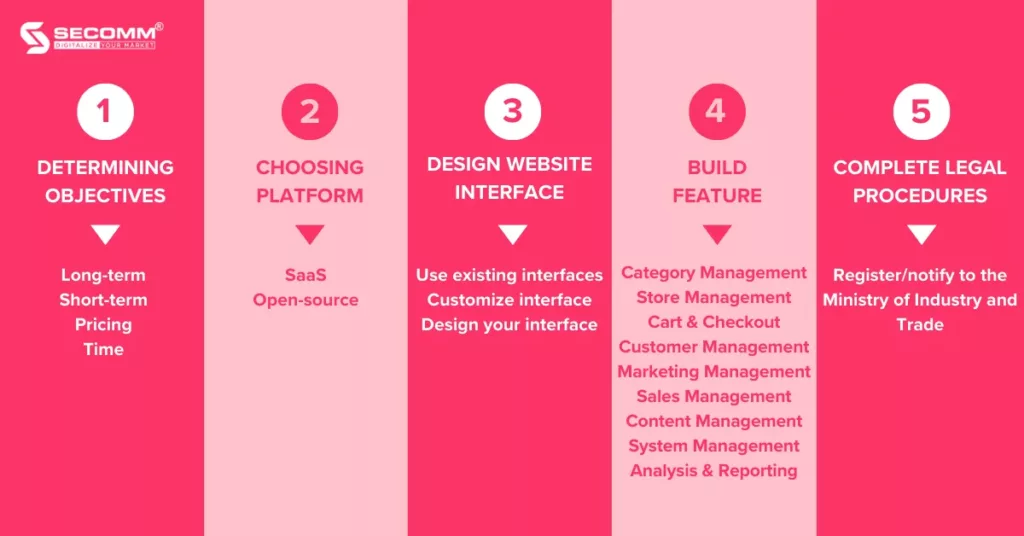
Firstly, businesses in the jewelry industry need to clearly define their goals and prioritize each of these goals when planning the development of an eCommerce website.
In the long-term vision, businesses may be interested in building and strengthening their brand presence in the online market, exploring the potential of online customers, and optimizing business operations from online to offline.
For short-term objectives, businesses may prioritize monitoring and analyzing customer behaviour on the website, assessing the effectiveness of online marketing campaigns to improve sales performance.
When setting objectives, the timeframe is also a crucial factor. Businesses may choose to deploy quickly to penetrate the eCommerce market or even opt for a gradual deployment to have time for testing, evaluation, and adaptation to this large and competitive market.
Currently, two popular types of platforms support the development of eCommerce websites: SaaS (Software as a Service) and open source.
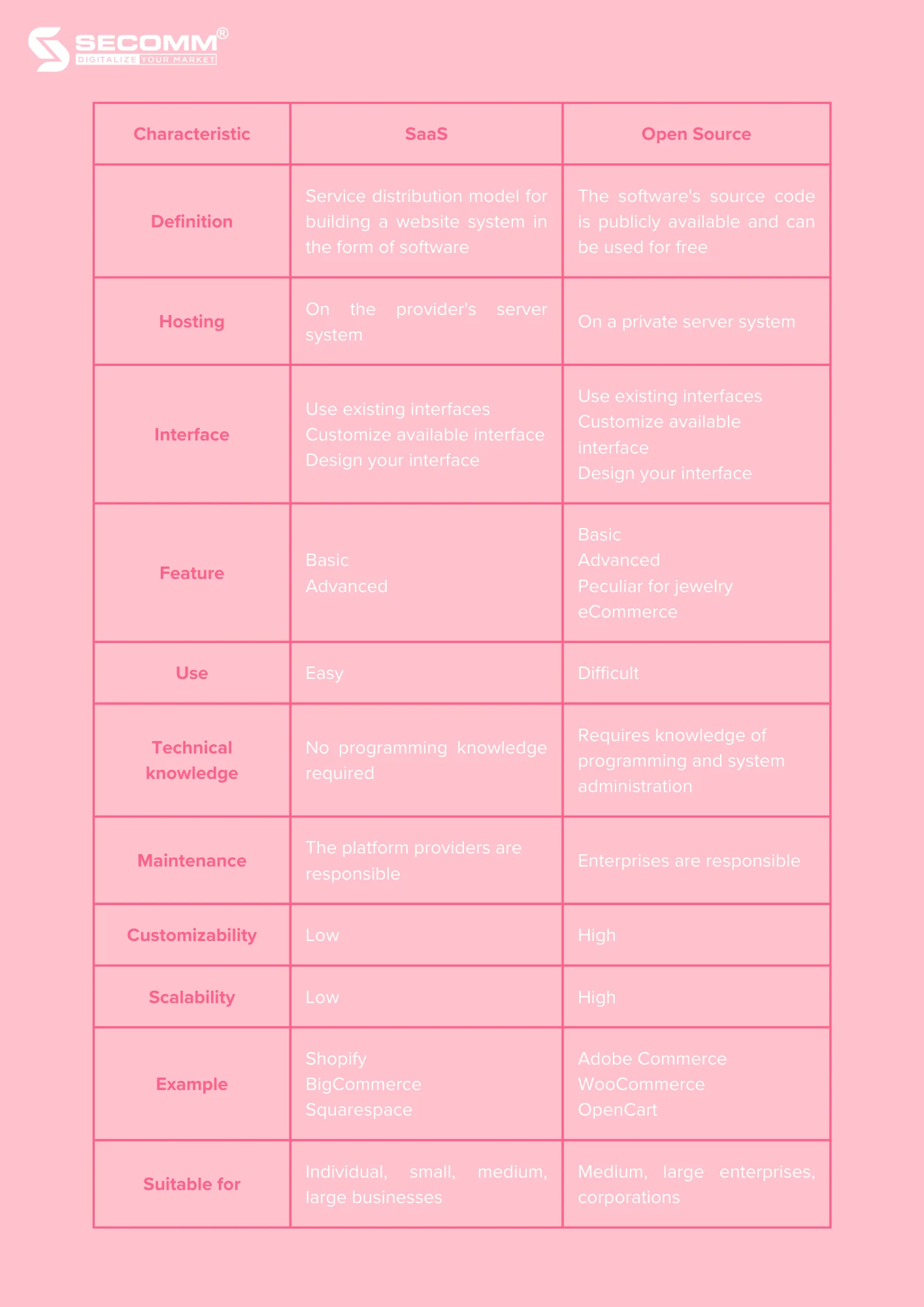
Read more:
Typically, new businesses entering the eCommerce market will choose SaaS platforms to save time and costs during the initial stage of building an eCommerce website. Subsequently, businesses may transition to open-source platforms for the development of more advanced eCommerce websites.
However, businesses can also choose an open-source platform right from the start to build a basic eCommerce website and later upgrade the system over time on the same platform to avoid the need for platform migration in later stages.
When designing the website interface, businesses need to meet basic criteria such as UI/UX standards, reflecting the brand’s characteristics, presenting products consistently, providing complete usage instructions, etc.

Currently, there are three ways to design the interface, including:
In this stage, businesses often choose ready-made themes to save costs, but some financially stronger businesses may opt for the other two methods to better position their brand.
In this stage, businesses can prioritize the development of basic functions to meet the most fundamental needs when operating a jewelry eCommerce website. Some essential functions that should be included in a jewelry eCommerce website are:
After successfully completing the features, testing, and launching of the website, the business needs to fulfil legal procedures related to eCommerce operations. According to Decree 52/2013/ND-CP issued by the Government of Vietnam, individuals or organizations owning eCommerce websites for sales are required to notify or register with the Ministry of Industry and Trade through the Public Service Portal of the Ministry of Industry and Trade.
Note: Websites that operate for an extended period or fail to register/notify the competent management authority within the specified time frame may be subject to administrative penalties as stipulated by the regulations.
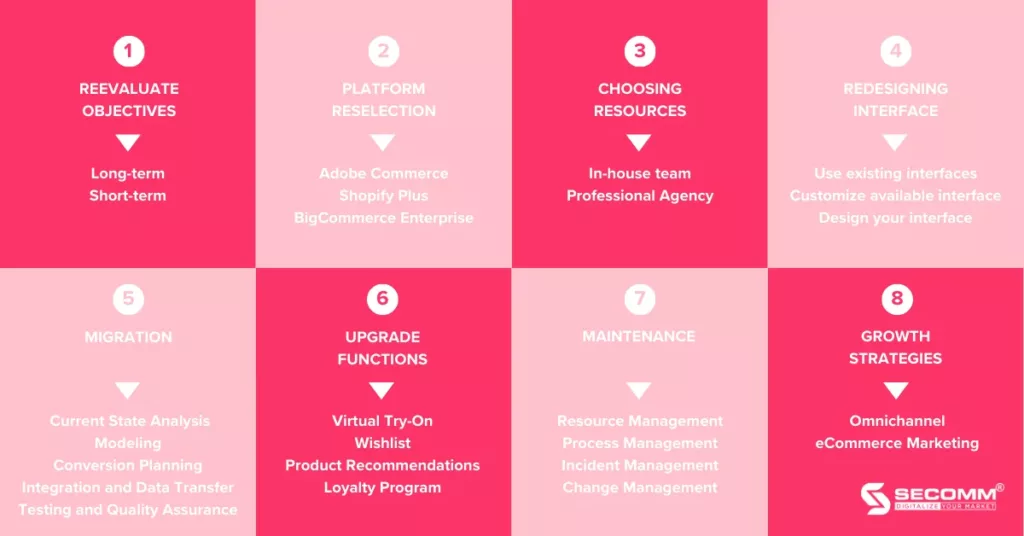
When a business is in the development phase and the market is undergoing significant changes, adjusting objectives becomes necessary. This is particularly crucial when leadership needs to review the business strategy and make decisions regarding investing in an eCommerce website, including both time and budget considerations.
In this phase, businesses often focus on setting short-term and long-term goals for the online jewelry business system. For long-term objectives, businesses may consider expanding the brand presence in the market, building a loyal customer program, and promoting the purchasing habits of jewelry and gemstone customers in the middle and upper classes. These goals lay the foundation for sustainable development and prosperity in the future.
Regarding short-term goals, businesses may concentrate on attracting additional potential customers, increasing revenue, and supporting the eCommerce marketing strategy. Tools such as Influencer Marketing may be prioritized to drive rapid growth and create immediate business opportunities.
Overall, establishing specific goals and adjusting them based on market conditions and business development is a crucial part of managing and succeeding in the eCommerce jewelry industry.
When basic SaaS platforms are no longer sufficient to support the expansion of the website system, businesses will need to transition to more specialized platforms such as Adobe Commerce, Shopify Plus, BigCommerce Enterprise to develop a more advanced eCommerce jewelry website.

Read more:
Of course, when switching platforms, businesses will face challenges such as conversion costs, time required for staff training on the new platform, and potential data loss during the platform migration.
To build a professional and complex eCommerce website, businesses need to choose suitable resources to implement the project. Generally, there are two main options: building an in-house team or partnering with a professional development partner. Regardless of the choice, specialized knowledge and experience in the chosen field are crucial.
When deciding to build an in-house team, businesses need to recruit and train IT and eCommerce personnel with knowledge and practical experience on the chosen platform. This may require a significant amount of time and financial resources to build a suitable workforce. However, this approach allows the business to have better control over resources and the ability to make adjustments, developing the website system according to specific requirements.
Another option is to collaborate with a professional development partner. In this case, businesses should seek a partner with extensive experience in eCommerce, a professional team, clear work processes, and the ability to handle complex projects. Collaborating with specialized units helps businesses learn and accumulate more experience while developing an eCommerce website that suits the specific characteristics of the jewelry industry.
Therefore, the choice between building an in-house resource and collaborating with a development partner depends on the goals, resources, and specific requirements of the business.
During the platform transition process, businesses may decide to keep the current website interface if the brand believes it still aligns with the strategy and the new platform. However, many businesses often choose to redesign the interface to ensure that the eCommerce website reflects the brand’s business strategy and the new platform accurately.

Similar to the previous stage, businesses have several options when designing the eCommerce website interface: using ready-made themes available on the market, customizing themes, and designing a unique interface.
In the jewelry industry, customizing or designing a unique interface is often prioritized to showcase the uniqueness and sophistication of the products. However, the final decision should be based on the business strategy and resources available.
After choosing a suitable conversion platform, the redesign of the system and platform conversion is crucial. This requires a high level of expertise from solution architects to design a system that can address the challenges the business is facing and align with the long-term development journey and business model of the enterprise.
In addition, the process of migrating data also needs to be carried out carefully to limit the risk of data loss or errors for the business. Typically, data conversion is automated as much as possible to avoid potential errors.
The platform conversion process includes the following steps:
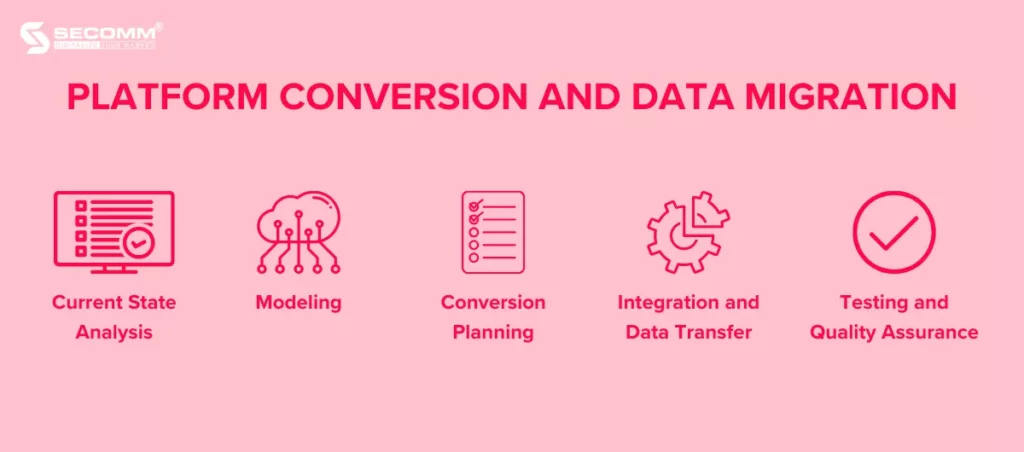
In addition to basic functions, at this stage, businesses should focus on building more sophisticated system functions, including advanced and industry-specific features for the jewelry sector.
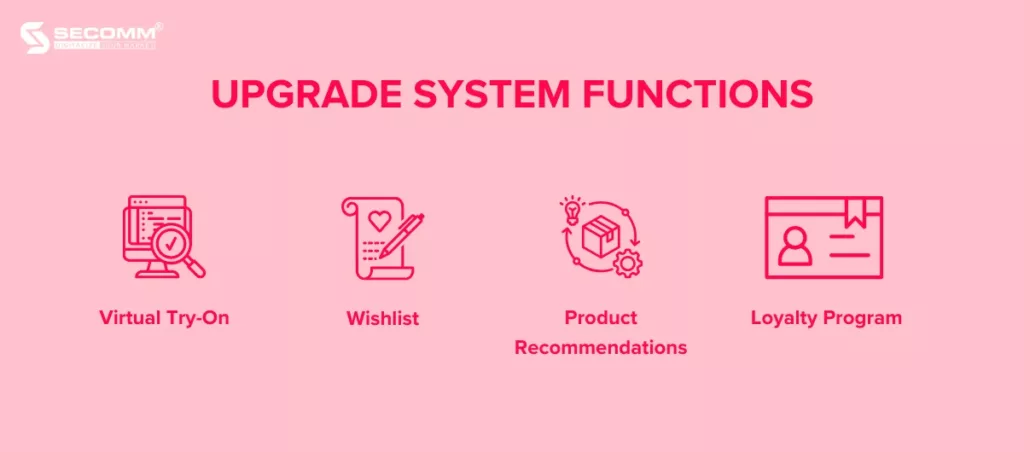
Furthermore, businesses need to continuously innovate and update to develop user-friendly functions and keep up with market trends.
Operating an eCommerce system is an ongoing process that businesses must carry out to ensure the system operates smoothly and efficiently. This process includes the following crucial tasks:
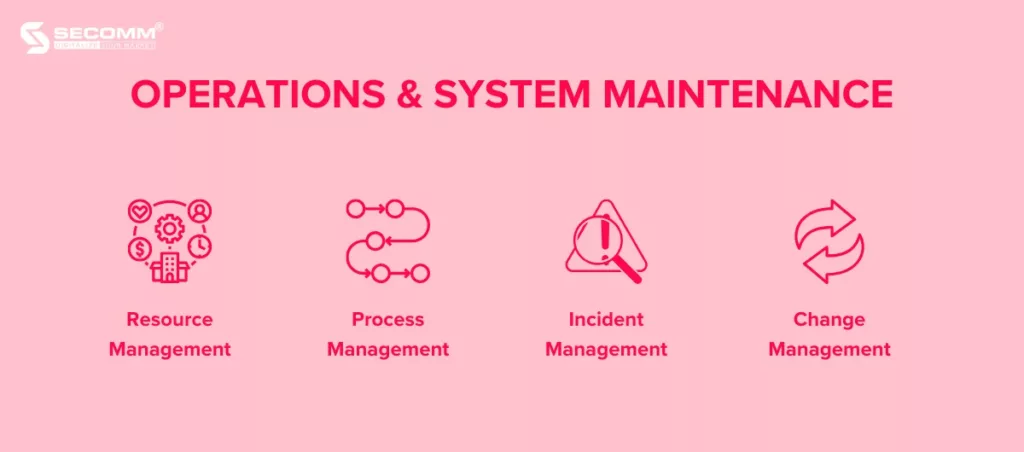
Additionally, continuous care, maintenance, updates, and upgrades of the website system are essential for businesses to sustain sustainable growth and adapt quickly to changes in the eCommerce market, especially in the jewelry and gemstone product sector.
After a period of operation, businesses should shift their focus to eCommerce marketing strategies or omnichannel strategies to boost the sales of jewelry products.
Implementing omnichannel involves setting up a seamless sales, marketing, and management system through various channels such as the website, social media platforms (Facebook, Instagram, Zalo, TikTok Shop), and eCommerce platforms (Shopee, Tiki, Lazada, Sendo) to optimize the customer experience and enhance business efficiency.
Developing a comprehensive marketing strategy and plan based on key eCommerce marketing channels such as Content Marketing, SEO/SEM, Email Marketing, and Affiliate Marketing is essential for rapid business growth.
In conclusion, the journey of building an eCommerce website for the jewelry market in Vietnam is not an easy one. This journey requires businesses to invest a significant amount of time and budget to research the most suitable eCommerce strategy for each stage of their development.
Understanding the difficulties and challenges that businesses face when building an eCommerce jewelry website, SECOMM is ready to provide free consultations and detailed solutions for the development of an eCommerce system tailored to the specific needs of each business.
Contact SECOMM today or call directly at the hotline (028 7108 9908) for a free and detailed consultation.
 2
2
 8,481
8,481
 0
0
 1
1
eCommerce is increasingly thriving and becoming a popular sales channel, especially in the jewelry industry, with global eCommerce jewelry sales reaching $100 billion in 2022 and projected to reach $150 billion in 2025.
To harness the immense potential of this market, choosing the right eCommerce platform is a crucial part of the success of your jewelry business in this billion-dollar market
Read more: What opportunities are open to jewelry eCommerce?
A professional interface is one of the crucial criteria to consider when building an eCommerce website for jewelry. This criterion helps businesses create a positive impression on customers, increase conversion rates, and boost sales.
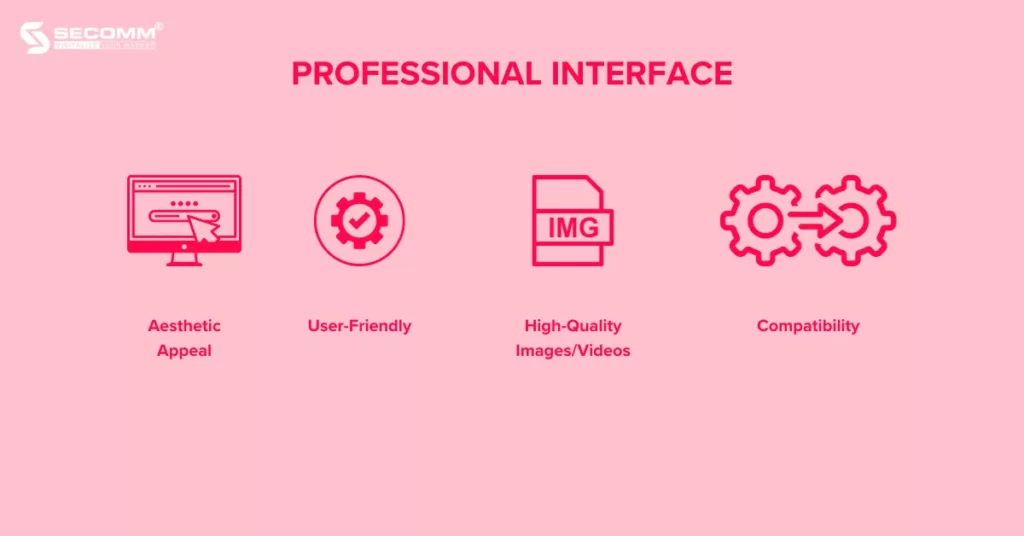
Here are some factors to note when designing the website interface:
When building a jewelry website, in addition to basic eCommerce functions, businesses need to focus on developing advanced features that address industry-specific needs:
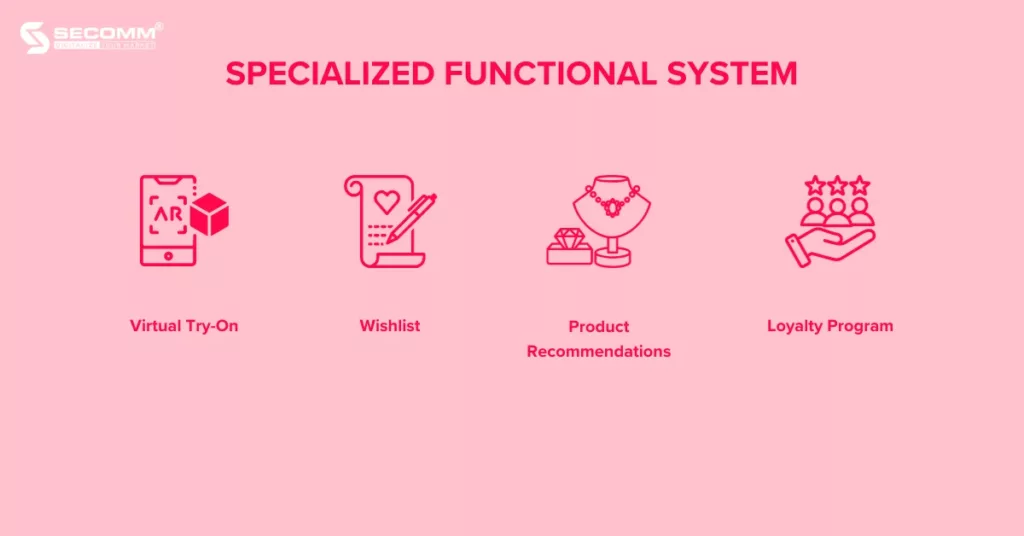
An eCommerce jewelry website needs to have high scalability to meet the evolving needs of the business in the future. Here are some factors to consider when evaluating scalability:
Jewelry is a high-value item, so an eCommerce jewelry website needs to have high security to ensure the safety of customer information and prevent fraudulent activities and theft online.
As eCommerce jewelry websites often require customers to provide personal information such as name, address, phone number, email, credit card details, bank account numbers, etc., for ordering and payment purposes, ensuring the security of this information is crucial. If this information is compromised, customers may fall victim to scams, lose money, or have their privacy violated.
Shopify is a SaaS eCommerce platform founded in 2006. Over the years, Shopify has rapidly become a leading platform in the eCommerce industry, supporting numerous businesses worldwide in establishing and growing their online presence.

The costs associated with using the Shopify platform vary and include:
Read more: Top 5 benefits when applying Headless Commerce in 2023
Evaluating the suitability of Shopify for the jewelry industry:
Several jewelry businesses currently utilizing Shopify for their eCommerce websites include Made by Mary, MISSOMA, Pura Vida Bracelets, and J&CO.
Shopaccino is a SaaS platform established in 2014 in India, specializing in assisting both B2C and B2B businesses in building eCommerce websites across various industries, including the jewelry sector.
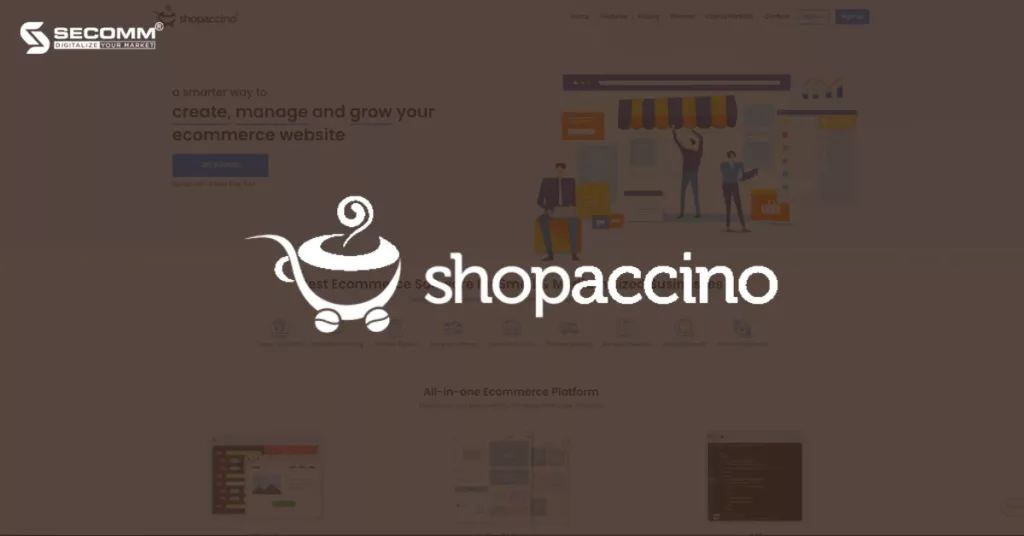
Shopaccino currently offers three main solutions:
Evaluating the suitability of Shopaccino for the jewelry industry:
Some jewelry businesses currently using Shopaccino include Navratan, KOSH, Bibelot Jewels, Greytone, Hiranya Store, Lavie Jewelz, and Euro Gems S.R.L.
Shift4Shop is an eCommerce platform developed by Shift4 Payments, a technology payment company. Shift4Shop provides a comprehensive eCommerce solution for businesses of all sizes and industries, including jewelry businesses.
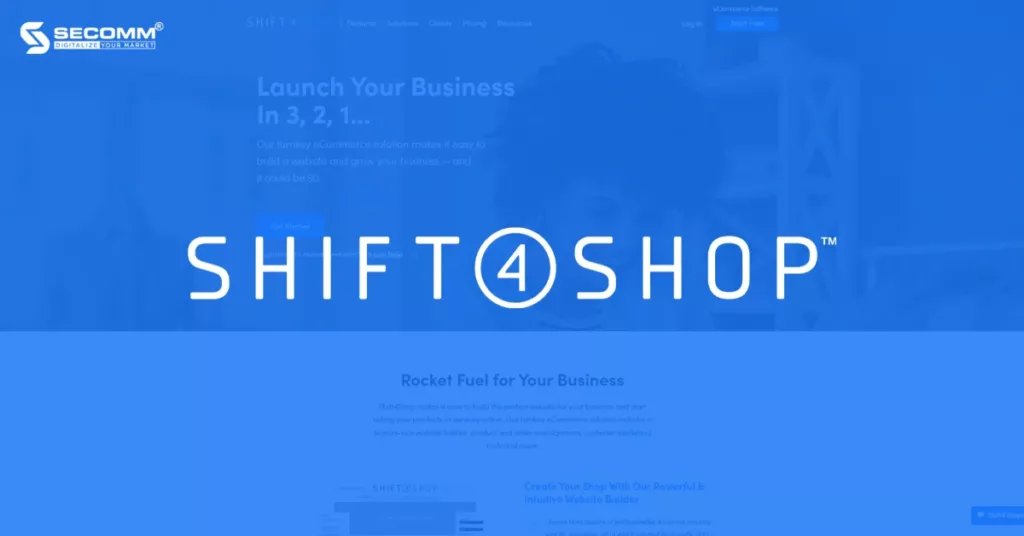
Currently, Shift4Shop only offers services in the U.S. market with four solutions ranging from free to fee-based:
Evaluating the suitability of Shift4Shop for the jewelry industry:
Some brands currently using Shift4Shop include Jewelry Supply, Too Cute Beads, Sasha’s Gemstone Jewelry, Alara Jewelry, Diamond Jewelry NY, and Just Mens Rings.
WooCommerce is an open-source eCommerce plugin developed for the WordPress platform, one of the most popular content management systems (CMS) worldwide. WooCommerce allows businesses to turn their WordPress websites into online stores or integrate eCommerce features into existing websites.3
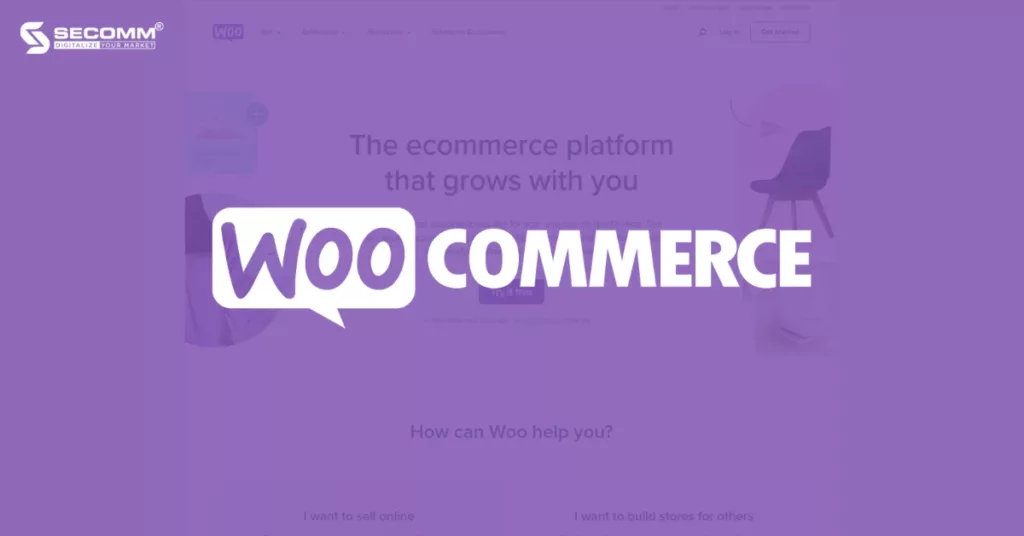
The cost of using WooCommerce depends on the complexity of each project, averaging $1,000 for a basic eCommerce website and $10,000 for a deeply customized eCommerce website.
Evaluating the suitability of WooCommerce for the jewelry industry:
Some businesses using WooCommerce to build jewelry websites include April Soderstrom, NEWTWIST, Waufen, Hyo Silver, Alkemistry, Oxétte, Arden Jewelers, and Binenbaum Antiques & Jewelry.
Adobe Commerce, formerly known as Magento Commerce, is a professional and popular eCommerce system. Adobe Commerce is part of the Adobe Experience Cloud product line and is designed to help businesses build eCommerce websites.
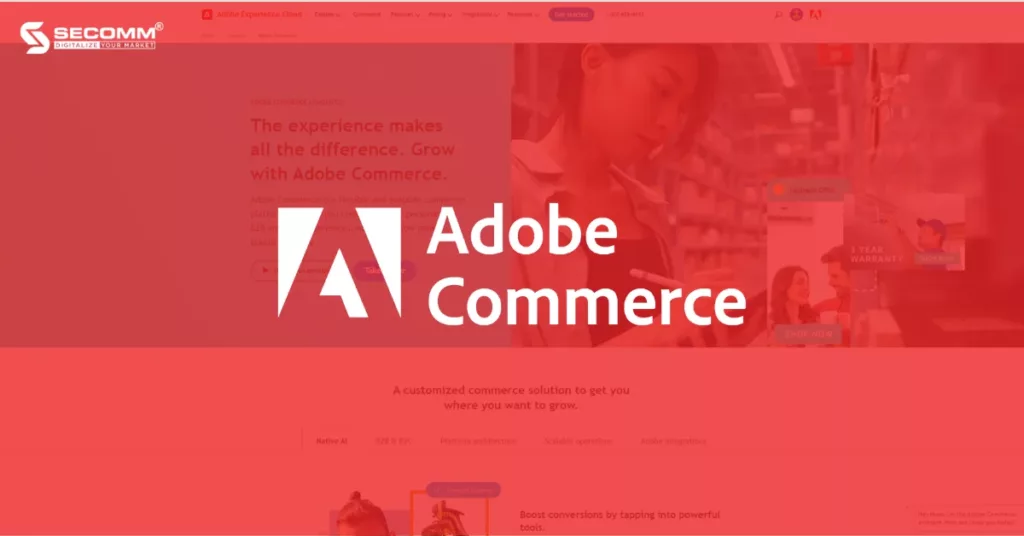
Currently, Adobe Commerce offers two main versions:
Read more: Magento Open Source vs Magento Commerce Real Comparison
Evaluating the suitability of Adobe Commerce for the jewelry industry:
Some businesses using Adobe Commerce to build jewelry websites include True Facet, Hannoush, Judaica, Mikimoto, Charles and Colvard, J.R.DUNN, and EraGem.
Above are some eCommerce platforms suitable for the jewelry eCommerce industry. This list is just a few examples for businesses to consider, as there are many other eCommerce platforms that businesses can explore based on specific needs and available resources.
Understanding the challenges and difficulties that businesses may face when building a jewelry eCommerce website, SECOMM is ready to provide free consultations on detailed eCommerce system development solutions for businesses.
Contact SECOMM today or call directly at the hotline number (028 7108 9908) for free and detailed advice.
 2
2
 9,099
9,099
 0
0
 1
1
The jewelry eCommerce sector is a promising market experiencing swift growth. According to statistics, the global eCommerce jewelry market is currently valued at about 57.4 billion USD and is anticipated to reach approximately 117 billion USD by 2027.
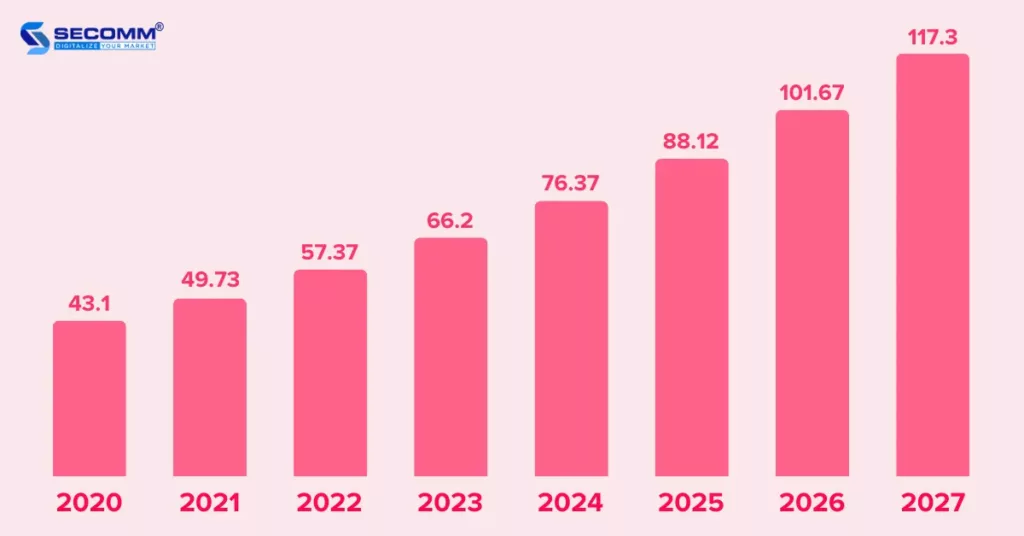
Jewelry eCommerce involves selling various jewelry items, including necklaces, rings, earrings, bracelets, gold, silver, diamonds, pearls, gemstones, and other pieces, conducted through online channels.
This type of eCommerce involves the purchase and sale of jewelry products through websites, applications, or online marketplaces.
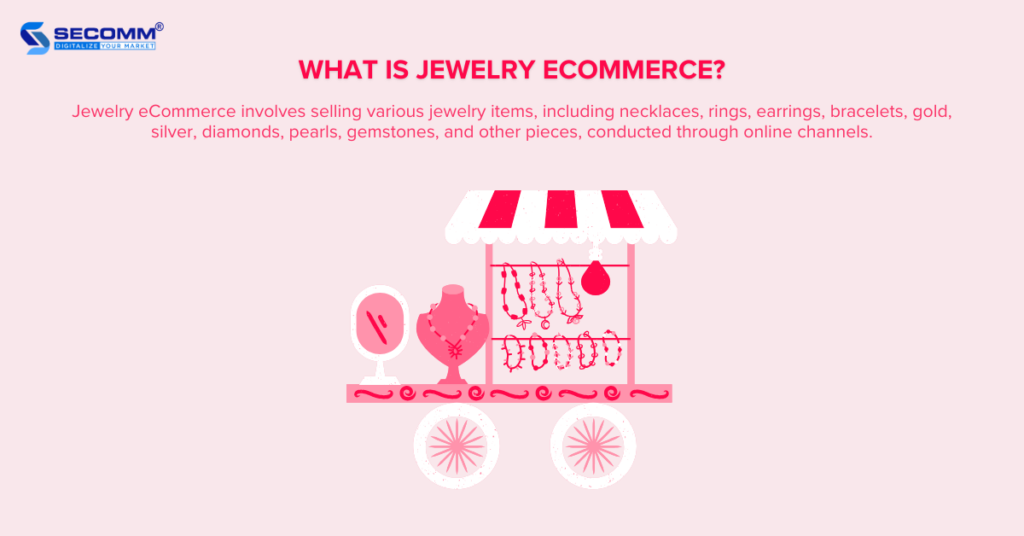
Jewelry eCommerce is increasingly thriving, especially in the context of the COVID-19 pandemic. According to a report from the Vietnam eCommerce Association (VECOM), the Vietnamese jewelry eCommerce market is estimated to reach 10 trillion VND in 2022, showing a growth of 25% compared to 2021.
Several factors are driving the potential of jewelry eCommerce, including:
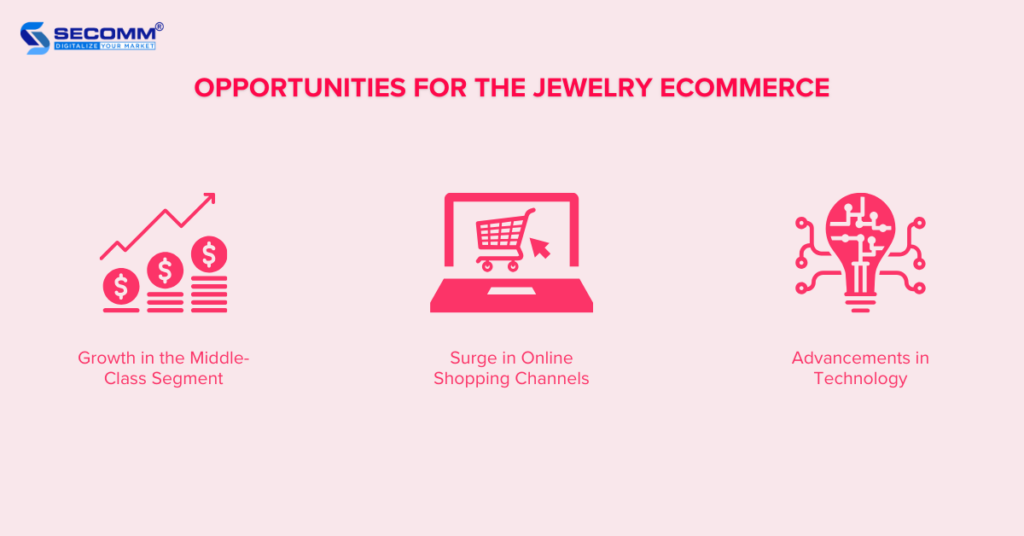
According to the World Bank report, the middle class in Vietnam is steadily increasing, from 13% of the population in 2016 to 26% in 2026. It is expected that the middle class in Vietnam will continue to grow in the coming years.
On a global scale, according to the McKinsey Global Institute report, the global middle class is projected to increase from 1.8 billion people in 2020 to 4.9 billion people in 2030. This growth will generate significant demand for premium products and services, including jewelry and gemstones.
According to Metric report, as of June 2023, Vietnam has over 100,000 eCommerce websites, a 20% increase compared to 2022. The most popular product categories on Vietnam’s online marketplaces include fashion, home appliances, electronics, and jewelry.
On the international market, according to Statista’s report, as of June 2023, there are over 280 million active eCommerce websites worldwide.
The growth of online shopping channels, specifically individual eCommerce websites, has created many opportunities for jewelry eCommerce businesses to reach a larger audience, including customers in distant regions away from the main stores.
The advancement of technology is one of the crucial factors driving the potential of jewelry eCommerce. When integrating innovative technologies like VR/AR, and AI into your jewelry website will enrich the online shopping experience, making it more engaging and appealing to customers.
Alongside the opportunities, jewelry brands still have to confront the challenges of the market
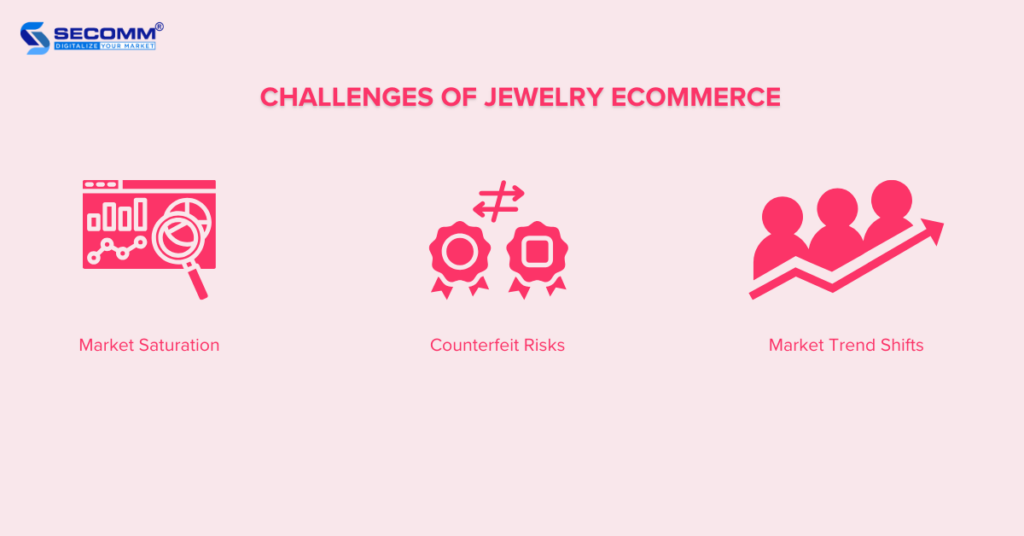
The jewelry industry faces intense competition, with numerous businesses, both large and small, vying for market share. This requires jewelry brands to exert efforts to compete in terms of pricing, product quality, and the services they provide on their eCommerce website.
Counterfeit goods are often made from low-quality materials and are significantly cheaper than genuine products. This poses a significant challenge for the online jewelry market, as consumers struggle to differentiate between authentic and fake items, leading to adverse effects on jewelry brands.
Market trends are always changing, particularly in the jewelry eCommerce industry. It requires you to stay constantly updated to cater to evolving customer demands.
When purchasing jewelry products, customers desire an online shopping experience similar to in-store shopping. Because they want to view products directly, read reviews from other customers, and receive guidance from sales staff.
Tiffany & Co. is a premium jewelry brand headquartered in New York, USA, established in 1837 by master jeweler Charles Lewis Tiffany. The company embraced eCommerce early on and has become one of the largest online jewelry retailers globally.

Tiffany & Co.’s eCommerce website is built on the Adobe Enterprise Cloud platform, enabling the business to provide flexibility and scalability to meet customization needs and long-term development goals.
Leveraging resources from the leading Adobe Commerce eCommerce platform, the business has utilized Adobe Experience Platform Launch, Adobe Target, Adobe Experience Platform Identity Service, and more to deliver customized and personalized services for its customers.
Pandora is a retail jewelry brand established in 1982 by Per Enevoldsen in Copenhagen, Denmark. The brand is known for customizable bracelets and other specially designed jewelry lines.

Pandora’s eCommerce website for the US and UK markets is built on the Salesforce Commerce Cloud platform, while the Vietnamese market utilizes Haravan. Therefore, the US and UK versions will have more specialized features such as wishlists, quick view, product comparison, loyalty programs, etc.
PNJ, or Phu Nhuan Jewelry, is a reputable jewelry brand with a long history and a widespread network of stores across Vietnam. Founded in 1988 in Phu Nhuan District, Ho Chi Minh City, Vietnam.

Initially, PNJ’s eCommerce website was built on the CS-Cart platform. As it grew, PNJ re-platform to WooCommerce to design its eCommerce website. This move benefits the PNJ website with many amazing features, including diverse payment method integration, product size customization, store location search based on province/city and district, and the flexibility of choosing between home delivery and in-store pickup.
The Bottom Line
In general, jewelry brands face numerous challenges and opportunities to make strides in the eCommerce landscape. Achieving success in this industry requires innovation, responsiveness to customer demands, and staying abreast of the latest technological trends.
Learn more: 10 Jewelry eCommerce Websites in Vietnam & Worldwide
Understanding both the opportunities and challenges when deploying jewelry eCommerce websites, SECOMM has a team of experts and a wide range of solutions to help you make it a reality.
Contact us or call the hotline at 028 7108 9908 to get started!
 2
2
 9,952
9,952
 0
0
 2
2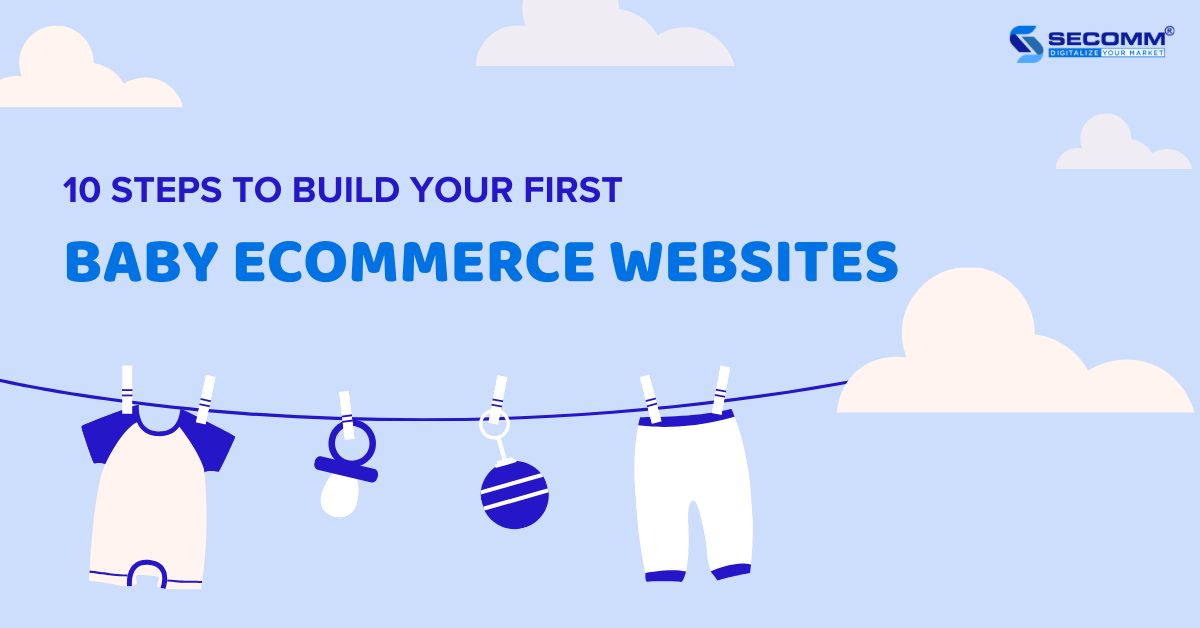
Baby eCommerce is a promising market experiencing a steady annual growth rate (CAGR 2023-2027) of 9.86%, projected to reach a market value of approximately USD 129.40 billion by 2027.
To tap into this market, you’ll need to develop a professional and efficient eCommerce website. Here are 10 steps to create an eCommerce website tailored for maternity and baby products.
The first step is to identify your business goals and prioritize them, forming a plan tailored to develop an effective Baby eCommerce website.
Concerning long-term goals, you may focus on objectives like establishing a strong brand presence, reaching potential customers, and enhancing the efficiency of both online and offline operations.
For short-term goals, businesses can give priority to activities like monitoring, analyzing customer behavior, assessing the effectiveness of marketing campaigns, and boosting revenue.
When it comes to timeline, you can decide to deploy quickly to enter the market or proceed gradually to test and adapt to this eCommerce world.
As for the budget, it depends on your business strategy and financial capacity for this Baby eCommerce development project.
Currently, there are two types of eCommerce platforms to help you build your first Baby website: SaaS (Software as a Service) and Open-Source platform.
Some popular SaaS eCommerce platforms include Shopify, BigCommerce, Squarespace, and Wix.
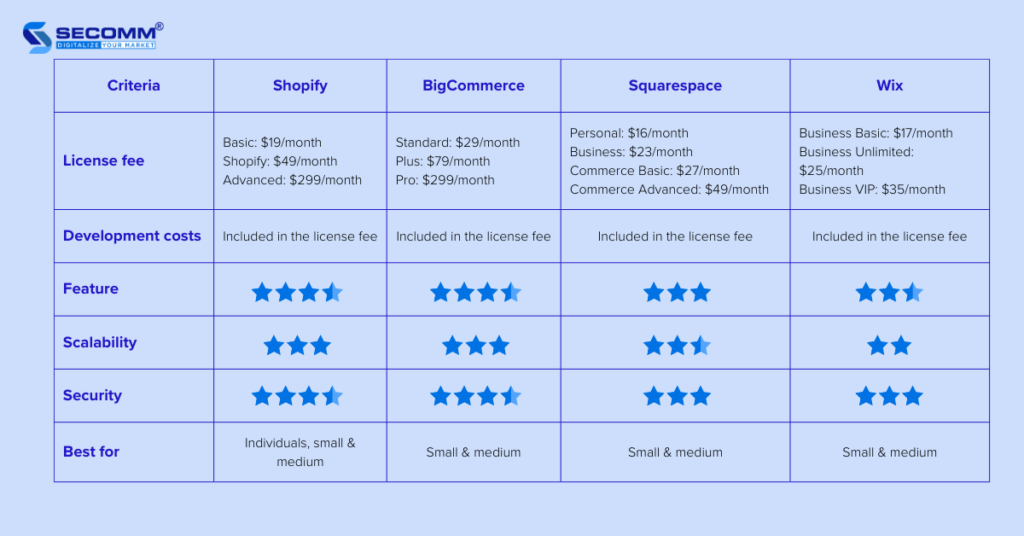
In addition, there are premium versions of these SaaS platforms such as Shopify Plus, BigCommerce Enterprise, and Goflow.

Some open-source platforms are widely used: Adobe Commerce (Magento), WooCommerce, OpenCart, and PrestaShop.
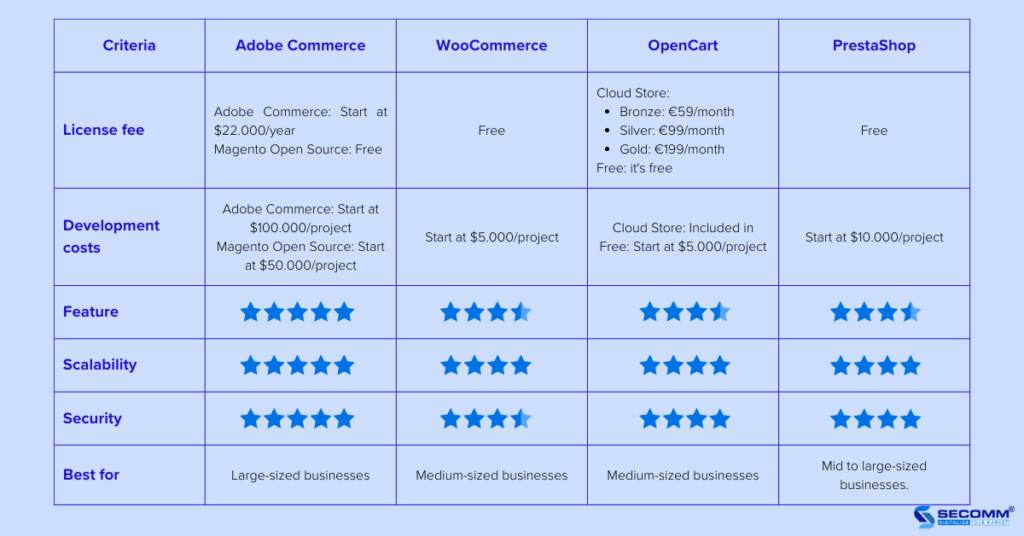
Typically, some new businesses choose basic SaaS platforms to save time and budget in the initial phase of the Baby eCommerce website development. After a while, they may switch to a premium SaaS or an open-source platform to develop their baby websites more advanced.
In another case, some businesses opt for open-source platforms to build a basic eCommerce website and then gradually upgrade the system over time to minimize the need for platform switching in later phases.
Typically, most eCommerce businesses decide to initially partner with a professional development agency and gradually build their in-house team.
For establishing an in-house team, you’ll need to recruit and train IT and eCommerce professionals for expertise on the chosen platform. It’ll take you significant time and budget but allow you to have full control over your resources. You can develop and adjust your Baby eCommerce website according to your needs and wants.
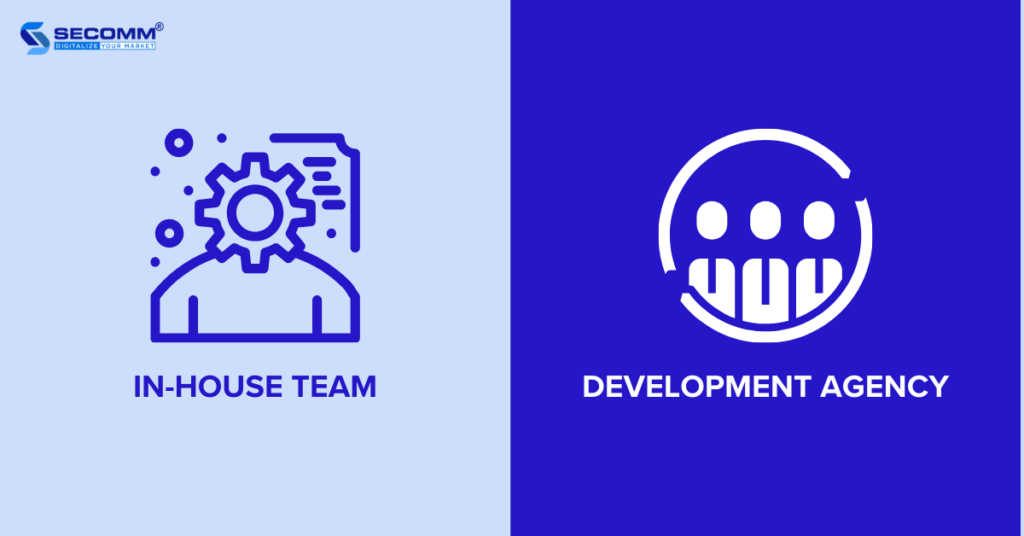
When it comes to partnering with an agency, here are some criteria you need to evaluate:
Partnering with a professional development agency gains you specialized eCommerce knowledge, enhances your technical skills, and above all, you’ll facilitate the eCommerce website exactly what you need, tailoring it to the unique features of the maternity and baby industry.
When it comes to UI/UX design, it’s important to showcase the brand image, products, user guide, etc. There are three popular ways to make your design:
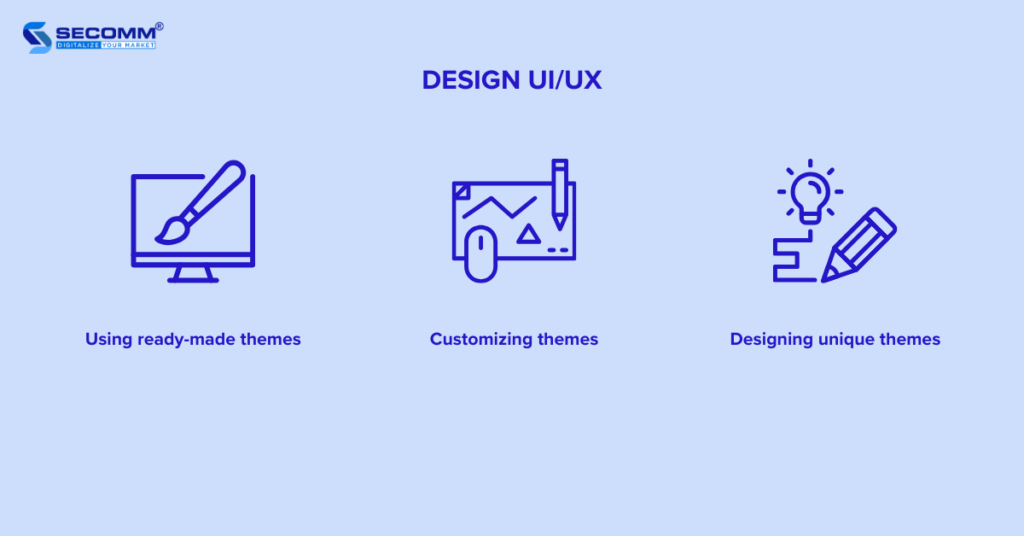
Some essential features that a Baby eCommerce website should have include
Some advanced features for the baby eCommerce industry:
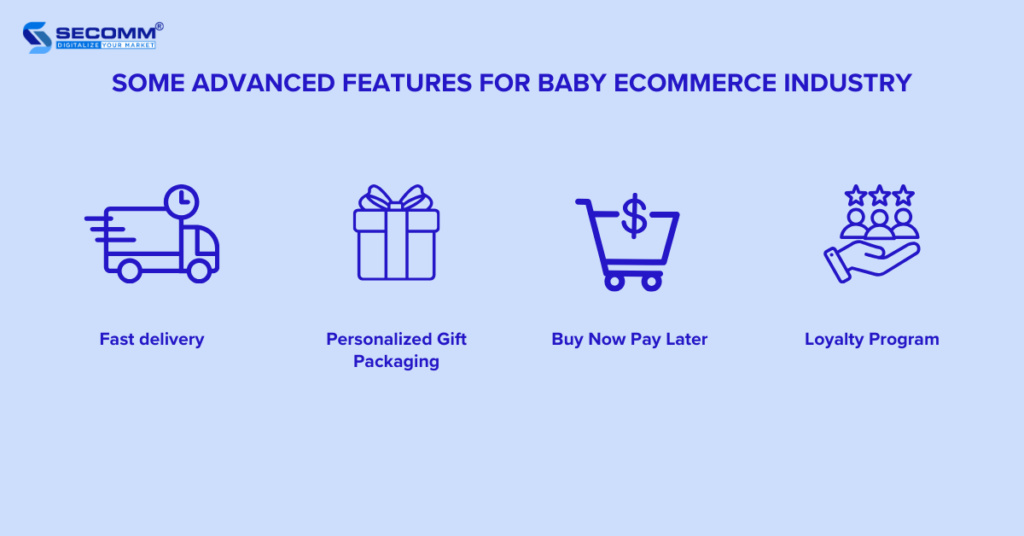
After developing features and ensuring a successful testing and website launch, you’ll need to complete the legal procedures associated with eCommerce operations.
According to Decree 52/2013/ND-CP by the Government of Vietnam, any individual or organization owning an eCommerce website for sales is required to notify or register with the Ministry of Industry and Trade through the online public service portal of the Ministry of Industry and Trade.
Note: Websites that operate beyond the specified period or fail to register/notify the authorized management agency within the designated timeframe may be subject to administrative penalties as per regulations.
When QC/testing your eCommerce website, you can leverage either the Waterfall or Agile model to test the entire system.
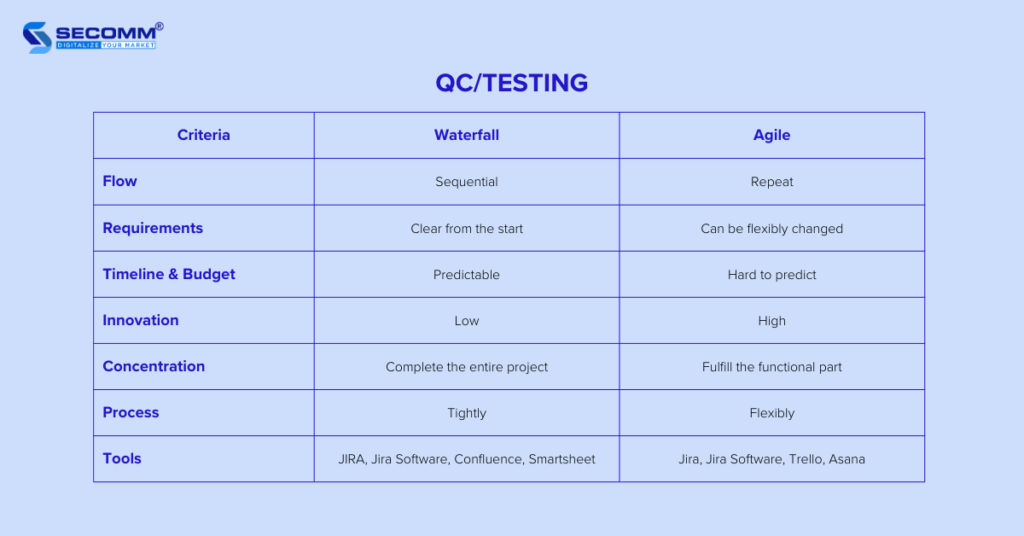
Using these models helps you review and test your entire eCommerce system, functions, and features within a specified timeframe, ensuring optimal order processing speed and overall website stability. In case of any issues, your in-house team or development partner will help you to address them before officially going live.
When the QC/testing process is done, your baby eCommerce website is ready to launch. To ensure a smooth go-live process, here are three steps you should prepare:
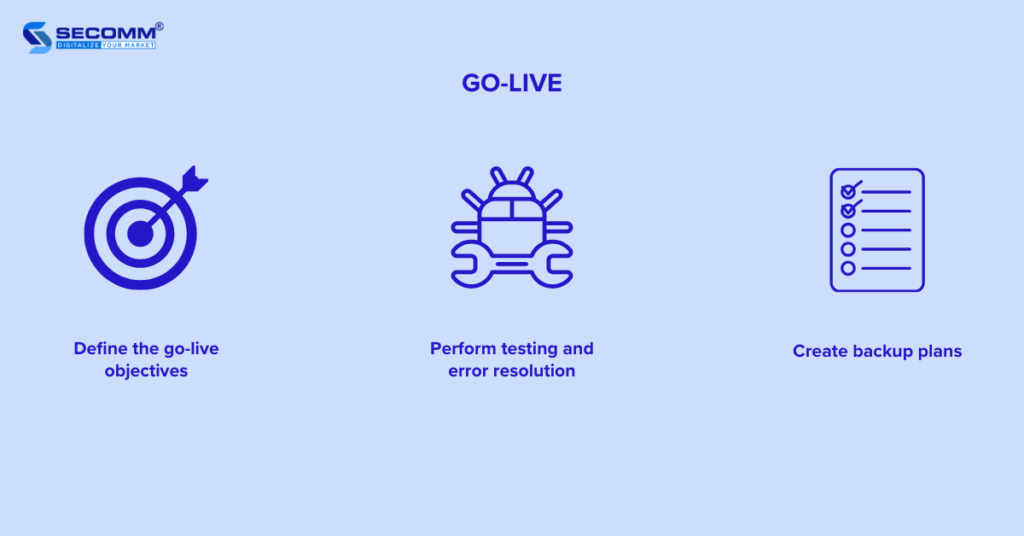
Running a baby website is an ongoing effort aimed at ensuring the steady and effective functioning of the system. This involves various activities, including:
Furthermore, you should regularly maintain, update, and upgrade the website system to achieve sustainable growth, adapting quickly to shifts in the eCommerce world or the maternity and baby products market.
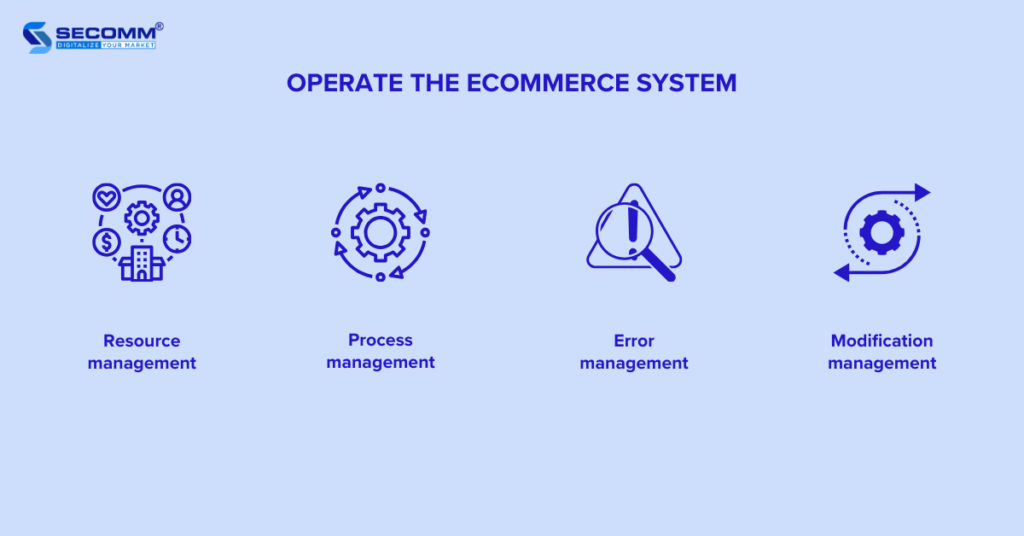
After a period of operation, you should shift your focus toward eCommerce marketing strategies or Omnichannel to expand your online presence in the market of maternity and baby products
businesses should redirect their focus toward implementing eCommerce marketing strategies or embracing Omnichannel approaches to expand their online presence in the market of mother and baby products.
Implementing Omnichannel involves setting up a seamless sales, marketing, and management system across channels such as the website, social media platforms (Facebook, Instagram, Zalo, TikTok Shop), and online marketplaces (Shopee, Tiki, Lazada, Sendo) to optimize the customer experience and boost business efficiency.
Developing a comprehensive marketing strategy, centered around key eCommerce marketing channels like Content Marketing, SEO/SEM, Email Marketing, and Affiliate Marketing, becomes crucial for achieving rapid sales growth.
The Bottom Line
In general, the journey of building a baby eCommerce website for the Vietnamese market isn’t an easy task. It requires you to invest a significant amount of time and budget in researching the most fitting strategies tailored to each phase of your eCommerce development.
Understanding the difficulties and challenges that businesses may encounter when building a baby eCommerce website, SECOMM is ready to provide free consultation on detailed eCommerce solutions.
Reach out or call the SECOMM hotline at 028 7108 9908 to get started!
 2
2
 5,891
5,891
 0
0
 1
1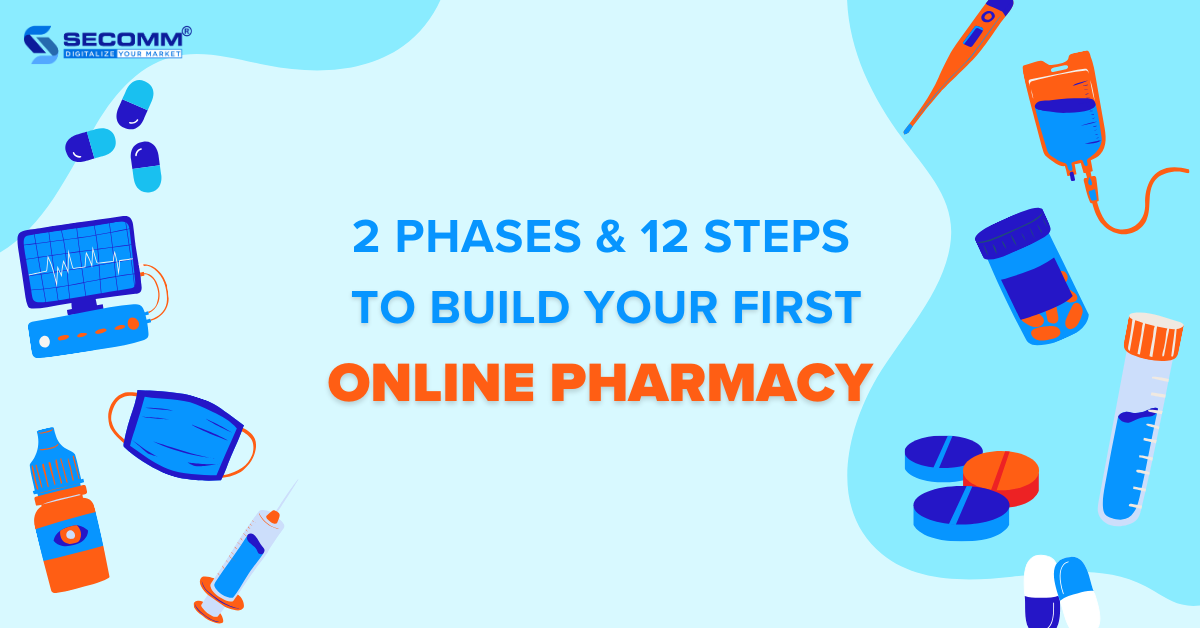
Since the advent of the COVID-19 pandemic, the pharmaceutical industry has proven the potential of transitioning from offline to online pharmacy. In the United States, the number of remote health consultations surged by 2,600% in March 2020 (during the peak of COVID-19 in the U.S.) compared to the same month in 2019. According to Statista, the global pharmaceutical eCommerce sector is projected to reach 32 billion USD by the end of 2023.
Several brands have successfully embraced eCommerce early on, achieving unexpected successes. Examples include Apollo Pharmacy (India), FPT Long Châu (Vietnam), CVS Health (USA), and Droga Raia (Brazil). The common thread among these brands lies in their comprehensive eCommerce platforms, catering to the shopping needs of customers for healthcare, pharmaceutical, and medical products.
With nearly 10 years of experience in the eCommerce sector, SECOMM has outlined the journey of building pharmaceutical eCommerce websites for the Vietnamese market.
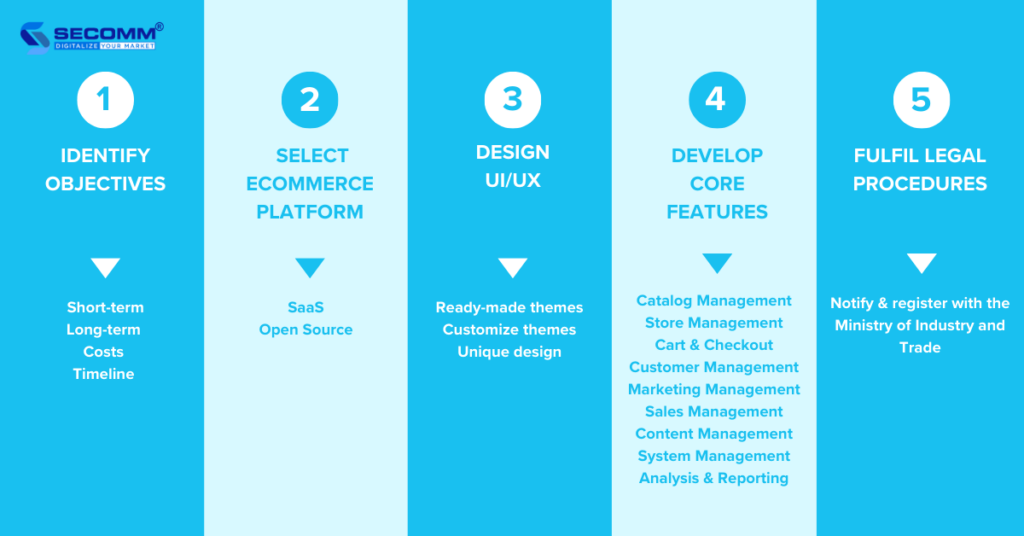
The first thing to do is identify and prioritize goals to plan the pharmacy eCommerce website development for each phase.
In the long run, businesses can consider goals like branding, generating potential customers, and optimizing online and offline operations.
For short-term goals, businesses should prioritize objectives like monitoring and analyzing customer behavior, evaluating marketing campaigns, and revenue growth.
In the first phase, businesses can decide to deploy quickly to enter the market or proceed gradually to test and adapt to this eCommerce world.
There are two types of platforms to help businesses facilitate pharmacy eCommerce websites: SaaS (Software as a Service) and open source.
Some popular SaaS eCommerce platforms include
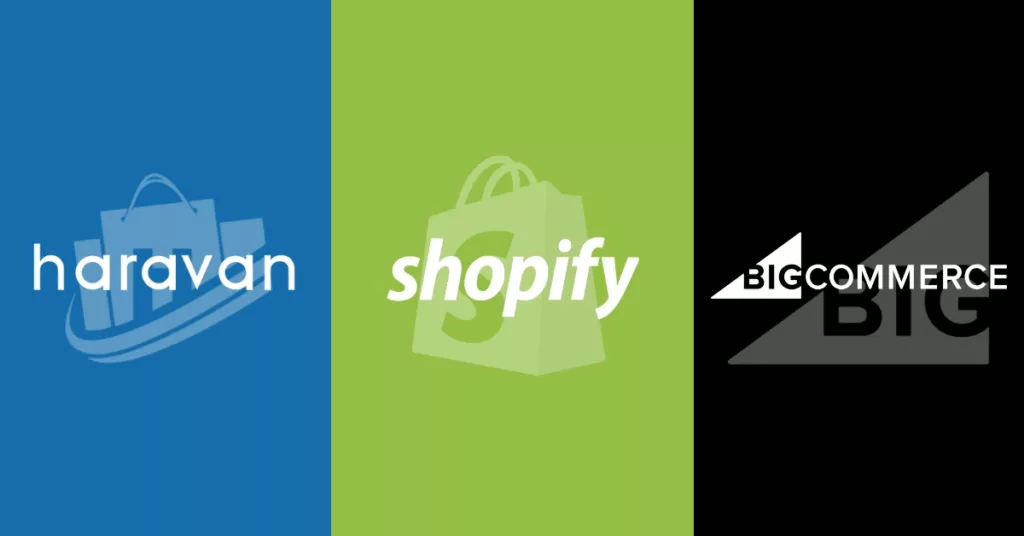
Some outstanding open-source eCommerce platforms include
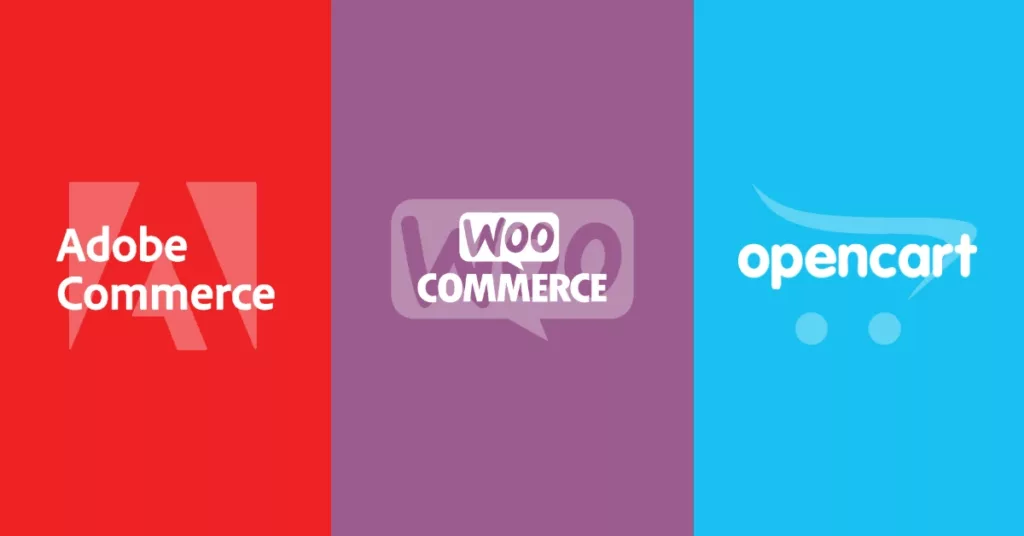
Typically, new eCommerce businesses will choose SaaS platforms to save time and budget in the initial phase of building a basic eCommerce website or an online pharmacy. Then, businesses will re-platform to an open-source platform to develop more advanced eCommerce systems.
However, some businesses decide to build their eCommerce websites in the basic phase on an open-source platform and then upgrade the system over time to remove the re-platforming step in the later phase.
When designing the interface, businesses need to meet basic criteria such as UI/UX standards, showcasing the brand’s characteristics, maintaining consistent product presentation, providing sufficient user guidance, etc.
When it comes to UI/UX design, it’s important to showcase the brand image, products, user guide, etc.
There are three ways to design UI/UX:
In this phase, businesses often choose ready-made themes to minimize costs, but some financially robust businesses may opt for the other two methods to better position their brand.
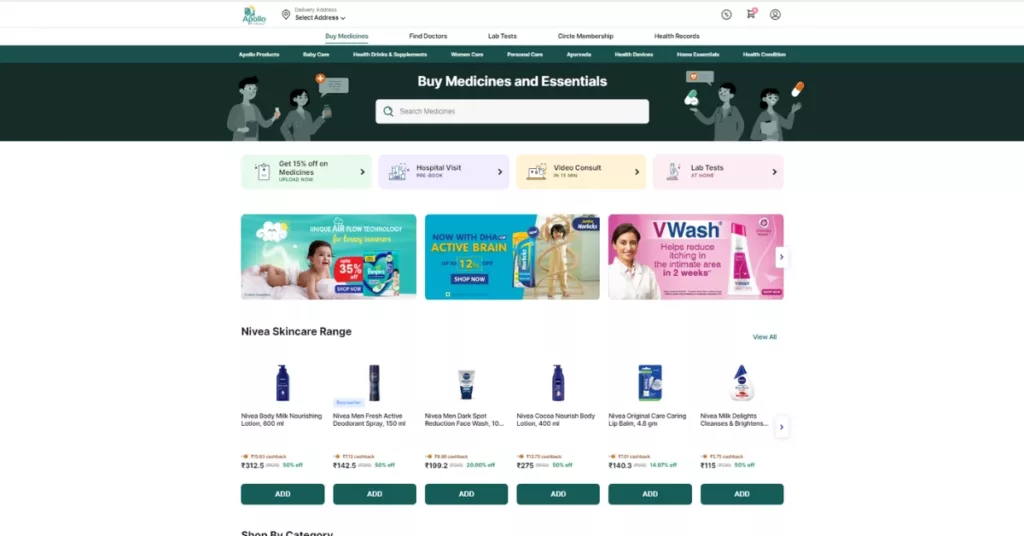
In the basic development phase, businesses should prioritize developing core features for an online pharmacy.
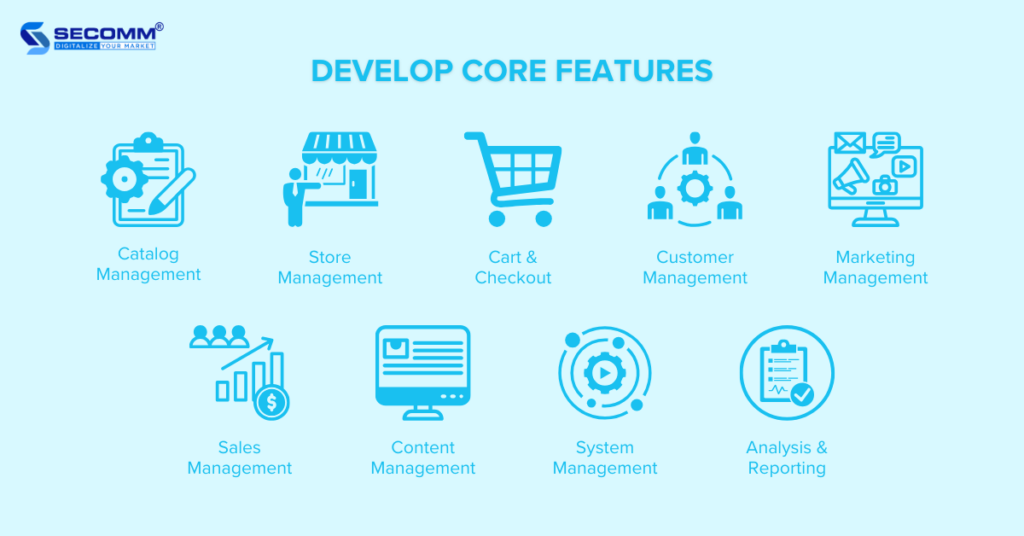
Some essential features that a pharmacy eCommerce website should have include
After developing features and ensuring a successful testing and website launch, businesses are obligated to complete the legal procedures associated with eCommerce operations.
According to Decree 52/2013/ND-CP by the Government of Vietnam, any individual or organization owning an e-commerce website for sales is required to notify or register with the Ministry of Industry and Trade through the online public service portal of the Ministry of Industry and Trade.
Note: Websites that operate beyond the specified period or fail to register/notify the authorized management agency within the designated timeframe may be subject to administrative penalties as per regulations.
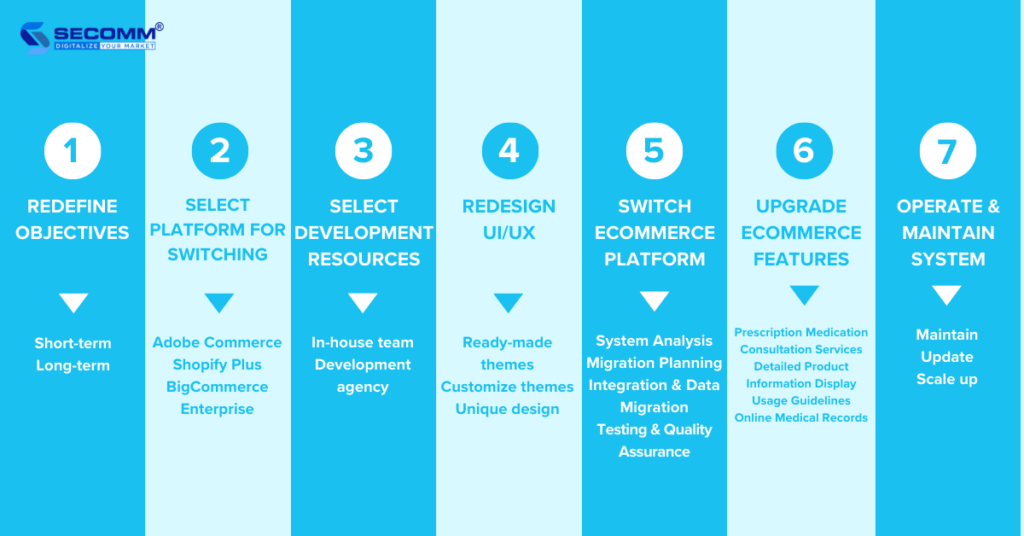
In the process of business development and amidst significant market changes, it’s important to realign goals to suit the evolving landscape. This time for business leaders to redefine objectives regarding the overall strategy, timeline, and budget for investing in the pharmacy eCommerce website.
During this phase, businesses often focus on short-term and long-term goals related to expanding the online pharmacy
For long-term goals, businesses may consider goals such as expanding market segments, establishing a loyalty program, and cultivating shopping habits for healthcare products, pharmaceuticals, and medical equipment.
For long-term goals, businesses may prioritize goals related to tapping into new potential customers, revenue growth, and supporting eCommerce marketing strategies such as livestreaming, gamification, affiliate marketing, and influencer marketing.
When SaaS platforms can’t support businesses to expand the system anymore, re-platforming to another robust platform is a top choice. Platforms like Adobe Commerce, Shopify Plus, and BigCommerce Enterprise can help businesses facilitate a deeply custom pharmacy eCommerce website.

When re-platforming, businesses have challenges such as switching costs, time to train personnel, and data loss throughout the platform migration process.
To build a high-complexity online pharmacy on a professional platform, businesses need resources to facilitate it effectively.
Businesses can decide to build an in-house team or seek a development agency. Regardless of the choice, it requires businesses to have practical experience on the selected platform.
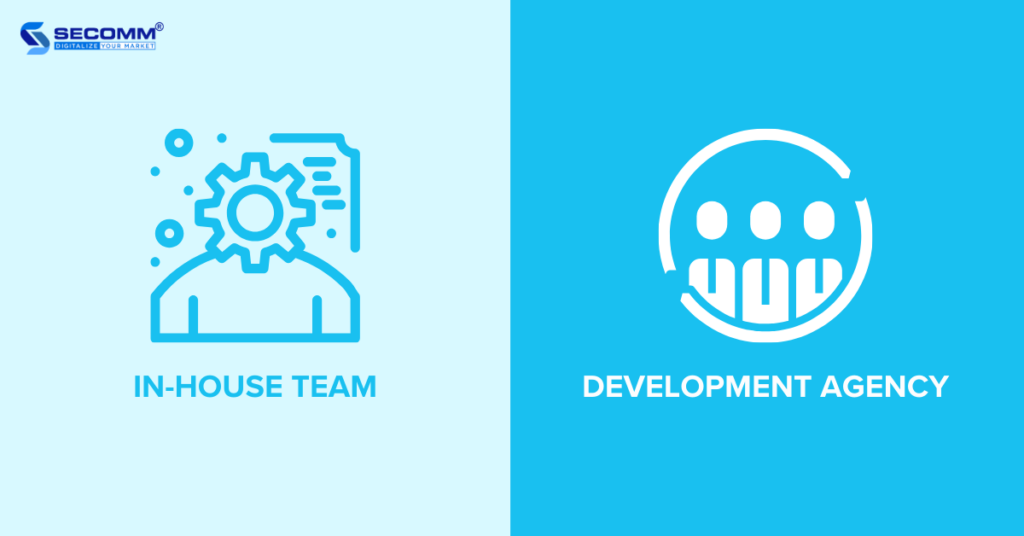
For building an in-house team, businesses need to recruit and train IT and eCommerce personnel to develop on the selected platform. This option may take time and budget to establish a high-performing team but it allows the business to have better control over resources and actively adjust or develop the website system.
In case businesses hire a development agency, here are some criteria to consider:
Partnering with a professional development agency will help businesses gain specialized knowledge, enhance experience, and create an online pharmacy tailored to the specific needs of the industry.
During the platform migration process, businesses can keep the current website design without making any changes. However, some businesses tend to redesign their websites to align with new strategies and the new platform.
Similar to the previous phase, businesses have three options to design their pharmacy eCommerce websites: using ready-made themes, customizing themes, or designing a unique interface.
However, in phase 2, businesses often decide to customize themes or design a unique interface to express the brand image and the pharmaceutical eCommerce industry.
After the right eCommerce platform for migrating, businesses should carry out the process to minimize the risk of data loss or errors. Typically, the migration process is automated as much as possible to avoid potential issues.
The migration process includes the following steps:
After re-platforming, the business needs to perform thorough checks to ensure that the data has been migrated completely and accurately according to the plan.
Beyond core features, businesses should focus on building a system with more complex features, including advanced and industry-specific functionalities for pharmaceutical eCommerce.
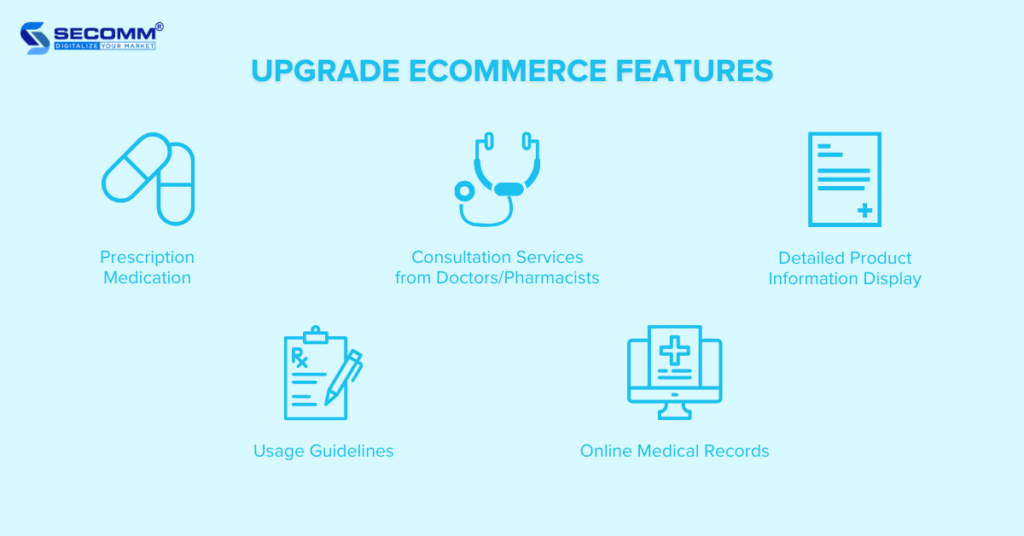
In addition, businesses need to consistently update and enhance these features to meet user needs and keep pace with market trends.
When testing the eCommerce system, businesses need to thoroughly check the entire website and its features over a specific period to ensure order processing speed and website stability. If any issues arise, businesses should immediately contact the in-house team or development partner to adjust and improve the website accordingly before officially going live.
Once the pharmacy eCommerce website system is stable, businesses should focus on eCommerce marketing strategies or Omnichannel approaches to enhance their online pharmacy.
Additionally, regular maintenance, updates, and continuous system upgrades are essential to sustain growth and quickly adapt to changes in the eCommerce market in general and the healthcare market in particular.
The Bottom Line
In general, the journey of building a pharmacy eCommerce website in Vietnam is not an easy task. This work demands substantial investments of time and budget from businesses to research the most suitable eCommerce strategy for each stage of their development.
Understanding the challenges that businesses may encounter when building an online pharmacy, SECOMM is ready to provide custom solutions for developing an eCommerce system.
Contact SECOMM or call the hotline at 028 7108 9908 for a free consultation.
 2
2
 6,469
6,469
 0
0
 1
1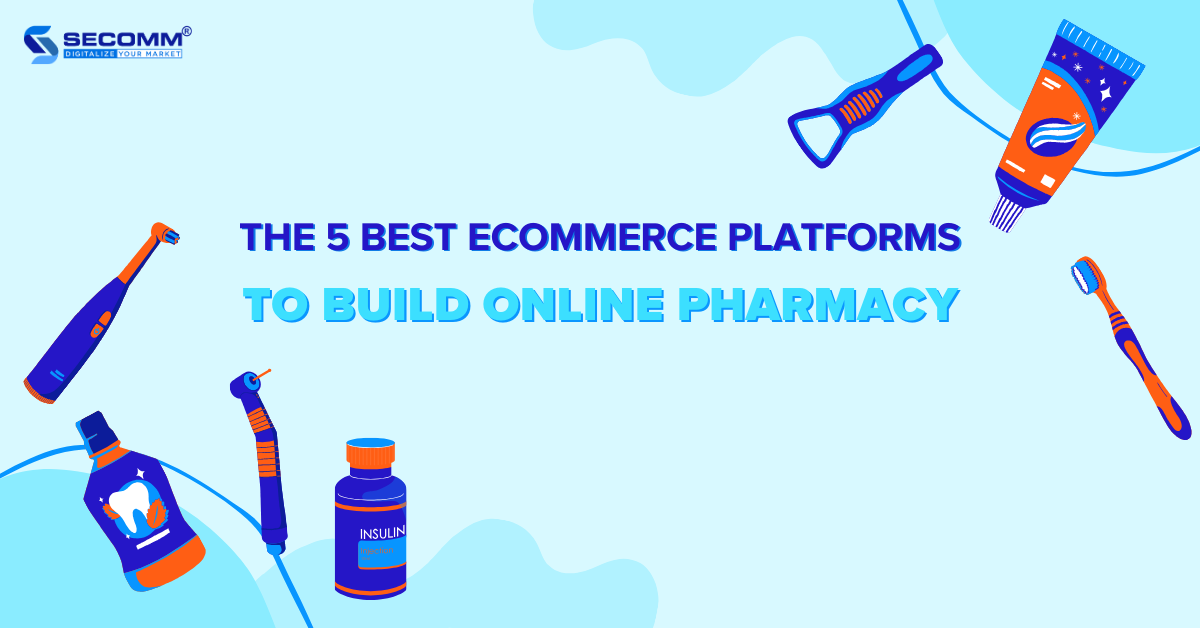
According to The Business Research Company, the global pharmaceutical eCommerce market is projected to reach $732.3 billion by 2027. This represents a significant opportunity for pharmacies, healthcare service providers, or hospitals/clinics to implement eCommerce and reach a broader range of potential customers. To achieve this, building an online pharmacy on a professional platform is a great idea to address industry-specific challenges.
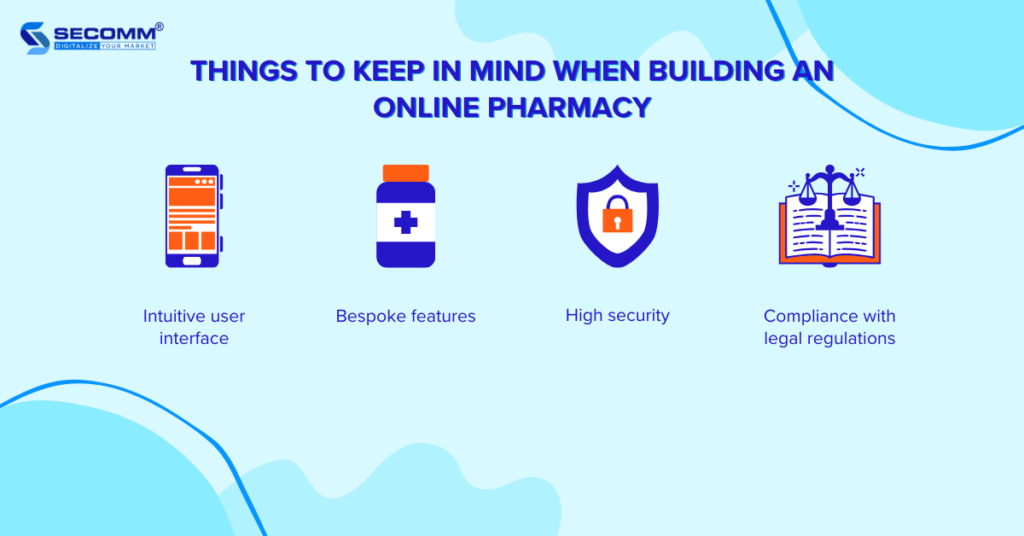
When building a pharmacy eCommerce website, businesses must meet numerous criteria to ensure professionalism, safety, and legal compliance within this industry.
The typical customer profile in the pharmaceutical eCommerce sector consists of individuals seeking to purchase medications, medical equipment, and other healthcare products for themselves, family, or friends.
Thus, the website interface needs to be visually appealing, and user-friendly, and prioritize colors such as blue or white to create a sense of safety and cleanliness.
Other factors, such as layout, font choice, and imagery, should be carefully selected and coordinated to deliver the most professional user experience.
When building an online pharmacy, beyond default eCommerce features, businesses should focus on developing the following features to address industry-specific needs:
An online pharmacy is a system that contains various crucial information including personal details, payment information, and the health status of customers. Therefore, the security system of the website needs to be built and deployed carefully to ensure the safety of customer data.
Pharmaceutical eCommerce is a specialized business area subject to the regulations of the healthcare/pharmaceutical industry. eCommerce pharmaceutical businesses need to comply with these regulations to ensure that their operations are legal and safe for customers.
Below are some key legal regulations that e-commerce pharmaceutical businesses need to adhere to in Vietnam:
In addition, pharmaceutical eCommerce businesses also need to comply with other legal regulations, such as Cybersecurity Law, Consumer Protection Law, and eCommerce Law.
Although this industry has many challenges to deploy, businesses always have eCommerce platforms to create their online pharmacies. Here are the 5 leading platforms for building online pharmacy that businesses may consider.
BigCommerce is a cloud-based eCommerce platform operating on the Software as a Service (SaaS) model, enabling businesses to create and manage online stores.
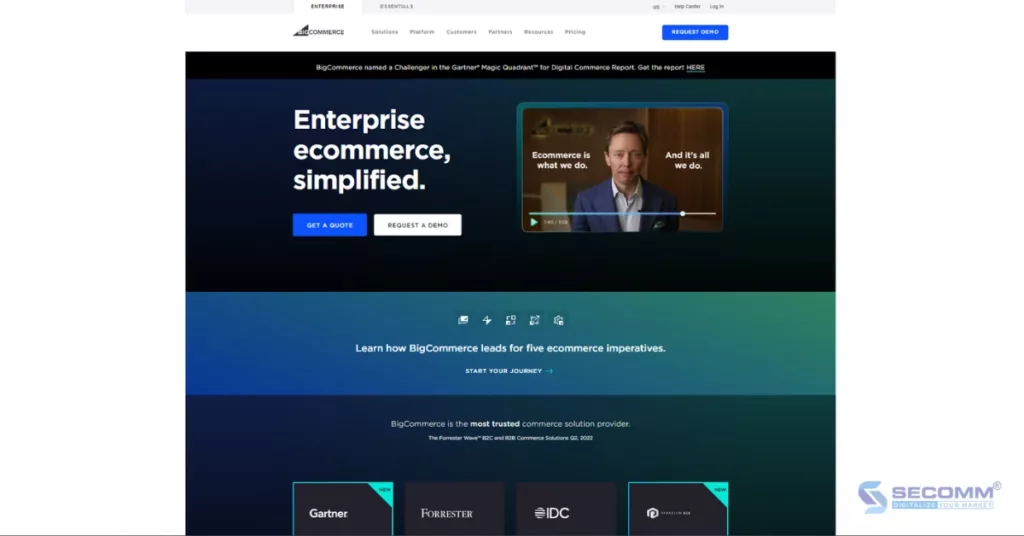
Currently, BigCommerce offers four main solutions, including
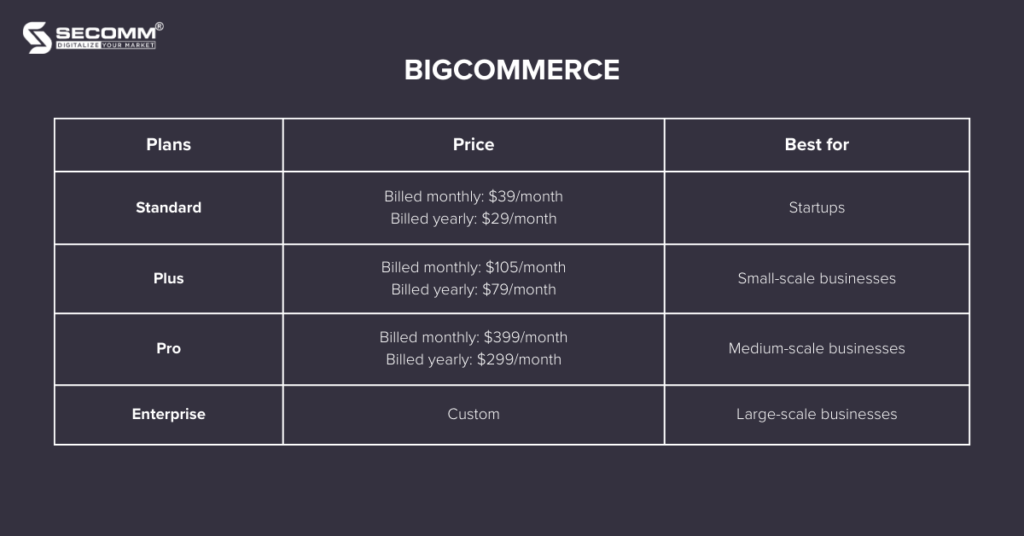
Pros:
Cons:
Some famous pharmaceutical eCommerce businesses currently utilizing BigCommerce include Victoria Health, Molton Brown, LARQ, and Zyppah.
Shopify is a SaaS eCommerce platform established in 2006. To date, Shopify has rapidly become one of the leading platforms in the eCommerce industry, supporting thousands of businesses worldwide to initiate and grow their online ventures.

The cost to use the Shopify platform is quite diverse, including these three solutions:
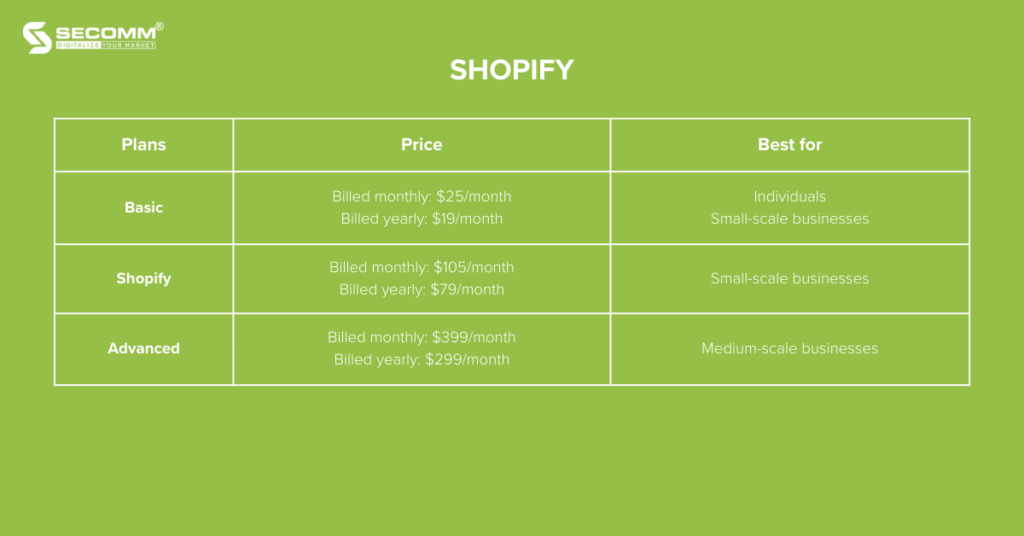
In addition, Shopify provides eCommerce solutions tailored to businesses with different needs and wants, such as:
Learn more: Top 5 benefits of Headless Commerce
Pros:
Cons:
Healthcare, pharmaceutical, and medical businesses using Shopify include Dr.Axe, 310 Nutrition, Hiya, and BUBS Naturals.
StoreHippo is a SaaS eCommerce platform established in 2014 in India. Over the years, this platform has consistently updated its technologies to meet the website-building needs of businesses, particularly those in the pharmaceutical eCommerce sector.
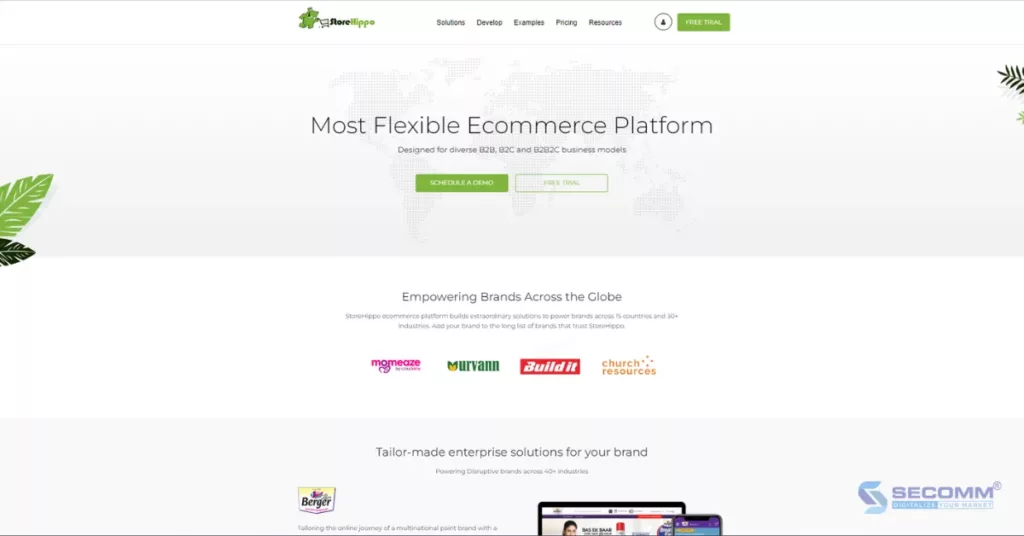
Similar to other SaaS platforms, StoreHippo offers a variety of solutions to choose from:
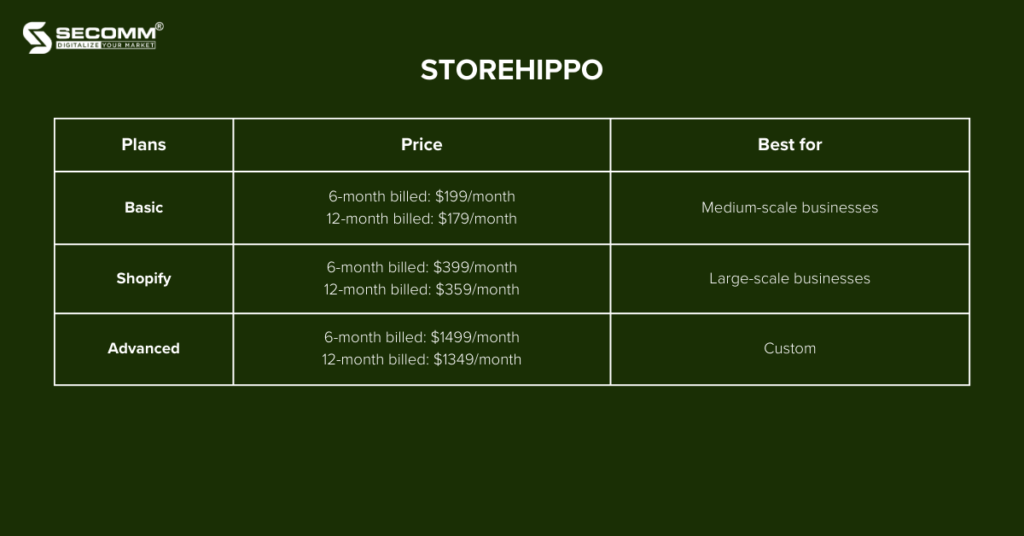
Pros:
Cons:
Some brands that built their online pharmacy with StoreHippo include WoundProfessional, Kunooz, and On A Healthy Note.
WooCommerce is an open-source eCommerce plugin developed for the WordPress platform, one of the most popular content management systems (CMS) globally. WooCommerce enables businesses to turn their WordPress websites into online stores or integrate eCommerce features into existing websites.
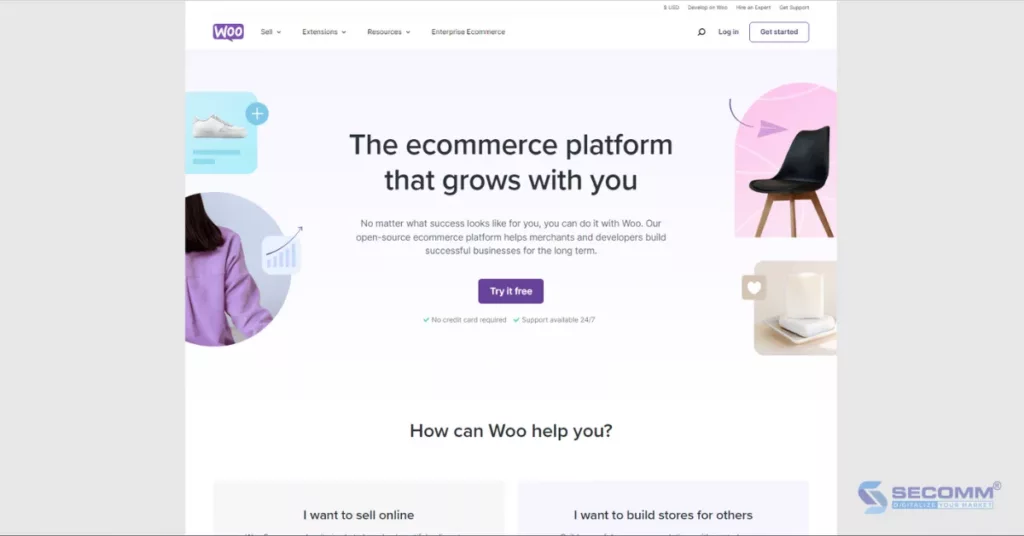
The license fee of WooCommerce depends on the complexity of each project, averaging around $1,000 for a basic eCommerce website and $10,000 for a more advanced eCommerce website.
Pros:
Cons:
Brands using WooCommerce to build online pharmacy include Dr. Scholl’s, myLAB Box, Superdrug Health Clinics, and Apothecanna.
Adobe Commerce, formerly known as Magento Commerce, is a professional and widely used eCommerce system. Adobe Commerce is part of the Adobe Experience Cloud product line and is designed to assist businesses in building eCommerce websites.
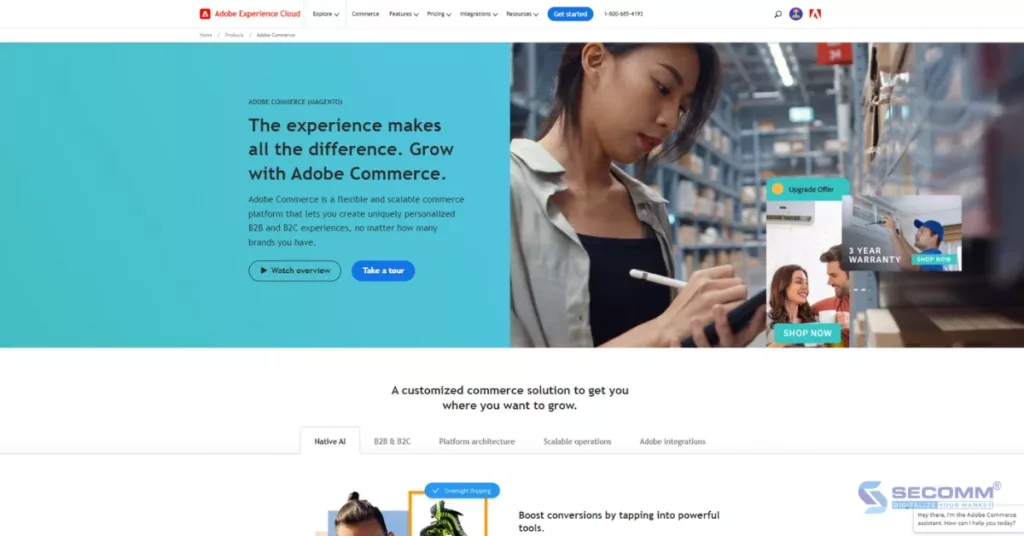
Currently, Adobe Commerce provides businesses with two main versions:
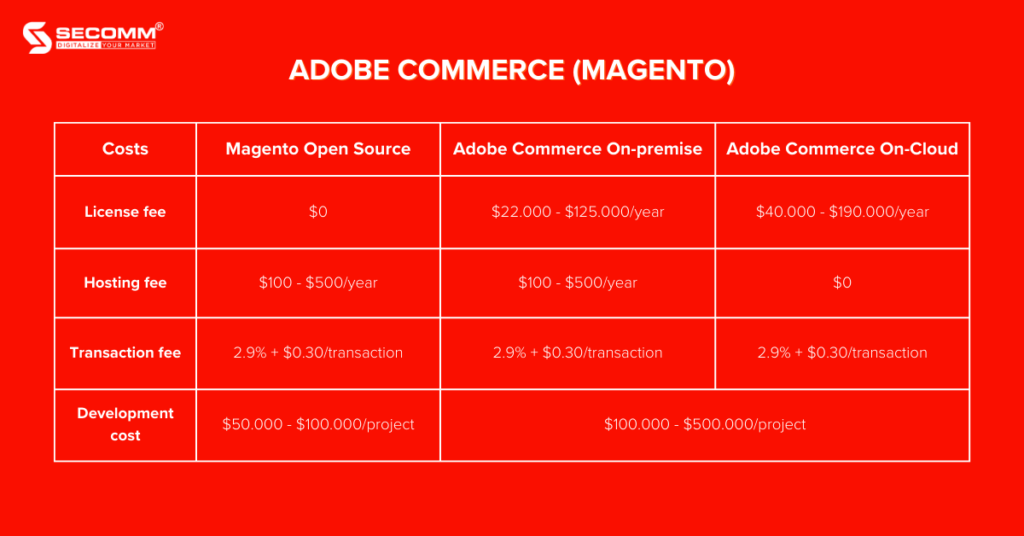
Pros:
Cons:
This list is just a few examples for businesses to reference; there are many other robust eCommerce platforms that businesses can consider based on specific needs and available resources.
With extensive experience in implementing eCommerce for clients in various countries, SECOMM understands the challenges and difficulties businesses face during the deployment of pharmaceutical eCommerce.
Contact SECOMM now or call the hotline at 02871089908 today for a free consultation.
 2
2
 8,615
8,615
 0
0
 1
1Subscribe to get the latest eBook!
Hotline